Diversion: Now (August 2024) I’ve made another trip to Bengaluru, going via Bangkok, wherein I bought a number of goodies from the Thai Airways headquarters’ gift shop — including a T-shirt, a model plane, a speaker-cum-fan, some designer fabric bags, artisan cookies and more! The outbound legs involved two CX A350s (SIN–HKG–BKK) in order to get to the restaurant at the TG headquarters in time, which closes at 2pm. However, that didn’t go according to plan, thanks to the HKG–BKK flight (CX755, usually operated by an A330-300 instead) hitting a technical snag leading to a big delay — more than enough to make me miss visiting the restaurant, though I made up for it by buying all the gifts from the shop.
As far as actually flying on Thai Airways was concerned, I was hoping for ‘revenge’ for my previous 777-200ER flights, in the form of three A350s (BKK–BLR, BLR–BKK–SIN), but ended up with even more 777-200ERs and no A350s. 😢 A certain possessive stalker called Phetchabun — HS-TJW, a 777-200ER I’d flown before and hated — had other plans for me, and brushed aside the A350s to catch me in her lair on BOTH BLR flights. (From BKK to SIN it was a 777-300ER instead: a very nice change since I’d never flown that type on TG, but still not an A350.) I’m not going to speak any further on this practice of ‘TGing’, as I’ve done so innumerable times, except that it seems that Bengaluru seems to receive the Thai Airways A350 — more than 90% of the time — only when I’m NOT in the picture!
I absolutely needed to have a TG A350 encore, and so two weeks later I flew again to BKK for a one-night weekend trip — and this time not only did I get an A350, but the cabin crew noticed my violet Thai Airways T-shirt and even handed out signed postcards. All’s well that’s ends well, I say (even though the wait for the A350 on TG326 continues)! 😊
Introduction: The revitalised Air(Asia) India Express — and Delhi after a decade
After the mega-trip at the end of 2023 involving India, Hong Kong and Vietnam, I made another trip home in February 2024, with the ‘express’ (ha!) purpose of reviewing the Air India A350 from Bengaluru to Mumbai. As a matter of fact, I’d gotten a nonstop to Bengaluru on Air India (the daytime AI393) booked earlier in February — around Chinese New Year, the biggest holiday in Singapore — but last-minute work commitments required me to push it to later in the month. Since it had been booked by my dad through MakeMyTrip, India’s homegrown Expedia, he had to contact them, and not Air India, to change the dates. Almost all the alternative dates involved the morning AI347 flight to Chennai, which I’d taken countless times before COVID, and I had no interest to visit the dysfunctional Chennai airport — (unfortunately) my home airport for two decades — again.
However, there was one itinerary that particularly caught my eye, and that was a transit via Delhi featuring the redeye AI383 — the same no-frills A320neo that operates almost all of AI’s Singapore routes, save for the AI380/381 morning Delhi service on the 787-8 — followed by an Air India Express (ex-AirAsia India) A320 to BLR in the morning, marketed as AI9751 but actually I5740. Needless to say, this is what I booked, and getting leave approval from work was straightforward. Now, I was by no means looking forward to a cramped A320neo at a miserable time of night — my longest-ever flight at the time (beaten in July by two Emirates A380s between Dubai and Singapore) — but the prospect of visiting Delhi after NINE long years (the last was in 2015) was too good to resist, along with the head-to-toe transformation of Air India Express.
Indeed, the inbound was an honestly terrible Air India A320neo redeye from Singapore to Delhi, which showed absolutely nothing by way of product improvement by the Tatas, with woeful legroom on a cramped narrowbody — I won’t be reviewing it right yet; you’ll have to wait a bit. For that matter, Indira Gandhi International was not too great either: DEL T3 was only just okay, in my opinion, and I was somewhat let down by its plain architecture and drab design, having been bowled over by Mumbai and Bengaluru’s T2s. For what is now the world’s 10th-busiest airport, way too far ahead of the much nicer second-placed Chhatrapati Shivaji Maharaj (BOM) at Mumbai in Indian airports’ passenger traffic rankings, DEL’s aesthetics and décor left a whole lot to be desired.* In the past I’d say that BLR T2 is ‘right up there with DEL T3 and BOM T2’ among India’s best airports, but now I can safely remove DEL from that illustrious list.
*In 2025 both Delhi and Mumbai are getting new airports, which are located a long way southeast of the city centre: Noida International (DXN), managed by Flughafen Zürich AG, and Navi Mumbai International (NMI), managed by the same Adani group that runs Mumbai’s existing CSMIA (BOM) airport. Both are set to have eye-catchingly glamorous buildings, drastically enhancing Indian travel — and, in the case of NMI, will greatly alleviate the load on BOM, which is heavily constrained. DEL, for the record, is operated by GMR Group, which also runs the Hyderabad (HYD) and brand-new North Goa (GOX) airports.
Just HOW GOOD can an Indian low-cost carrier be?!
However, the heavily revamped Air India Express (IX) — with the ‘bones’ and fleet of the erstwhile AirAsia India (I5), which it replaced during a big rebranding event in 2023 — more than delighted with its older A320 from Delhi to Bengaluru, the focus of this report. Indeed it puts IndiGo (6E), the country’s largest airline, to shame in so many areas, from catering to IFE to leather seats! Honestly, I was bowled over by this low-cost carrier’s transformation after being relaunched by the Tata Group on 18 October 2023, merging the feature-rich but struggling AirAsia India — operating A320s, and only on domestic Indian routes — with the profitable but highly route-restricted Air India Express that operated only 737-800s from Southern Indian states to the Gulf countries and Singapore. (AIX is only just starting to expand its international network beyond the Gulf and Singapore, with Dhaka being the first, from September 2024.)
I’d flown AirAsia India in its previous incarnation — officially called AIX Connect — in December 2022, and was already mighty impressed by what the then-I5 had been doing with regard to its onboard product, even on a short 40-minute hop from Chennai to Bengaluru with not much catering. With a rebranded focus and new direction, the rejuvenated Air India Express has finally begun to take the fight to the monolithic goliath that is IndiGo — though it’s still a long way from having a consistent fleet structure, with the legacy 737-800s still having the old livery designs (beautiful as they are, and unique to each aircraft) and the A320s faring much worse with their blank red liveries. However, another step is being taken in the direction of harmonisation, as the I5 flight code — which has been used for a year well after the retirement of the AirAsia India brand — will be retired and replaced by IX from October 2024.
For comparison, it’s only now, on its 18th birthday in August 2024, that IndiGo finally opted to introduce a true business-class product — confusingly dubbed IndiGo Stretch (as if this were an extra-legroom economy product) — with reclining seats featuring in-seat charging, among other frills (but still no ovens!). But AIX, and AirAsia India before it, is LEAGUES ahead of the IndiGo that has historically offered little beyond a limited selection of snacks on almost its entire network, barring the Istanbul flights operated by 777-300ERs leased from Turkish Airlines. With ‘Gourmair’-branded hot meals and leather seats, both unheard of on 6E — not to mention AirFlix streaming entertainment, which 6E has only just started to introduce (and only on the Delhi–Goa route for now) — the AIX experience is leaps and bounds ahead of what IndiGo has offered up until 2024.
This is my best shot of VT-ATD, at the the time the only A320neo (or, indeed, non-737 MAX) to feature the new AIX livery — though in the meantime sister-ship VT-ATJ has also been painted with it, but not any other existing A320 or 737-800. More often than not, VT-ATD spends its resting time at Bengaluru, making it easy for locals at BLR to spot.
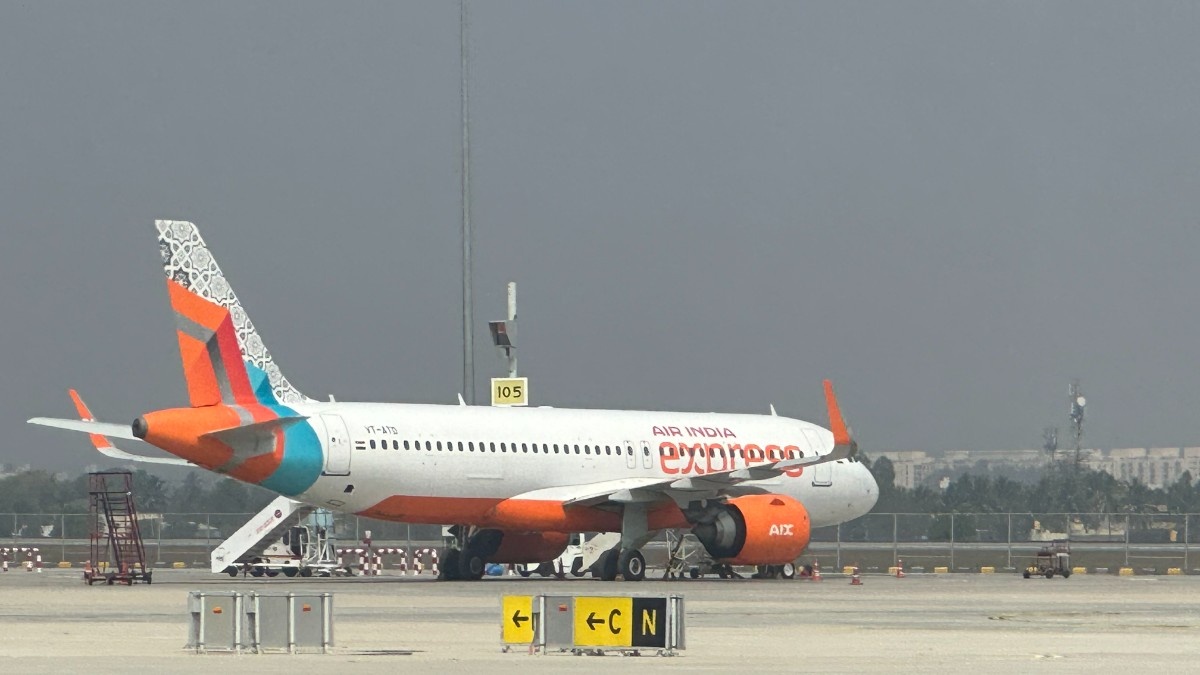
Fleet overview: With the subsuming of AirAsia India into the legacy Air India Express, the combined airline took delivery of a raft of 737 MAX 8s that were originally intended for Mainland Chinese airlines like Air China, Shenzhen Airlines, Shandong Airlines and Xiamen Air. As a result, the AIX fleet now consists of three types of aircraft:
(a) the then-AirAsia India’s A320s, mostly non-sharkletted A320ceos but also a few sharkletted ones. There are also a few A320neos: VT-ATD, ATE, ATG, ATH and ATJ, of which the first and last are painted in the new Air India Express livery — indeed, the only non-737 MAX aircraft to feature it. Most A320s are registered after cities’ airport codes, both Indian and Asian, with the one operating my flight being registered VT-HKG — but some, including the above A320neos, use the VT-AT* series instead. (Sadly, all A320s barring VT-ATD and ATJ are in a blank red livery stripped of the AirAsia titles.)
(b) the legacy Air India Express 737-800s (VT-AX*, AY* and GH* series), which have different aspects of Indian culture and heritage on their tails, with the left and right sides being different. None of these have yet been repainted into the new AIX livery, and they still predominantly fly from the Southern states of Kerala and Tamil Nadu to the Gulf countries and Singapore, respectively.
© the newly inducted 737 MAX 8s (VT-BX* and later VT-BW* series) that were intended for Chinese airlines, and feature the new AIX livery with a unique Indian ethnic pattern on each aircraft’s tail. These are mostly used domestically, but also fly on some international routes.
Note: I’ll publish these reports out of chronological order: this Air India Express (ex-AirAsia India) A320 review first, followed by the Singapore Airlines A350 from Mumbai by end-August 2024, and the woeful Air India A320neo from Singapore in September, and finally the full, picture-packed review of the Air India A350 — expanded from the shorter review that was published on 29 February.
Flight routing
- 1AI383 | Singapore to Delhi | 20 February 2024 | A320neo | VT-CIP
- 2I5740 | Delhi to Bengaluru | 21 February 2024 | A320 | VT-HKG
- 3AI589 | Bengaluru to Mumbai | 25 February 2024 | A350-900 | VT-JRB (partial report published; full report coming later)
- 4SQ421 | Mumbai to Singapore | 25 February 2024 | A350-900 | 9V-SHL
Visiting India’s largest, busiest airport after 9 years — not great, not horrible either
Wednesday, 21 February, 3am. I was initially quite excited to visit DEL — the world’s 10th-busiest airport, and the premier aviation hub of India — for the first time since 2015. However, I must say that looks-wise, DEL T3 was a little bit disappointing compared to the wondrous marvels of architecture that are BOM T2 and BLR T2, which I rank to be among the finest airports I’ve ever visited — not far behind Changi and HKG.
Having just stepped off an AWFUL, cramped Air India A320neo redeye at a wretched time — which came to rest next to an exotic ITA Airways A330-900neo — I was certainly hoping for a lot from DEL T3, which opened in July 2010, some months before the Indian capital hosted the Commonwealth Games. I’d never seen it before other than the pictures of mudras (hand gestures) in the arrival hall, but on entering the Immigration and baggage-belt area I came to the conclusion that I’d been a victim of my high expectations! The white ceilings struck me as terribly drab, with none of the opulence and grandeur that BOM and BLR have in their Terminal 2s. Only the art and tourism wallpapers managed to drive home the fact that DEL remains the biggest gateway to the country, and definitely so to its northern part.
That said, there’s one aspect where Delhi is unquestionably ahead of anywhere else in South Asia, with only Mumbai coming close. That’s the destination network, ranging from Rome (FCO) on ITA Airways — it does not (yet) serve Mumbai — to Helsinki on Finnair, to Almaty on Air Astana, to Moscow (SVO) on Aeroflot*, besides several Gulf carriers including Gulf Air, Kuwait Airways, Jazeera and flynas. Three in the morning really is peak hour for Indian international flights!
(*India has very much remained a friendly country for Russia throughout the invasion of Ukraine — despite Prime Minister Modi also visiting Kyiv and Warsaw in August 2024, which shows that India does not really lean on one side or the other during such world conflicts.)
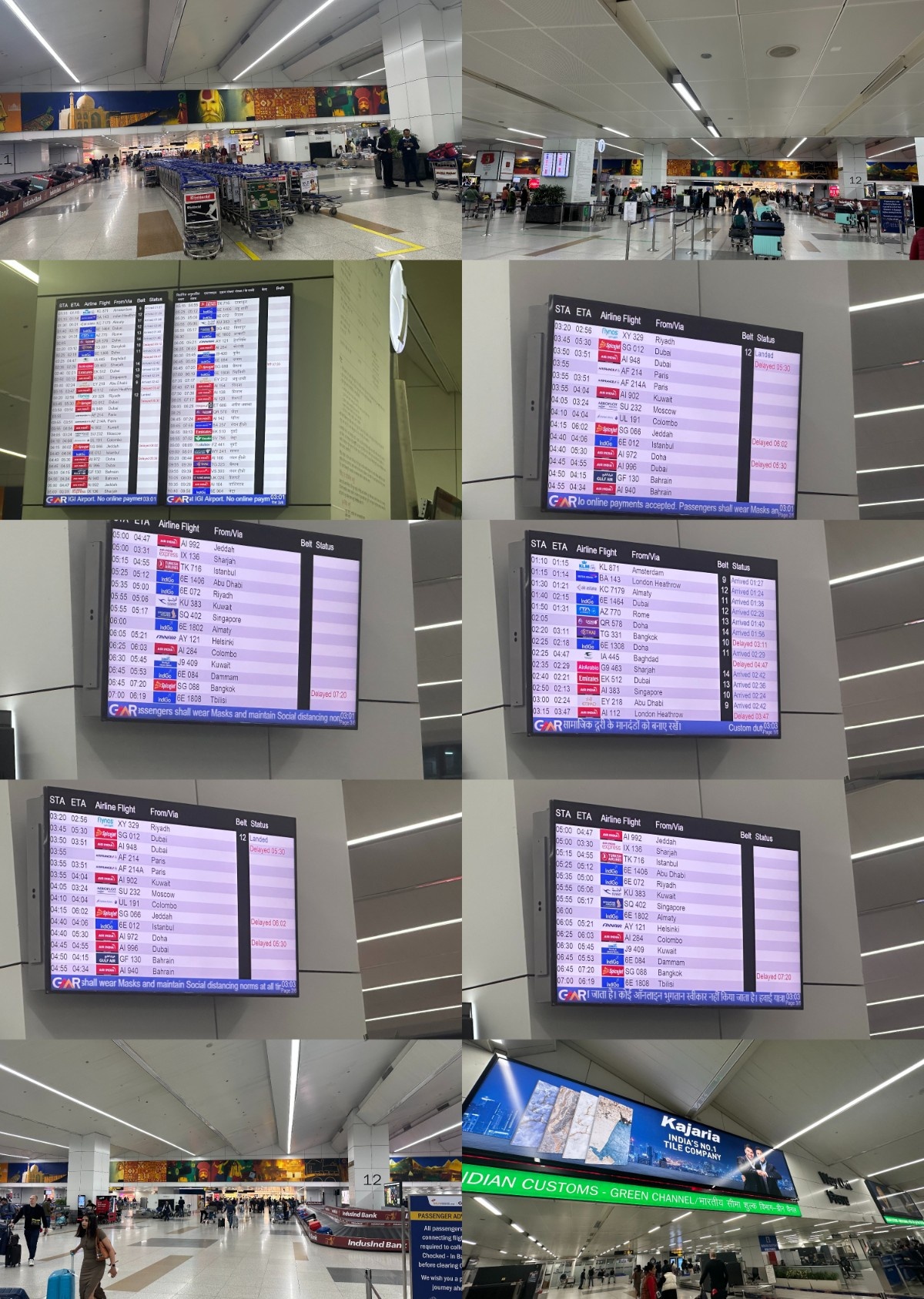
Here’s a picture of my previous AI plane, VT-CIP, which was honestly one of the worst A320s I’ve ever flown in terms of seat — even IndiGo’s are better, as my caption showed. I’d written some captions in part-Hindi, part-English, translated as follows:
(i) Bro, I didn’t at all think this plane was in any way different from the old sarkari (government-owned) Air India… (and so on in English)
(ii) If I didn’t steal this magazine from the first row of economy, I wouldn’t have seen it at all. Pro move!
(Indeed, none of the other economy passengers got to see the new Namaste.AI magazine at all, which was a real shame as this was one of the very first issues with the new Air India logo and branding.)
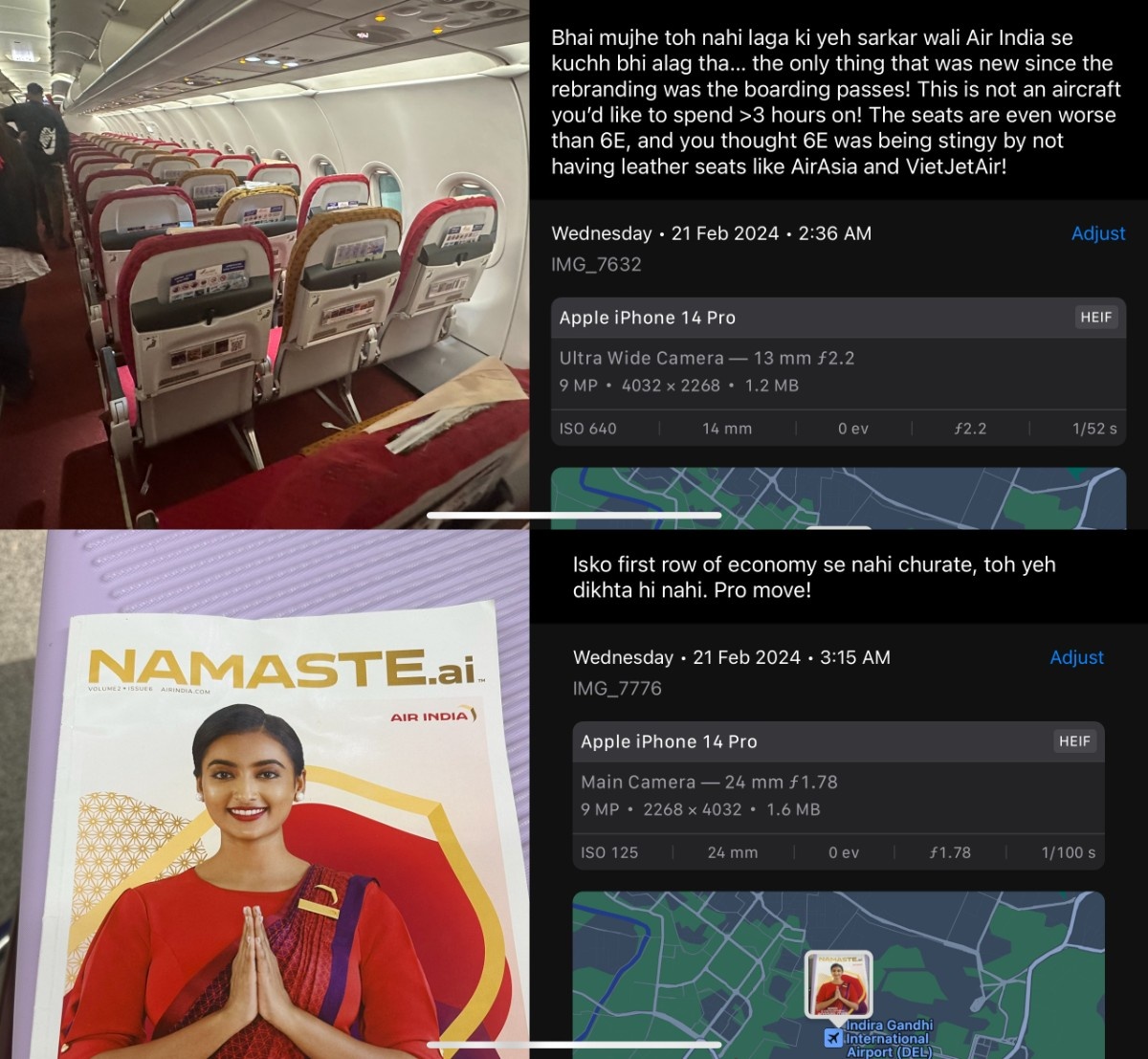
As I wheeled my luggage outside the arrivals hall and to the domestic transfers area, I had a look at the radiant girl in resplendent attire, hands folded in (what else) a namaste. This, folks, is how an inflight magazine cover is done — shot of involving a Western airline and/or publishing agency (most notably Ink Global)!
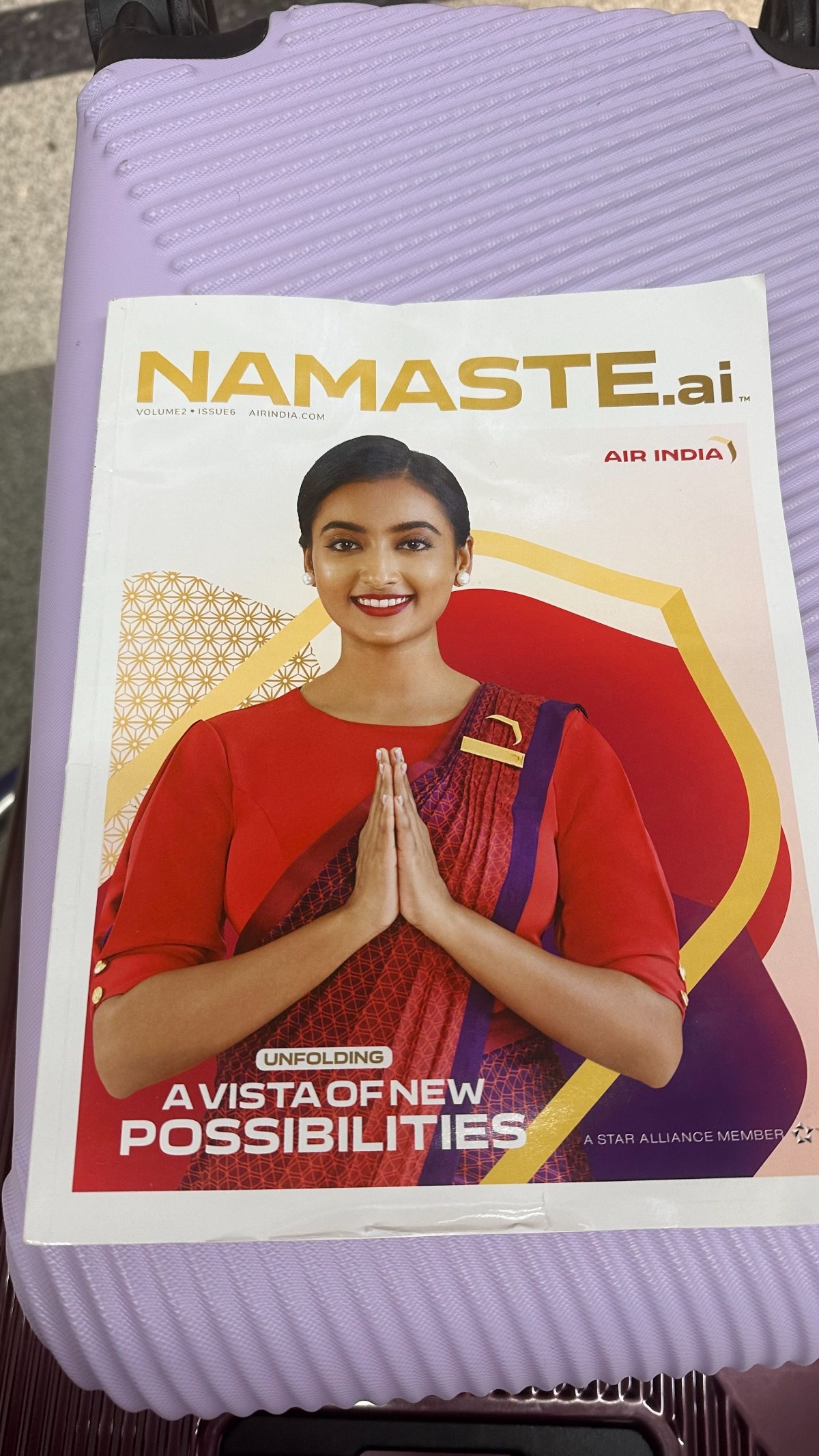
I wheeled bag and baggage to a WHSmith bookshop, a standard feature at every major Indian airport — with the glaring exception of my former home of Chennai, which has never had a WHSmith or Relay. (Another reason to hate that horrible, government-run airport.) There I bought a couple of juices and took a few moments to recoup and regather myself.
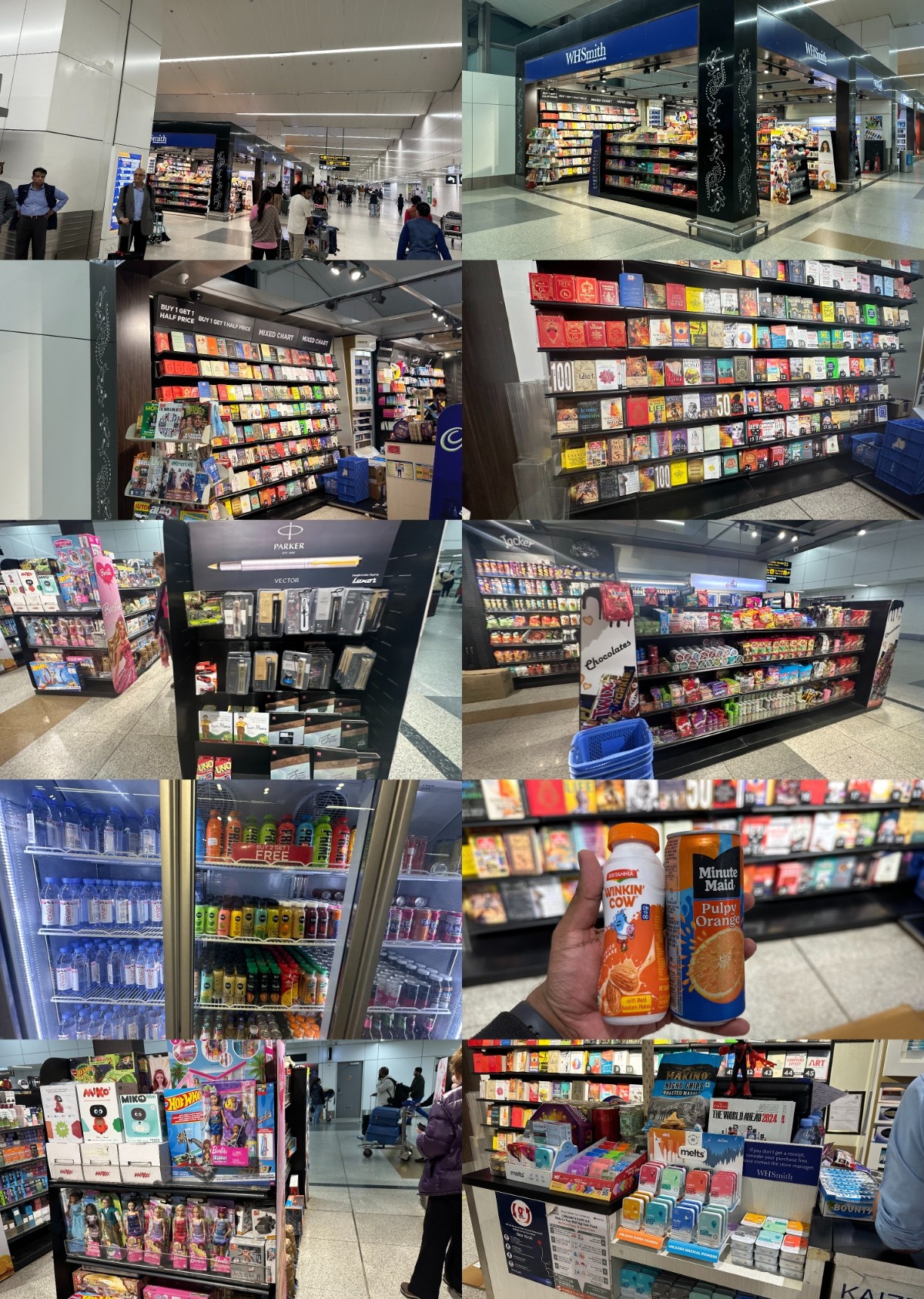
I proceeded to the domestic transfers area, bypassing the famed Karachi Bakery — nothing to do with the Pakistani commercial capital; this one’s from Hyderabad — and the Encalm contract lounge.
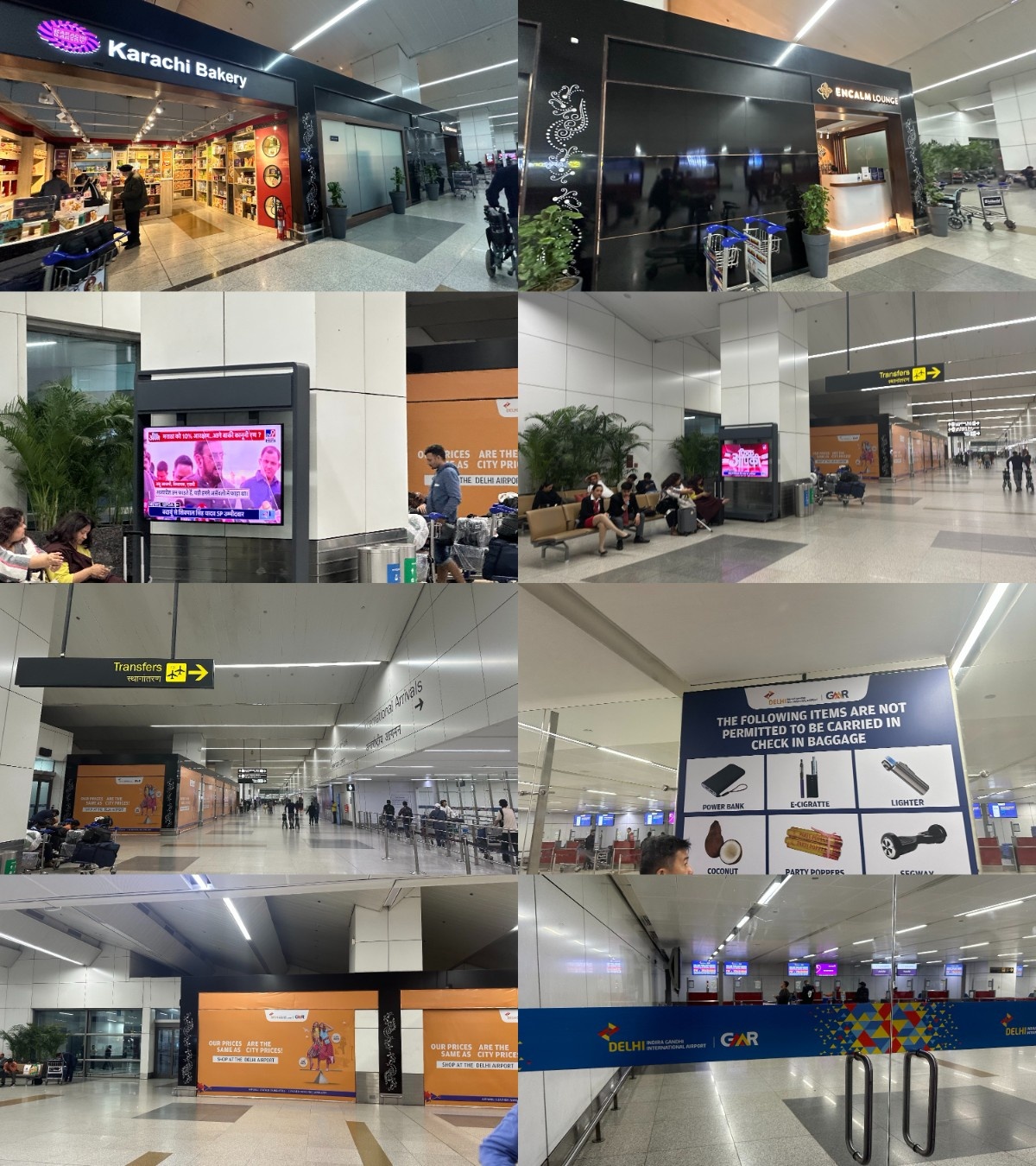
IGIA T3 Departures: Saying hello to the new Air India Express
The domestic transfers room was on the smaller side, with the usual suspects (Vistara and AI) displaying prominent banners on the LED screens. I took the lift up to the departure floor, where throngs of people were already milling around, given the high volume of international departures at this hour.
Truth be told, this place had none of the distinctiveness of the blue square numerals at BOM T2, or the ornate wooden chandeliers at BLR T2, or any terminal at Changi. Indeed DEL T3 was as dull-as-dishwater as a major global aviation hub can be, though thankfully not as awful and ugly as Bangkok Suvarnabhumi.

It was here that I encountered the new Air India Express branding at the country’s foremost aviation hub. Honestly, I was very impressed indeed by its total transformation from a humdrum airline overwhelmingly flying 737-800s between Kerala in the south — Kozhikode (CCJ) in particular — and Bahrain/Doha/Jeddah/Kuwait/Muscat/Sharjah (with a bit of Tamil Nadu to Singapore, plus some North Indian cities to DXB/SHJ), to a major low-cost force to reckon with both within India and abroad, featuring bright and sprightly new colours and a bespoke font.
With the new orange-and-turquoise colour scheme and the smart, snappy ‘Connector’ shapes, the brand image of the new AIX is far more consistent and cheerful than the complete non-existent identity of the previous one. The only thing I’d change about the new branding is the usage of the maddening Montserrat font, which was presumably picked as a ‘go-to default choice’ here to fill up the body text — but AIX would really have been much better off without it, given how irritatingly overused it is. (Just look at Saudia, which had rebranded only a few weeks before AIX, and implemented a strikingly sharp customised font to go with it — no Google Fonts!)
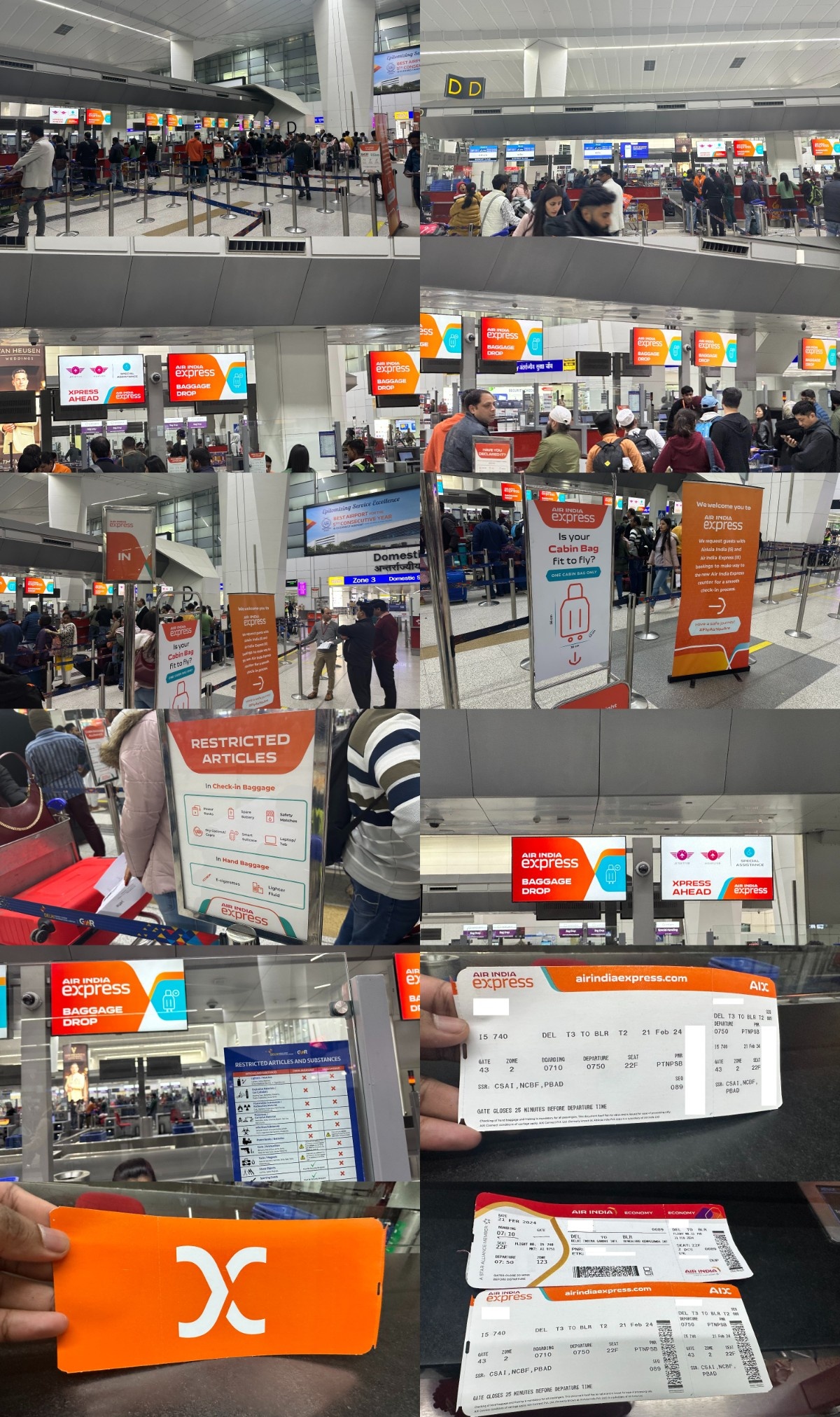
As you can see above, the boarding passes of Air India and Air India Express made for a nice juxtaposition with each other — in fact, they were both for the same flight! (Air India-branded passes for both legs, SIN–DEL and DEL–BLR, were issued at Changi, while an AIX-branded pass was issued here at DEL.)
Meanwhile, RA-73152, one of seven Aeroflot A350s (RA-73151–57), had just landed. After sanctions prohibited the delivery of any more Western aircraft to Russia, six intended-for-Aeroflot A350s were delivered to Air India (VT-JRA/B/E/F/H/I) in 2023–24 — I managed to catch VT-JRB a few days later — over a year after four more went to Turkish Airlines (TC-LGI–LGL) in 2022, along with another (EC-NOI) to Spanish charter airline World2fly.
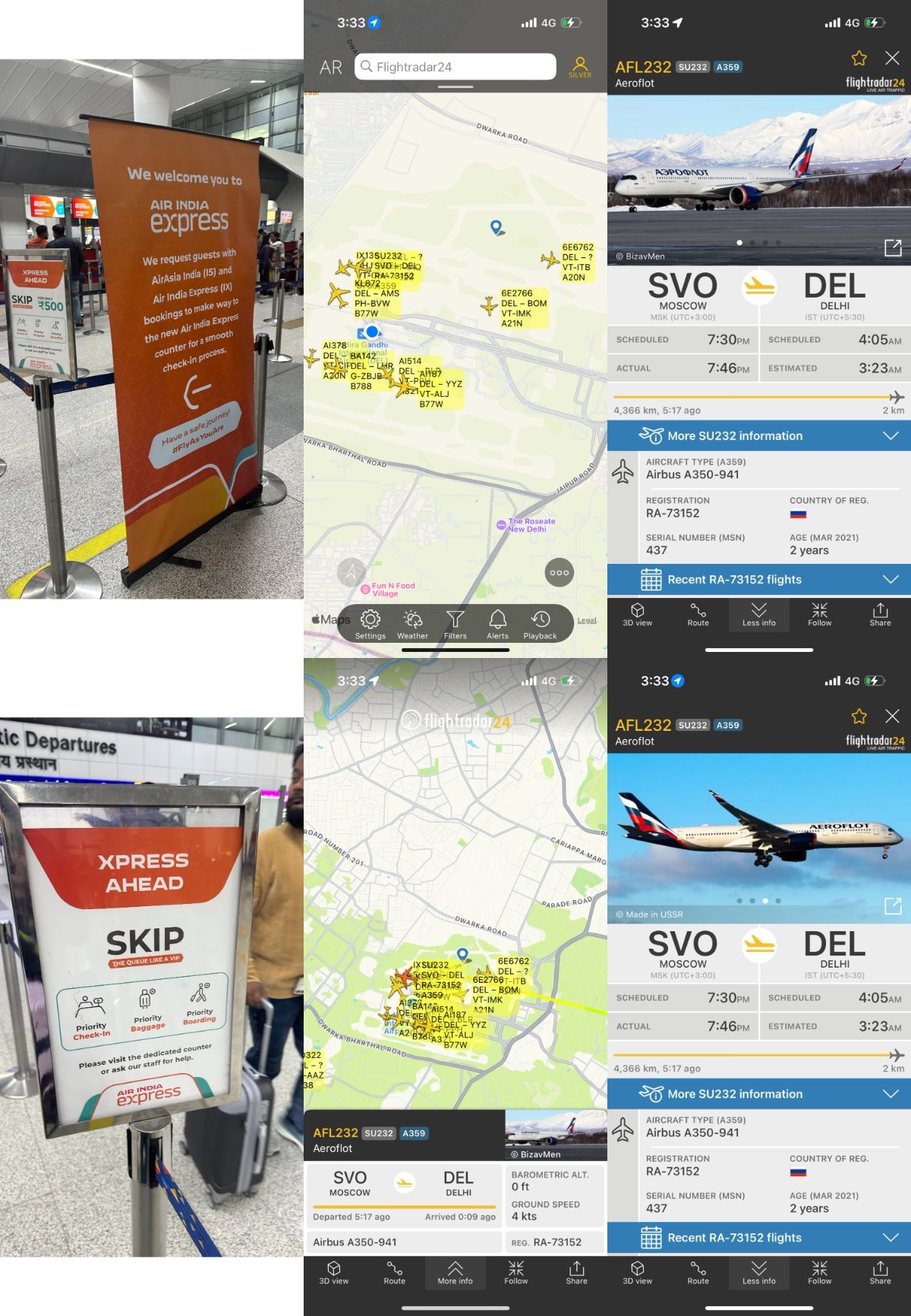
Check-in and bag-drop done, I moved on to the domestic departures — it was 4 in the morning now — after paying a brief visit to the restrooms, which were gender-marked (rather uniquely, I say) by a man and woman in traditional Indian attire.
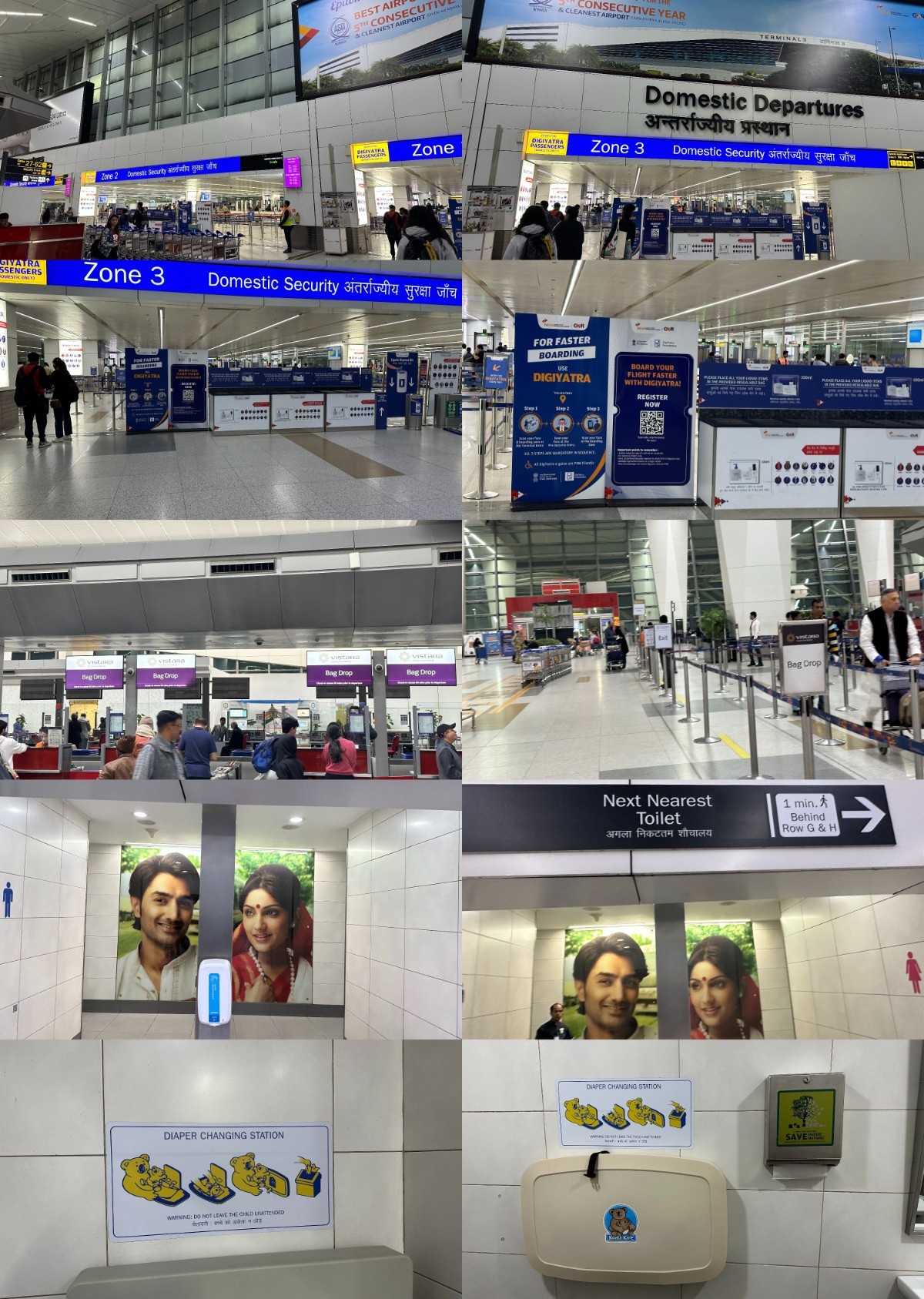
There were of course a number of ads for DigiYatra, which somehow I still haven’t come around to registering for. But I’m afraid the security lines were PAINFULLY slow, helped in no way by the fact that the officials were very incompetent indeed — and there was always a scarcity of boxes to place your items in. This despite a whole stack of them lying in a corner! Already DEL T3 was doing itself no favours with regard to aesthetics, and this soured the process all the more.
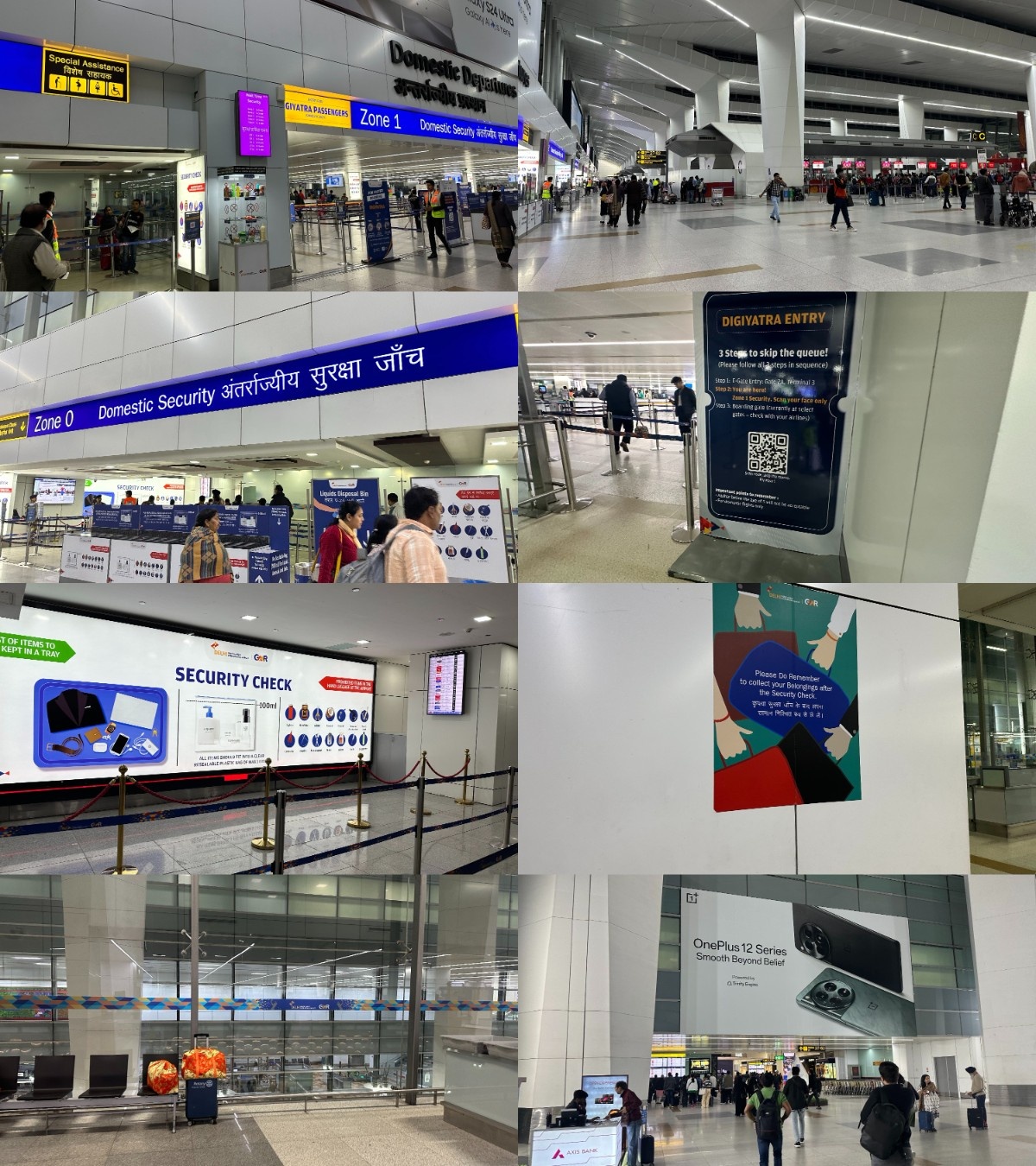
On another note, I was amazed at the sheer number of codeshares for all these Indian domestic flights — and JAL in particular, since its logo was so easily noticeable — so much so that the actual operating airline for some of these flights was often hard to spot amid all the codeshares.
(The Oneworld member had a codeshare with Vistara at the time, covering the flights shown below, but in mid-2024 it also launched a partnership with IndiGo — becoming the sixth member of this alliance that India’s largest airline has partnered with, the others being American, BA, Qatar, Qantas and Malaysia Airlines! But I do not, at all, think IndiGo should lean towards joining any alliance — Oneworld or otherwise — in the near future, as that would break from its low-cost roots.)
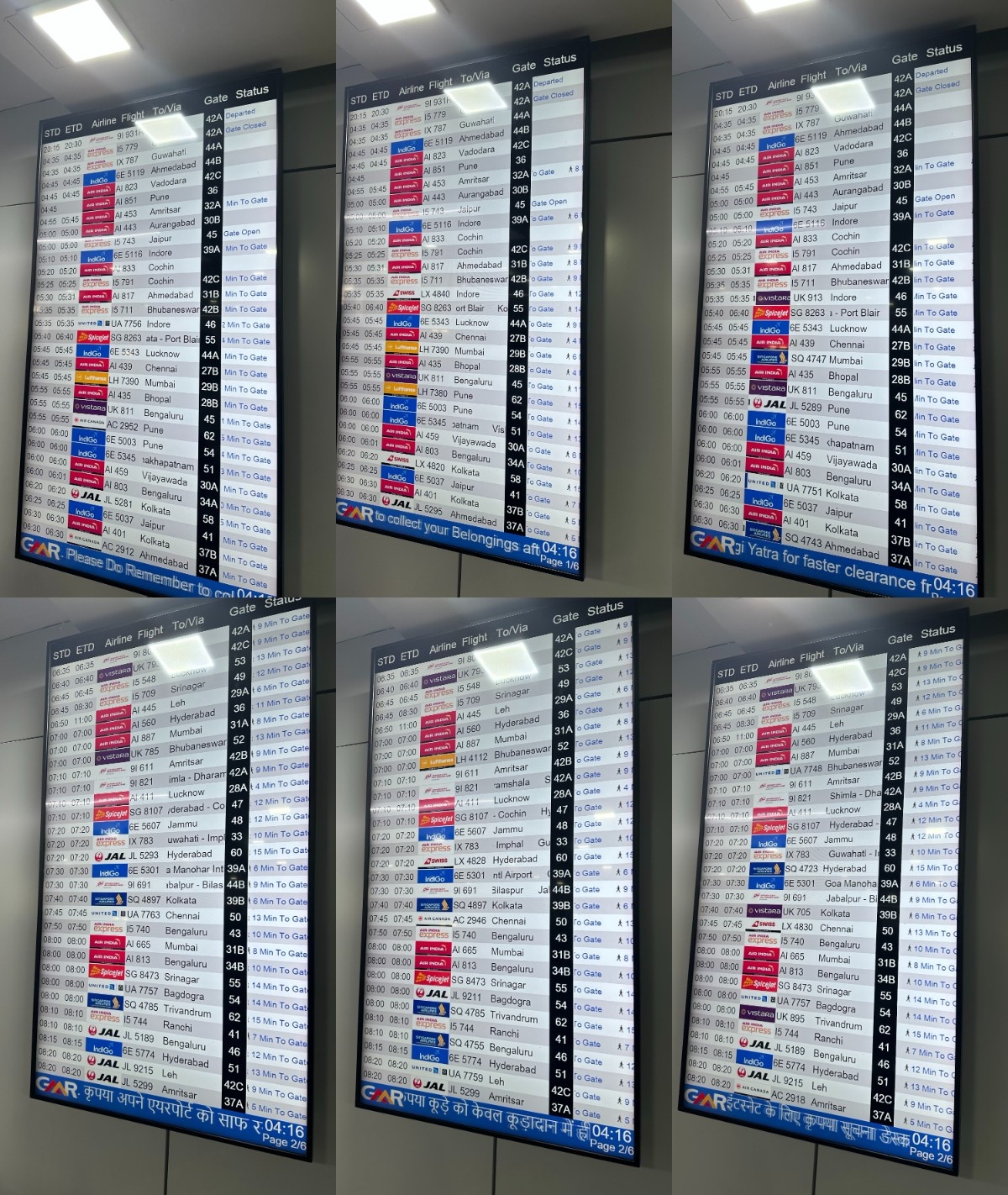
My captions summed it all up: the country’s largest, busiest airport was certainly not among my favourites so far, at least before security — though after security was a refreshingly different story. (Translation of the very sarcastic second caption: There’s too much JAL visible, way over the limit… Is this Haneda? Then where are ANA, Peach, Jetstar?)

DEL T3 Domestic Departures: Retail and Restaurants (especially Tim Hortons)
The security sh*tshow aside, I now turned to the Domestic Departures area. This being my first time at DEL T3, the décor of the place struck me as particularly drab and uninspiring — all the more a contrast compared to the opulence and regalia that BOM and BLR have in their T2s’ domestic areas, not to mention the international ones (where I don’t think DEL excels all that much either)…
The brands, at least, were name-brand luxury marques like Brooks Brothers, Tumi — which now partners with Air India for its new amenity kits — and Porsche Design. GMR, the airport operator, also did a good job of advertising amenities like the Encalm Lounge & Spa, as well as the ‘magical’ DigiYatra system, speaking of which… What’s stopping me from signing up for it?!
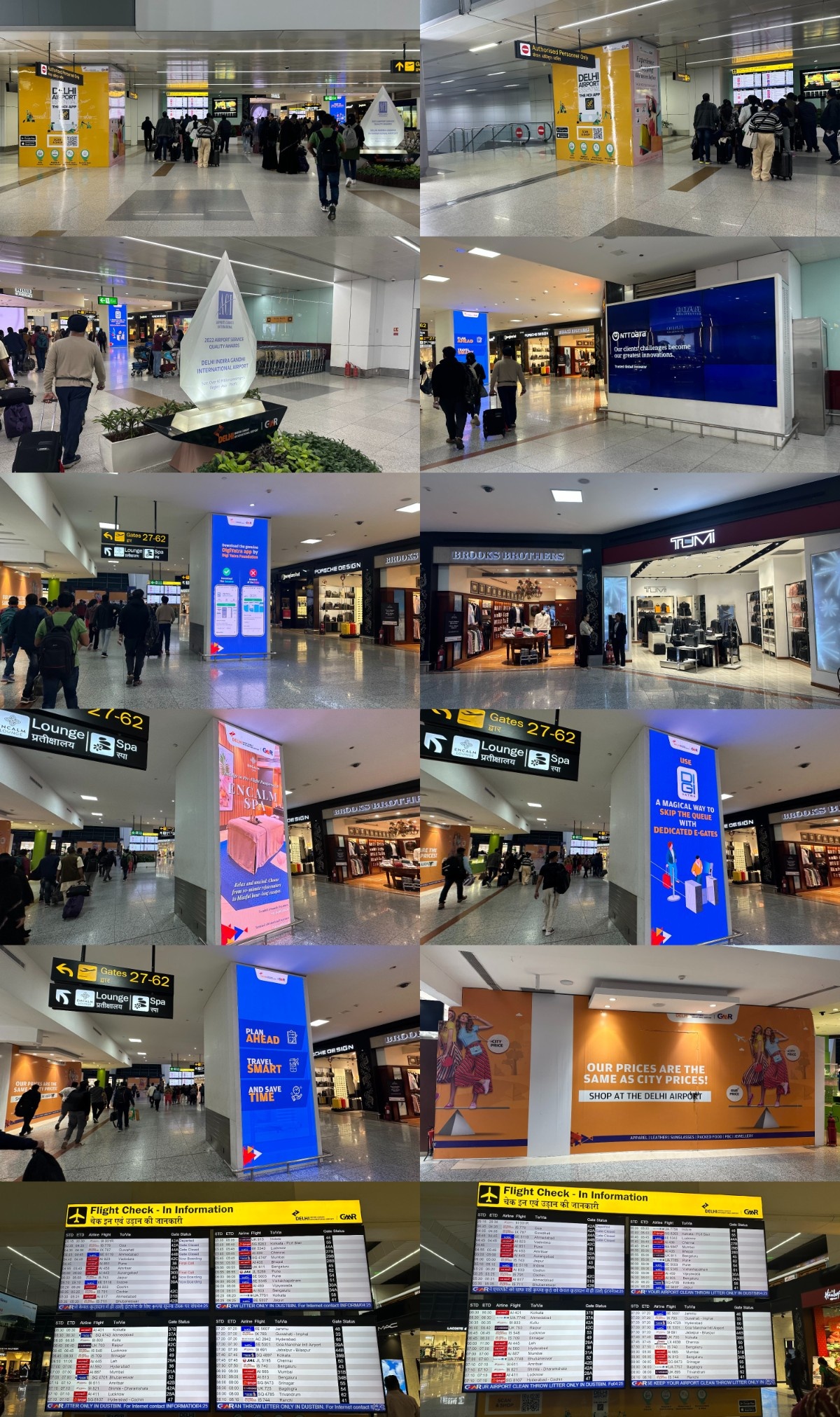
A left turn later, a wide range of standard-for-Indian-(private-)airport stores came up, with the Air India lounge — still with the old logo — lying above. These ranged from international brands like The Body Shop, MAC, M&S, Swarovski and the Hamleys toy store — though this is now in Indian hands, more precisely Mukesh Ambani (Asia’s richest man)’s Reliance Industries — to homegrown Indian ones.
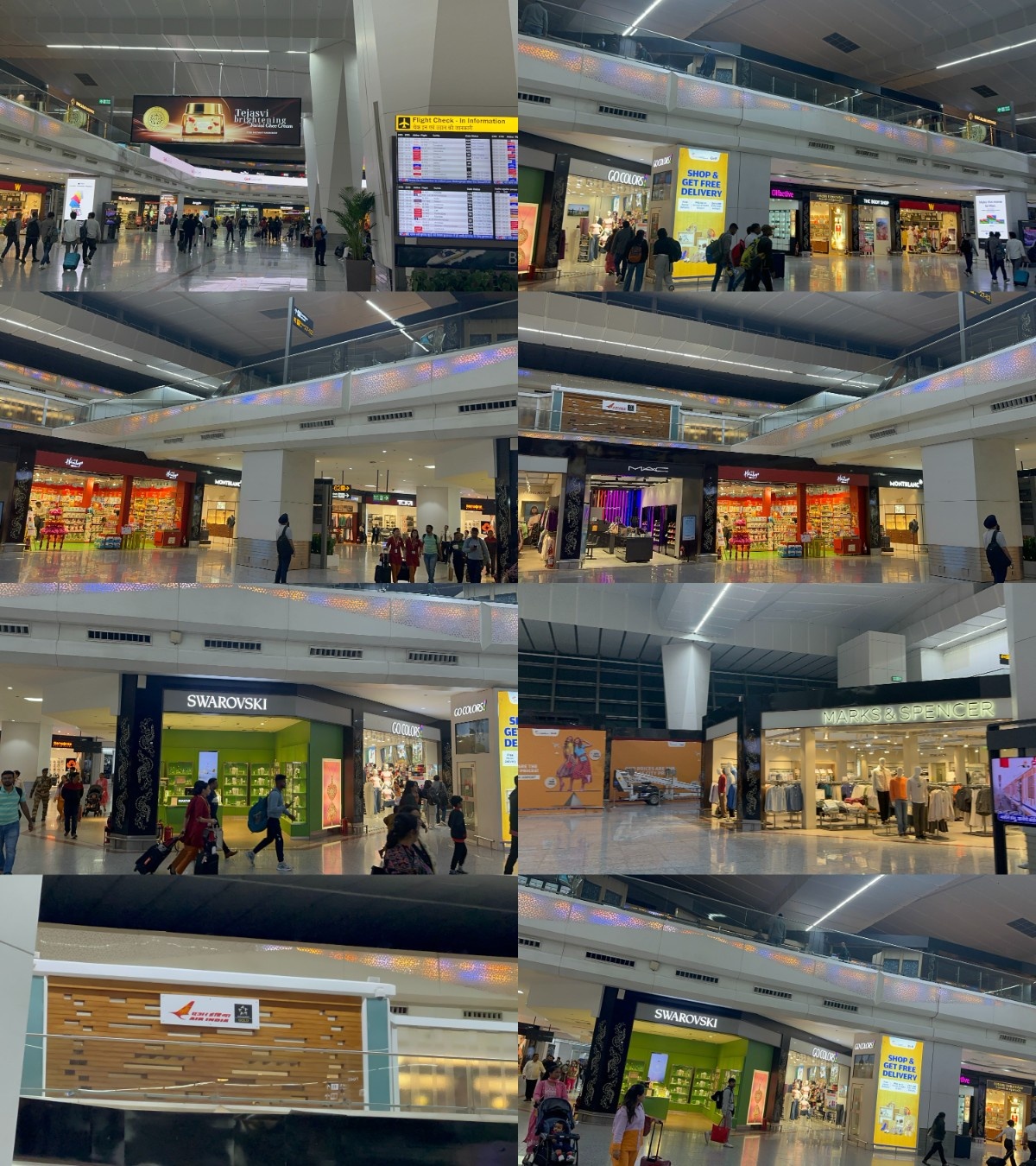
Among those was Go Colors!, a women’s loungewear brand, and I could not resist snapping away at the cheery girls in their comfy wintry wear — as I’m wont to do where Indian girls in ads are concerned!

On the banners above, GMR Airports was displaying the rasas (emotions) of traditional Indian art and culture. Shown here are shringar rasa (love) and bibhatsa rasa (disgust).
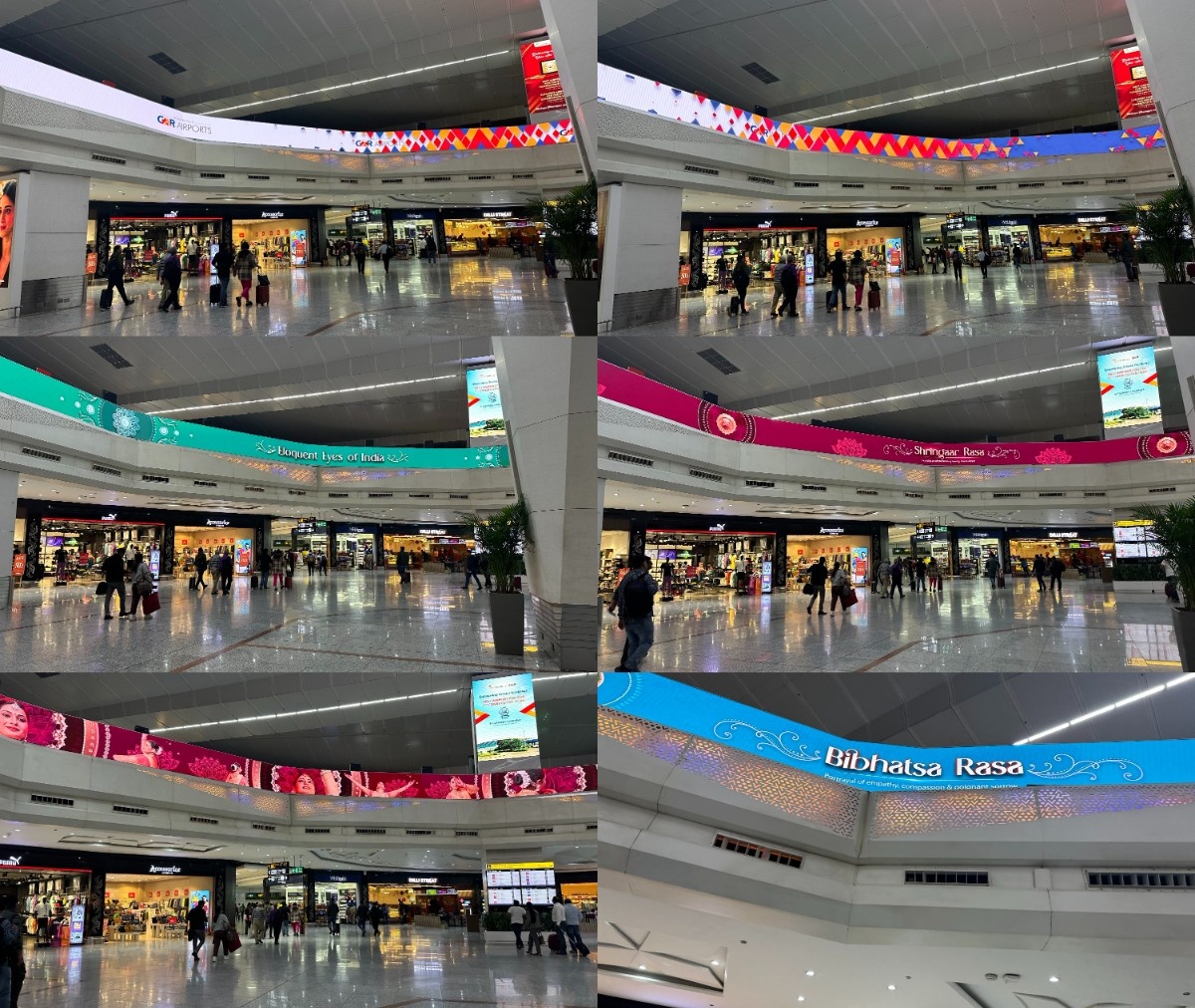
I had a peep into Dilli Streat, a chaat (Indian roadside snacks) store, and Haldiram’s, the century-old world-famous purveyor of Indian sweet treats — with another one being Bikanervala.
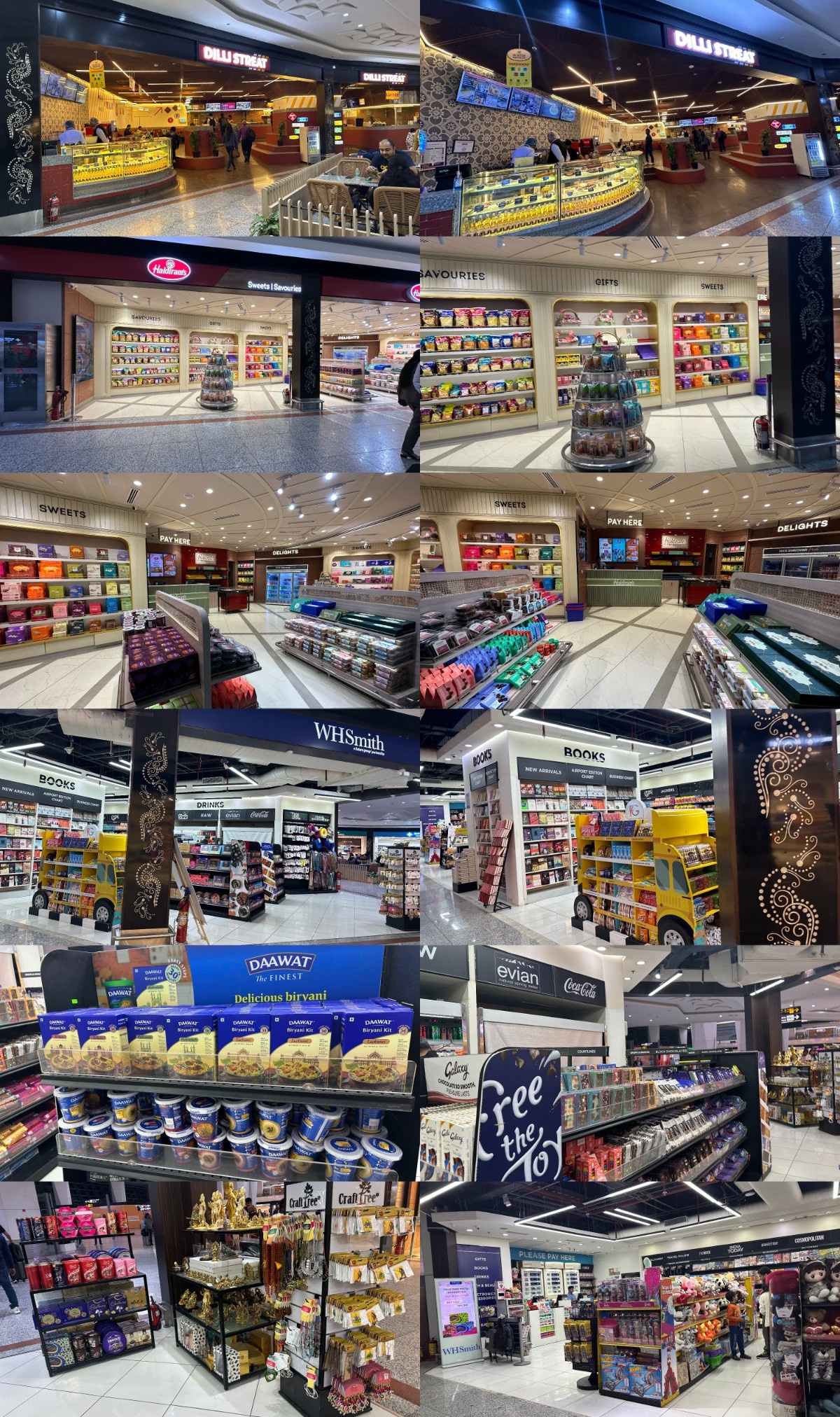
Proceeding further left, the space opened out into a wide corridor with more F&B options, plus a Birkenstock store which was showing off its footwear collection at the Lakmé India Fashion Week. There was also an installation for real-estate developer Bhutani Infra (no, no relation to the Kingdom of Bhutan!), which mostly operates in the satellite city of Noida to Delhi’s east, in Uttar Pradesh state. That’s where the new Noida International Airport (DXN), in the village of Jewar — a whopping 72 km from this, the existing IGI airport (DEL) — will open in 2025.
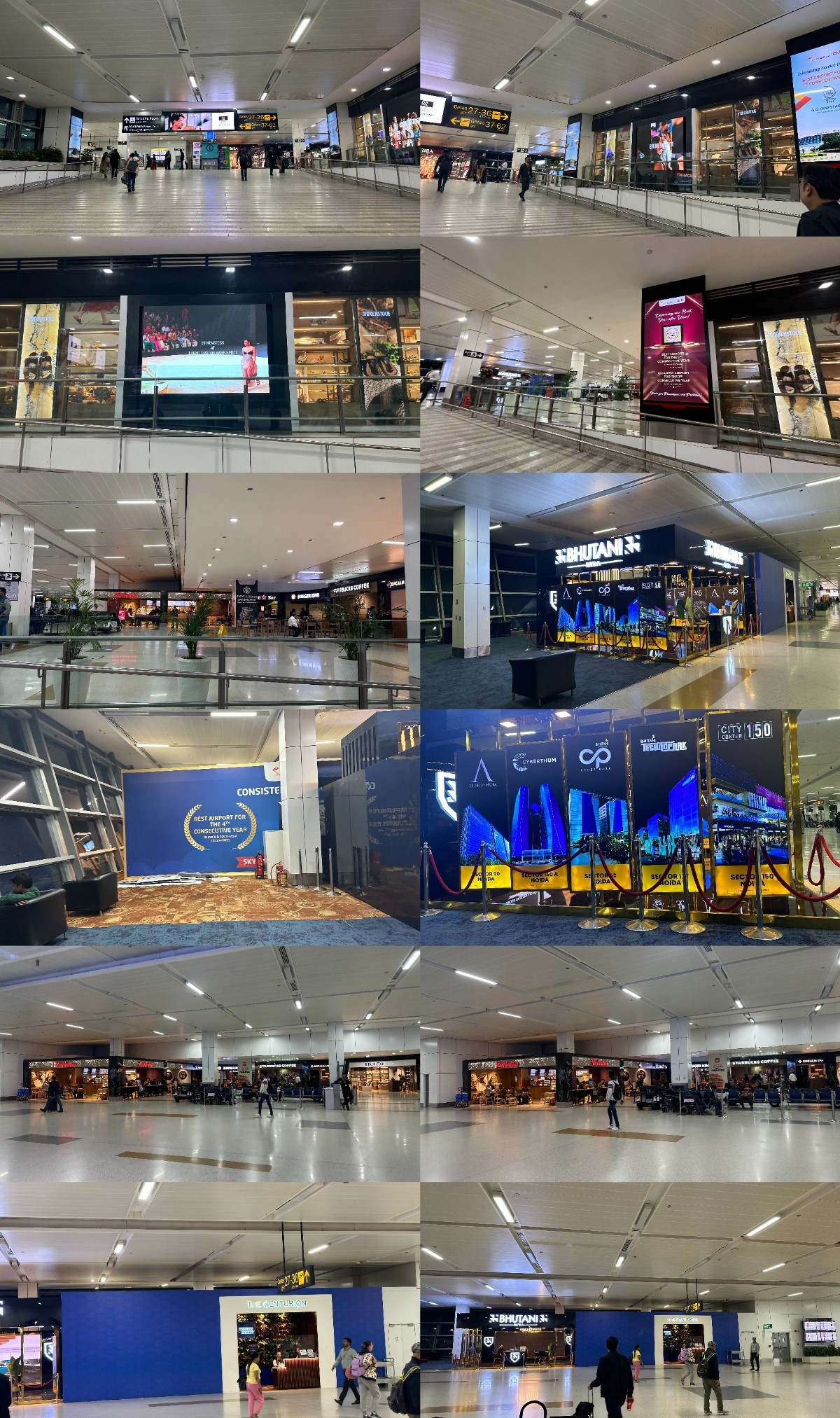
Outside the window stood a very special jet: VT-ATV, a Vistara A320neo in a pseudo-retro ‘Tata–SIA Airlines’ livery. This is a nod to Tata Air Lines, the predecessor of Air India in the 1930s and 40s, as well as the part-ownership by Singapore Airlines (hence the SIA) of Vistara. Now that Air India is in Tata hands again, only time will tell what will happen to this sexy bird when Vistara disappears into Air India and SQ transfers its stake from Vistara to AI!
Also seen here: VT-RTJ, one of AI’s newest A320neos, but still in the old livery — because it’s part of 20 A320neos that will eventually head to Air India Express. VT-RTN is the first A320neo to sport the new AI colours, and VT-RIO (not RTO) the second. Moreover, VT-RTW and RTZ — also in the old livery — are the first to have AI’s new A320neo-specific cabin products, with streaming IFE (a first for AI!).
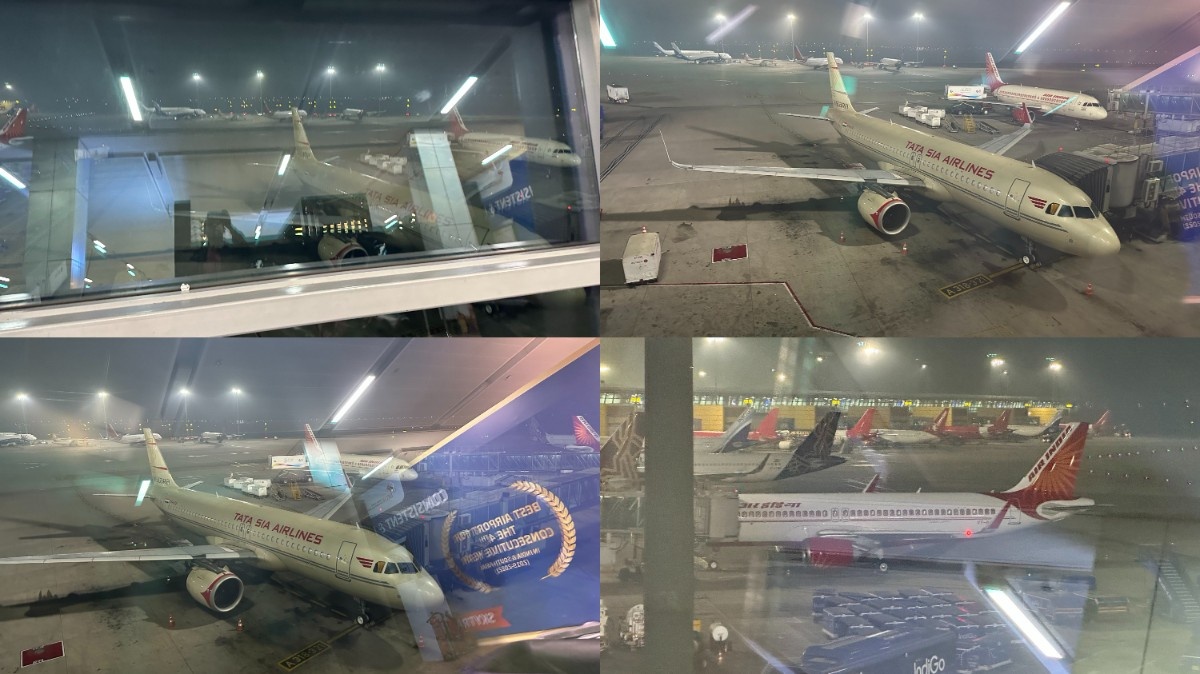
Here were some of the arrivals at that hour of night, including A9C-XD, a Gulf Air A321neo. Don’t let that X in the registration make you think of the A321XLR (which enters service with Iberia in late 2024) — these A321neos are actually not that great! The A9C-X* series of Gulf Air A321neos are higher-density with no seatback IFE in economy, compared to the slightly older and better A9C-N* series with seatback IFE in both classes.
Some others included 4R-ANA, one of only two SriLankan A320neos, and the standard Gulf arrivals like Emirates, Etihad and flynas. I had a look at my own upcoming A320, VT-HKG — which registration brought back fond memories of my tour of HKG’s magnificent spotting facilities two months before (December 2023) — while my preceding A320neo, VT-CIP, was now headed for Phuket.
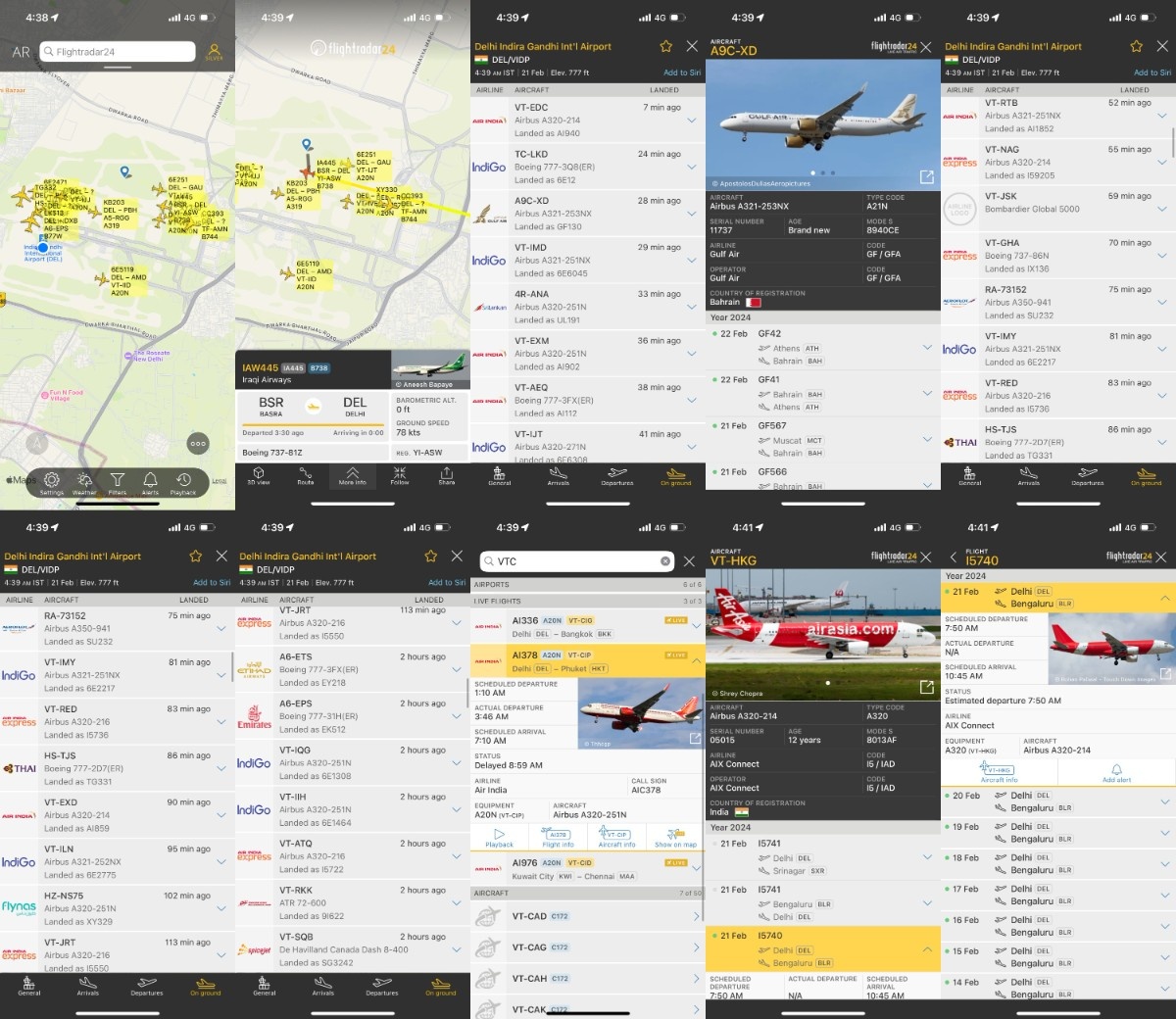
Heading back to the F&B, one name in particular caught my eye: Tim Hortons. Since opening its first Indian store at the über-luxe Select Citywalk mall in Saket, Delhi, in August 2022, the Canadian fast-food chain has only been increasing its store count in India by leaps and bounds — particularly in northern Indian cities like Delhi–NCR and Chandigarh, but also the west (Mumbai and Ahmedabad) and the south (Bengaluru and Hyderabad) in smaller numbers. In November 2023 it also entered Singapore, where I live and work, for the first time. Besides DEL T3, the domestic departures in DEL T1, BLR T2 and AMD (but not BOM yet) have a Tim Hortons as well.
Needless to say, I absolutely HAD to eat at a Tim’s immediately — and why not, given that even at five in the morning, there was quite a respectable selection of grub to be had. I went with the loaded chicken rice bowl and the strawberry-and-kaffir-lime Tim’s cooler, both of which I adored and would gladly pay north of ₹500 for again. My caption states: ‘You’re eating at Tim Hortons for the first time, so you must have something special, right?’
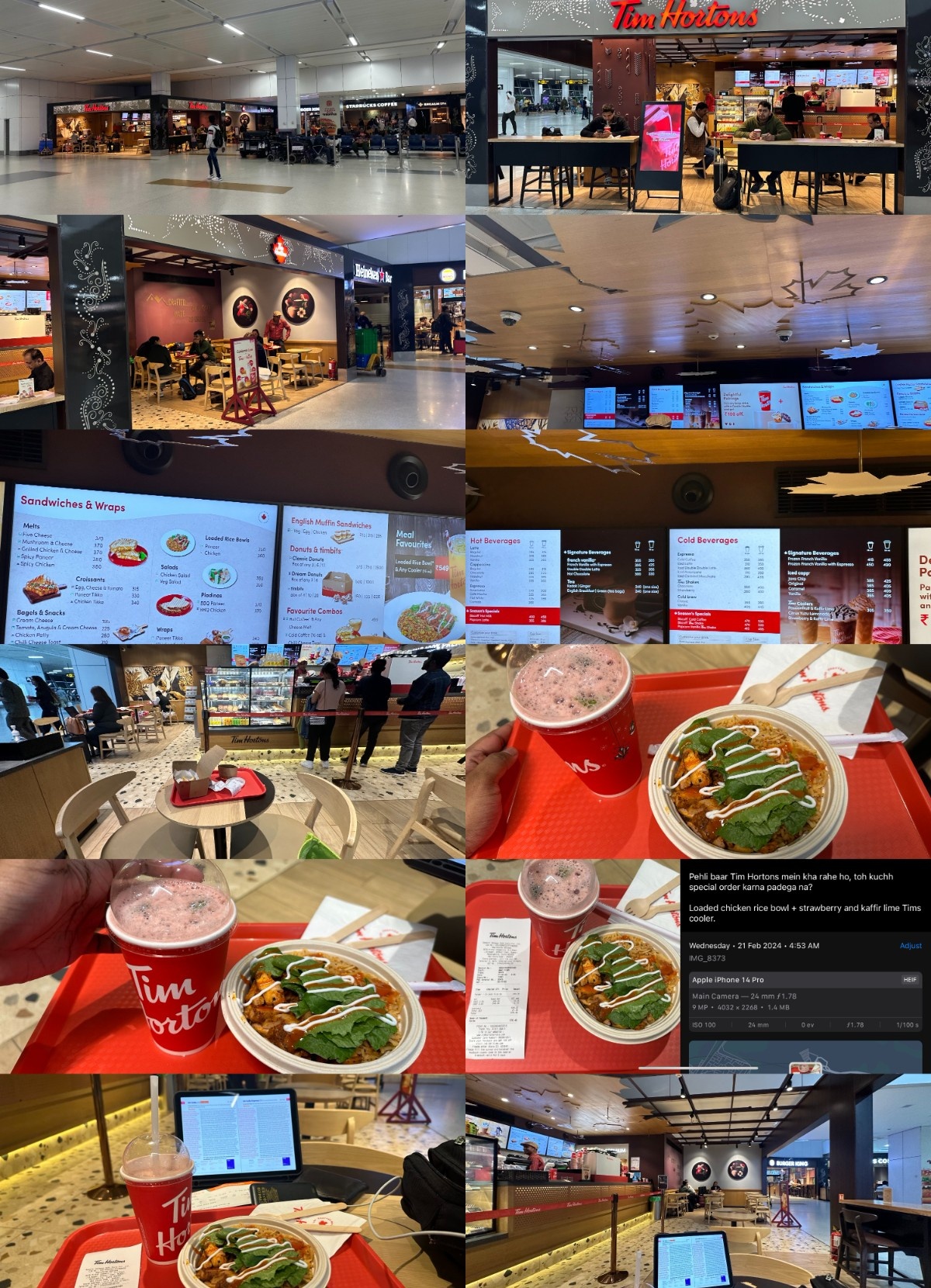
Now it really hit me that I was actually in Delhi, the CAPITAL OF INDIA, at its largest and busiest airport, for the first time in nearly a decade!!! More than the year, the decade, if you ask me, is a magical unit of time: it shows you how so much, and yet so little, things can change.
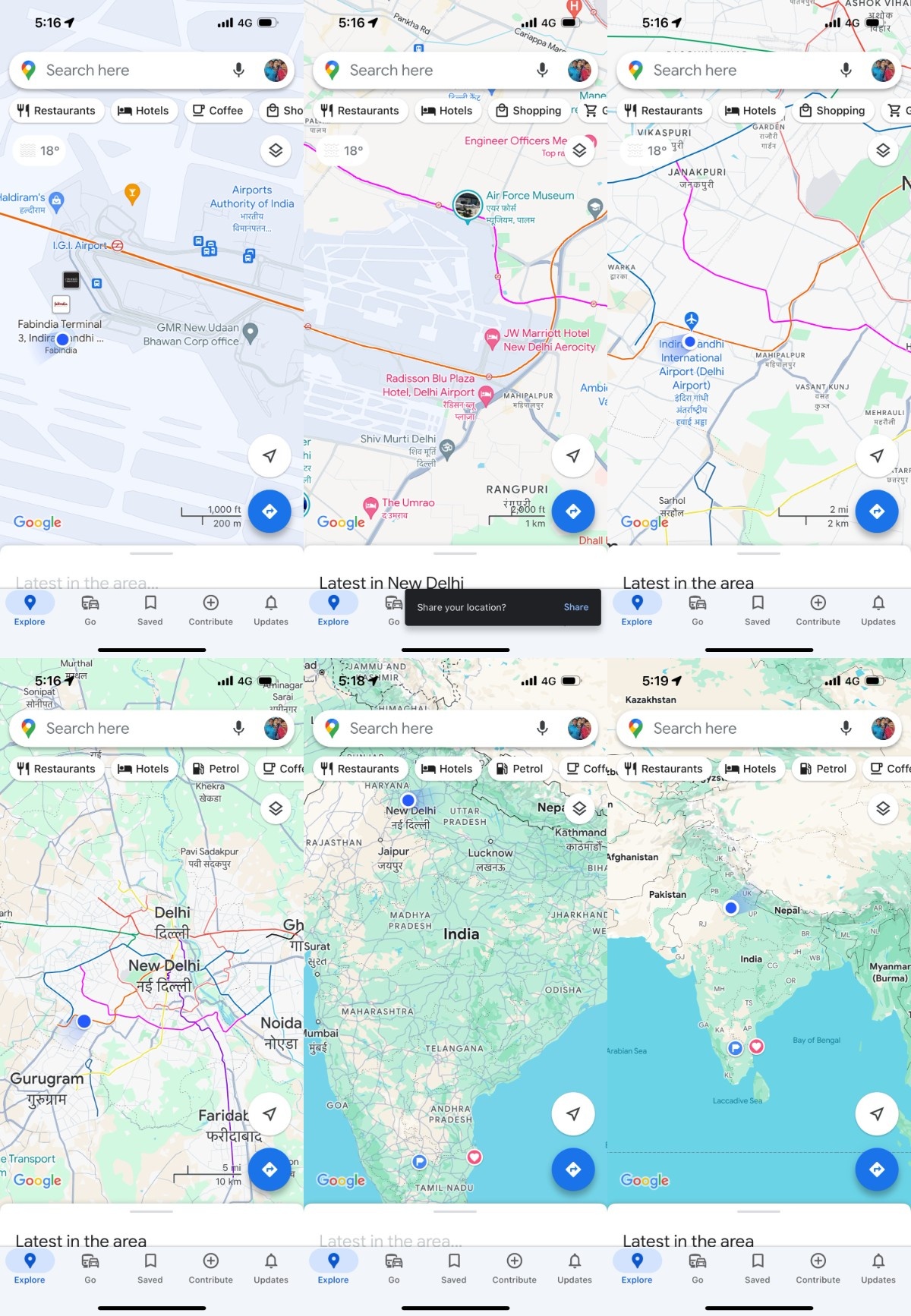
DEL T3 Domestic Departures: Gates and Retail Outlets
Next I moved on towards Gate 43, from where my flight, I5740, would be departing. En route, another bookshop — Relay this time — entered the scene, and from there on out it was a succession of seating and eating spaces.

Over here were a few pop-up stalls from the British pharmacy chain Holland & Barrett — in conjunction with the local Apollo pharmacy chain — and beauty and cosmetics brands Lakmé and Biotique.
I peered outside, where the lit-up driveway to Terminal 3 stood, and very soon the darkness would dispel and a foggy sunrise take its place. More snacks stalls and a lounge later, the actual gates finally started.
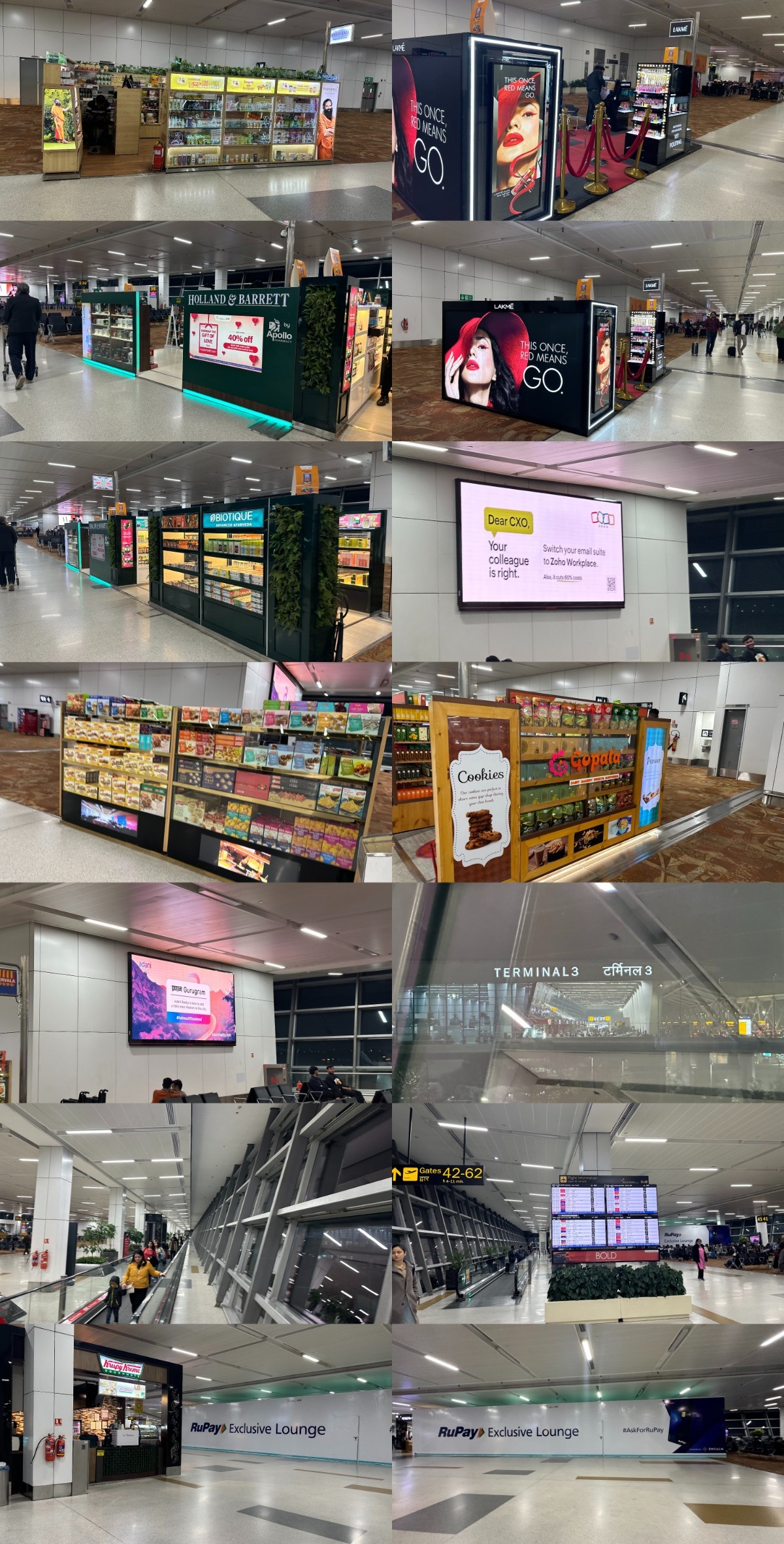
Now I managed to spot another special Tata-group dedicational livery: VT-JRT, a 2008-built A320 which joined the then-AirAsia India in 2015 and which has been sporting this ‘The Pioneer’ livery, dedicated to J.R.D. Tata — the founder of the then-Tata Air Lines (now Air India), hence the registration — ever since.
Also see my note on the signage, which looked somewhat outdated, in contrast to HYD, a fellow GMR airport. But at least it wasn’t the clichéd Frutiger that so many global megahubs — from Heathrow to Changi to DXB, even BLR T2 for that matter — use.
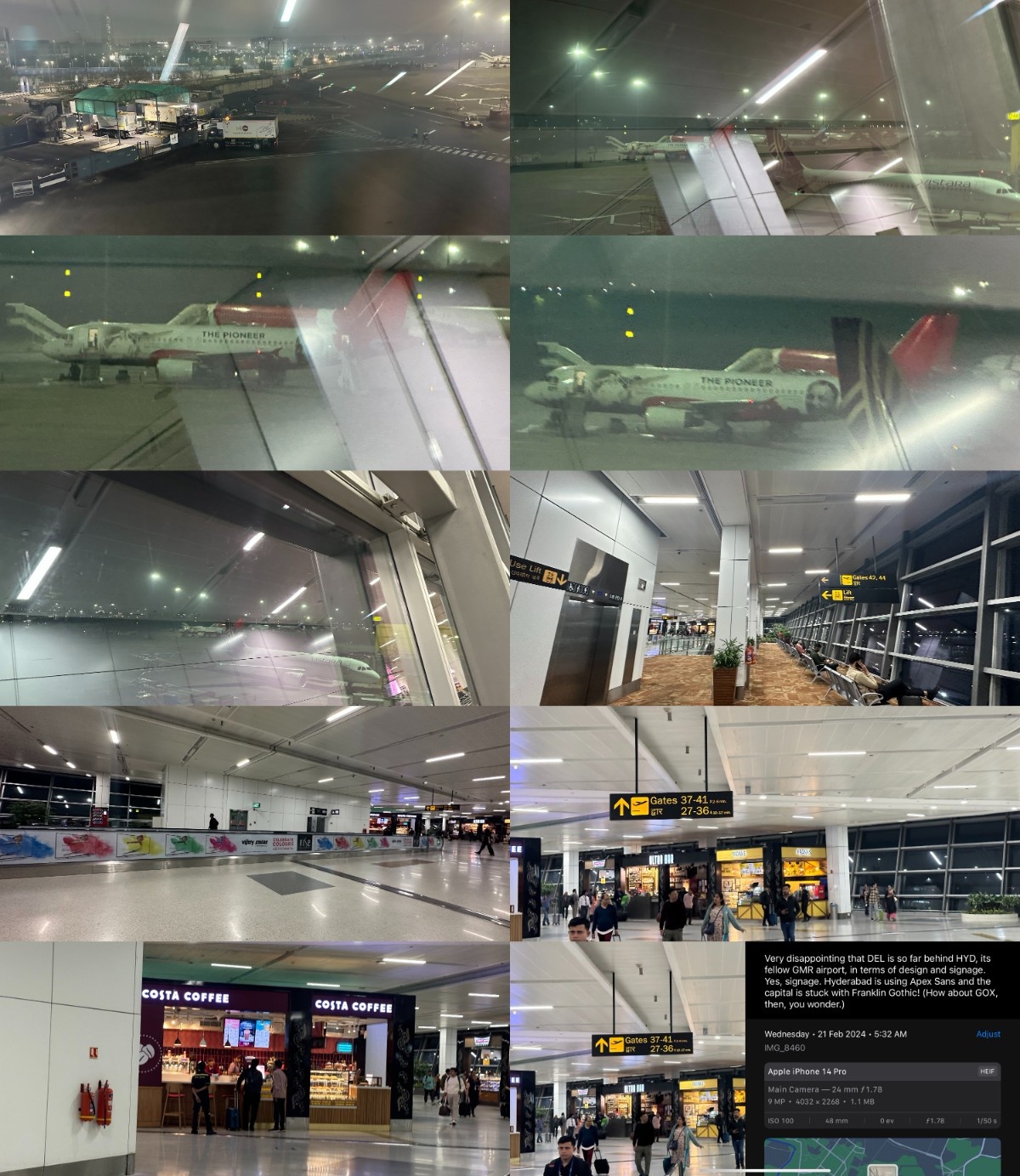
I finaly reached Gate 43, which had its fair share of product placements, including OnePlus-branded charging points aplenty. Advertising abounded all around, from the travellators to the screens that were showing a succession of ads for all manner of products. Among them was badminton superstar and Olympic medallist P.V. Sindhu, now the face of California Pistachios — who unfortunately came away empty-handed at the recently concluded Paris Olympics, a break from her medal-winning performances in Rio and Tokyo.*
*India could not manage a single gold medal this time, and had to settle for a silver — who else but Tokyo gold medallist Neeraj Chopra — and as many as five bronzes, including two from young shooter Manu Bhaker. One can only wonder what would have happened had Vinesh Phogat, the champion wrestler who fought tooth and nail against discrimination and sexual harassment, not been denied the silver or gold she so rightly deserved.
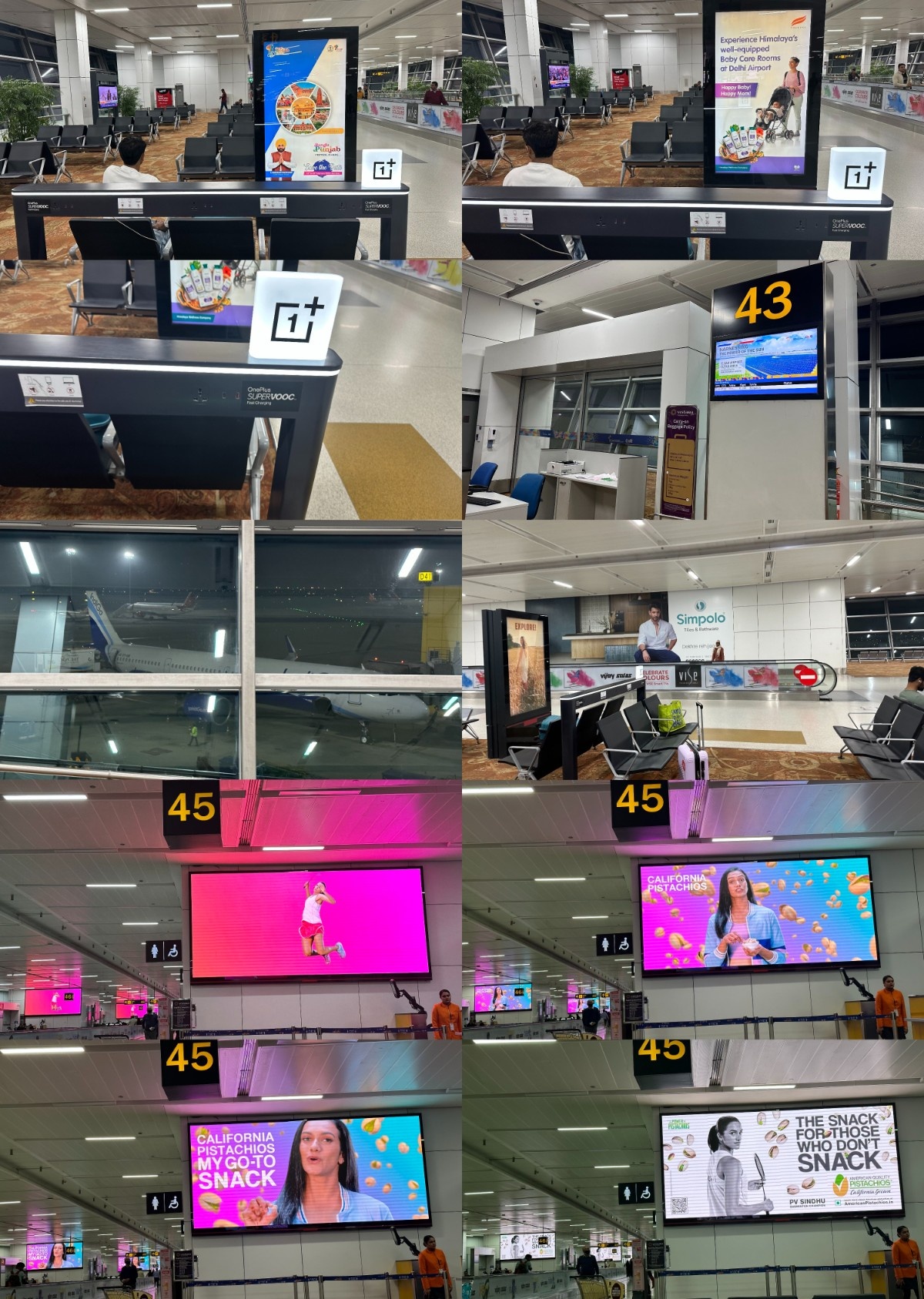
P.V. Sindhu aside, there were a number of other celebrities from the sports and entertainment businesses, including legendary cricketer M.S. Dhoni for the State Bank of India, and A-list actress Anushka Sharma — wife of former cricket captain Virat Kohli — for Michael Kors.
As it turns out, Sharma had given birth to a boy barely days before — her second baby after a girl in 2021 — which I was not yet aware of, and so had written, ‘Yes, Mrs Kohli (a.k.a. Sharma) is expecting again.’ (Pet se, or ‘from the stomach’, is the Hindi equivalent for that English euphemism for pregnancy.)
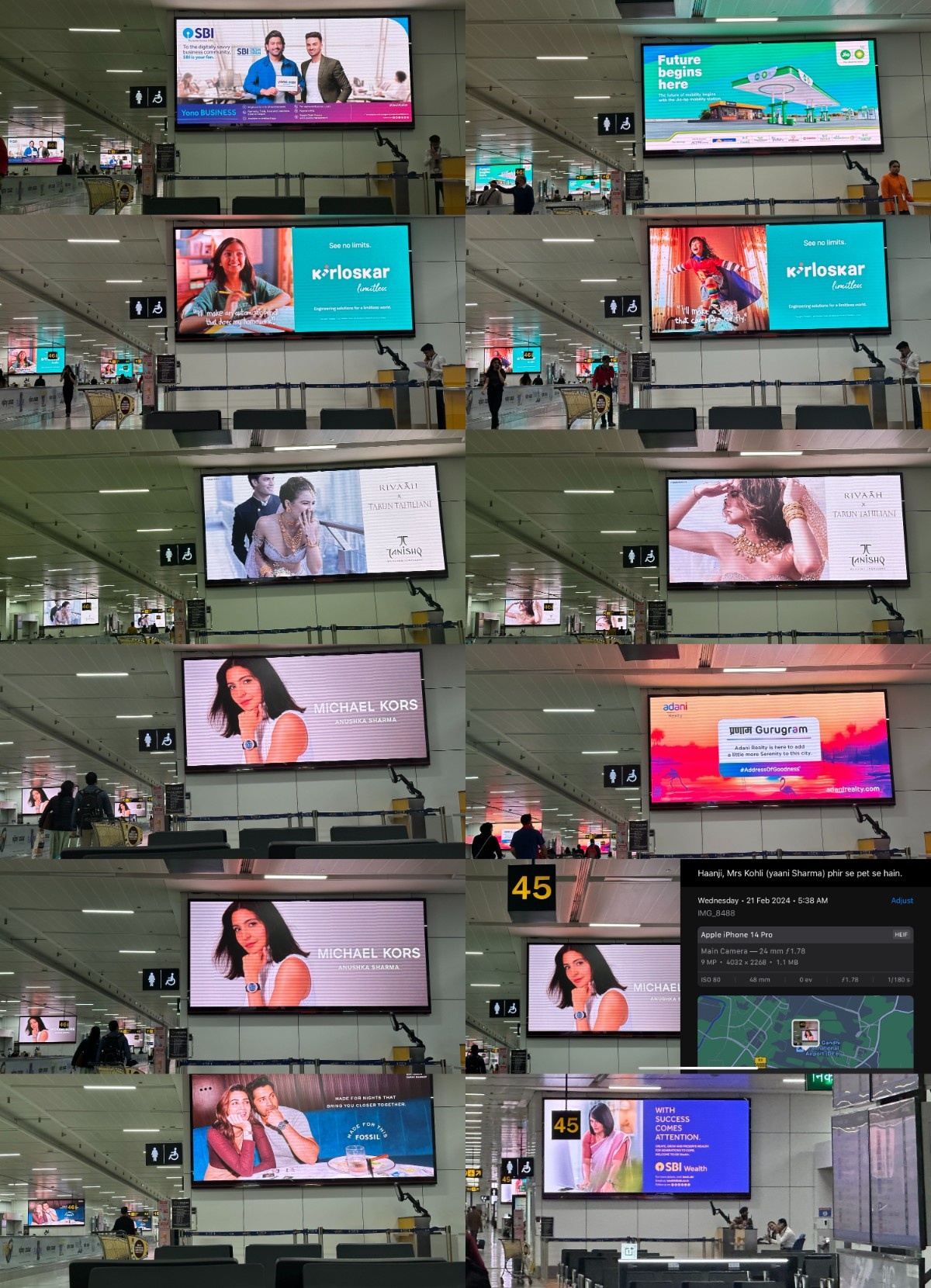
HOI and cry: A failed order attempt leaves me high and dry
Now GMR Airports has an all-in-one app called HOI, which operates across its two largest airports (DEL and HYD) and is designed to be a one-stop-shop for food ordering across anywhere in the terminal, among a host of other features. At least that’s how it was supposed to work in theory. I’d already tried it out in Hyderabad at the very beginning of 2023, but it was in vain, as the order was never processed. Would this time be any different in the country’s predominant megahub?
First I logged in to the web app, and added my upcoming departure. My gosh, there were tons and tons of flights, thanks to the gazillion codeshares — and about as many airlines, in a seemingly endless list! (Between the choices of AirAsia India and ‘AIR INDIA EXPRESS’, I chose the latter, even though the former was also perfectly reasonable and valid due to this flight’s I5-prefixed code.)
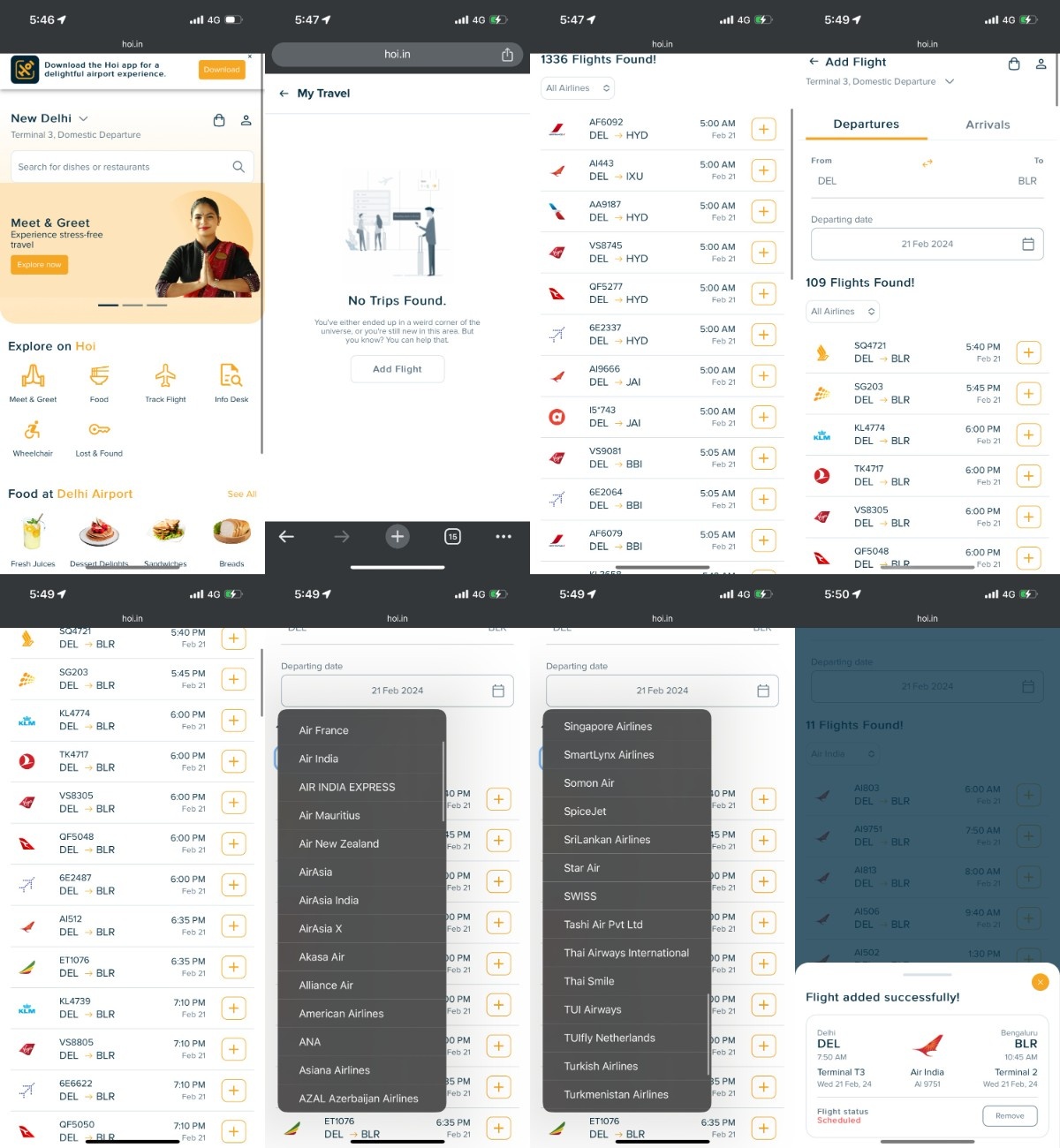
Then I explored the mind-boggling range of eateries, cutting across cuisines and gate locations, and eventually decided upon a snack stall called Frank’s that was close to my gate. I chose a relatively cheap snack — though ₹218 (US$2.60) is not that cheap in reality, but for a pricey airport it would do — in the event that if the order failed (which it was likely to), I wouldn’t be losing a lot.
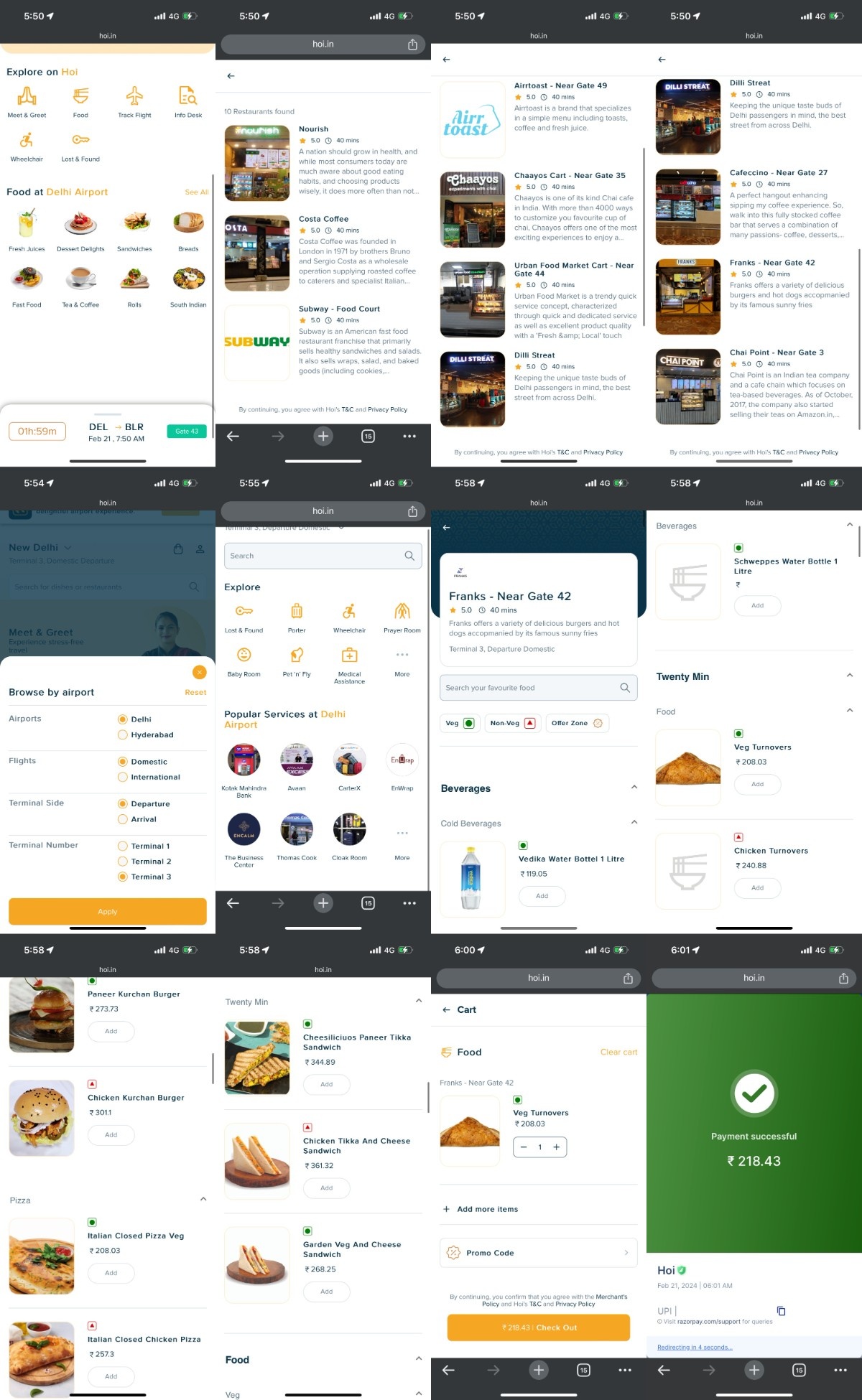
As I headed to the Franks stall to enquire about my order, RA-73152, the Aeroflot A350, passed by on the way to depart as SU233 to Moscow–Sheremetyevo. I gave the plane a rather sinister look in the morning darkness, more so as it was from a sinister country — even though it remains a great friend of India’s throughout the war, despite our also maintaining excellent relations with the West and even (as the visit in late August 2024 showed) Ukraine.
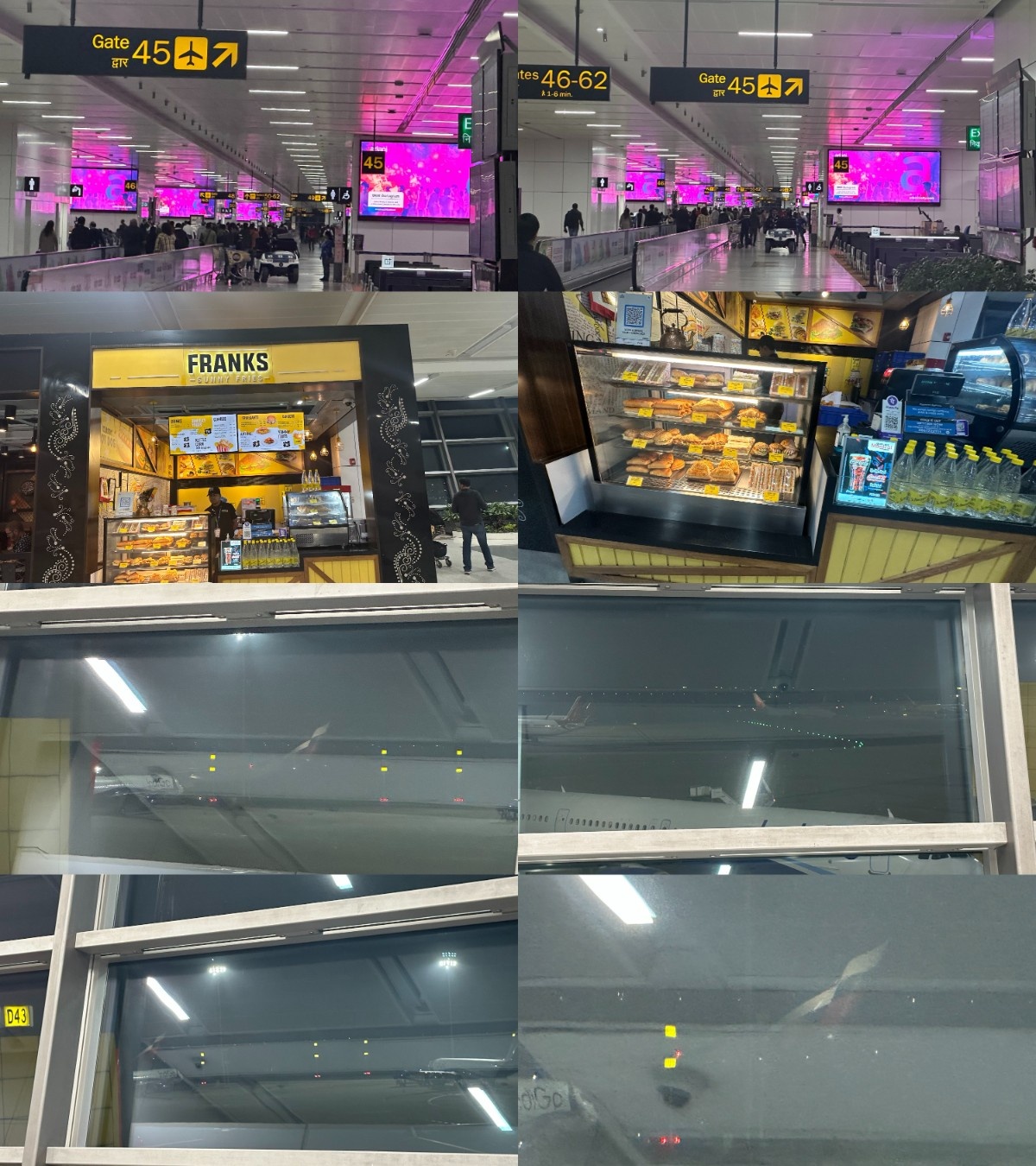
That sanctioned A350 aside, there was another SkyTeam member’s A350 — from the fair and free Western Europe — namely Air France’s F-HTYO, preparing to take off as AF215 to Paris.
I had a look at the fleet of AIX 737 MAXes, a couple of which (VT-BXR and BXS)* had been delivered only days before, and were now at the GMR Aero Technic facility in Hyderabad for being repainted from their original Chinese operators’ liveries to the new AIX livery, each with a bespoke tail design. Followed by VT-ATD, at the time the lone A320neo in the new AIX livery, who I’d be spotting later that day at BLR. After this I headed to Planespotters.net, my preferred source of aircraft data and history, and looked up my upcoming A320, VT-HKG.
*All you have to do is change the T in VT-BXS to P, and you get the Bermudan registration VP-BXS, which would have been another Aeroflot A350 — but ended up going to Turkish Airlines as TC-LGI, the first of four such! For that matter, even RA-73152’s previous registration in Bermuda was VP-BXC, which is very close indeed to an AIX 737 MAX 8.

In a tucked-away corner of the Planespotters.net page was a Cathay Pacific ad for Taipei, which made me recall that manic day at HKG even more, where I crisscrossed from the Sky Bridge and Intervals Bar to the Chase Sapphire Lounge.
Speaking of Taipei, Taiwan is considering opening its doors to Indian travellers by adopting a visa-on-arrival scheme, helping to eliminate the lengthy paperwork that Indians need to visit Northeast Asian destinations — with the exception of Hong Kong, which only requires a Pre-Arrival Registration (PAR) instead. (Currently Taiwanese airlines don’t serve India, though China Airlines did fly to Delhi prepandemic.) If Taiwan’s VOA scheme ever takes place, you can bet I’ll be taking an EVA or Starlux flight — renowned as among the world’s best airlines — straight to the land of boba tea!

Now I headed to the snacks store and confirmed that, indeed, the order never reached them — so much for all the hue and cry about HOI! I didn’t bother asking for a refund or anything; it just goes to show that GMR has a fair bit of work ahead of it to make its ordering app actually work. Given that it had also failed to work in Hyderabad the previous January, maybe there’s something running deep in the UI that makes it give up, or something!
I had better things to do than sleep, just as night was starting to become day. Like watching this English news channel, News9 — part of TV9 Network, now one of India’s largest news broadcasters — promote the food and lifestyle content on its streaming platform. There are certainly worse ways to kill time at an airport than taking in the surroundings, and transporting yourself to a different world just before the flight.
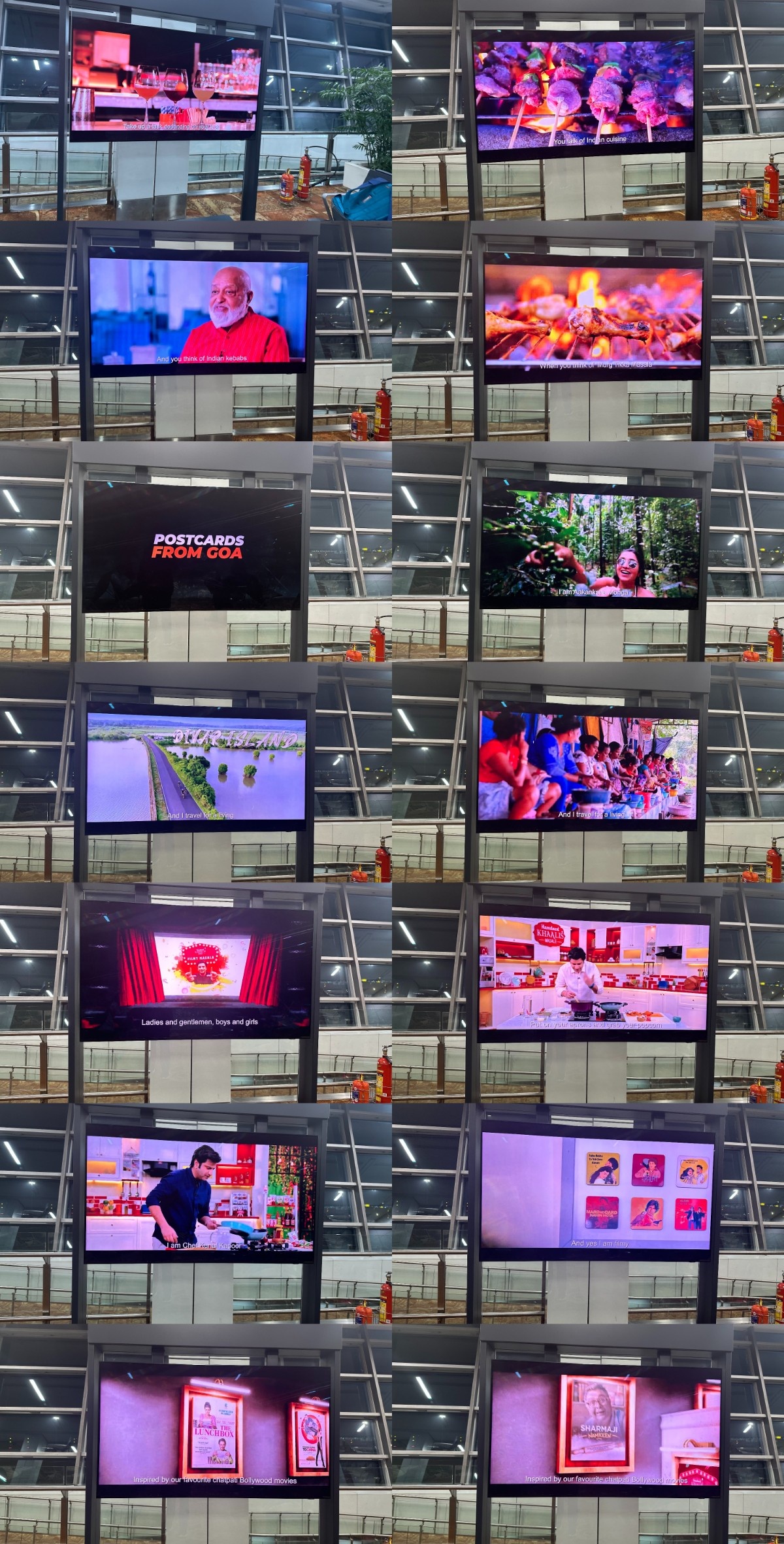
There was a fair bit of glamorous girls showing off their stylistic and Instagramming abilities, especially with regard to the hoity-toity class of Delhi. Influencers gonna influence, I guess… (Full resolution with subtitles here.)
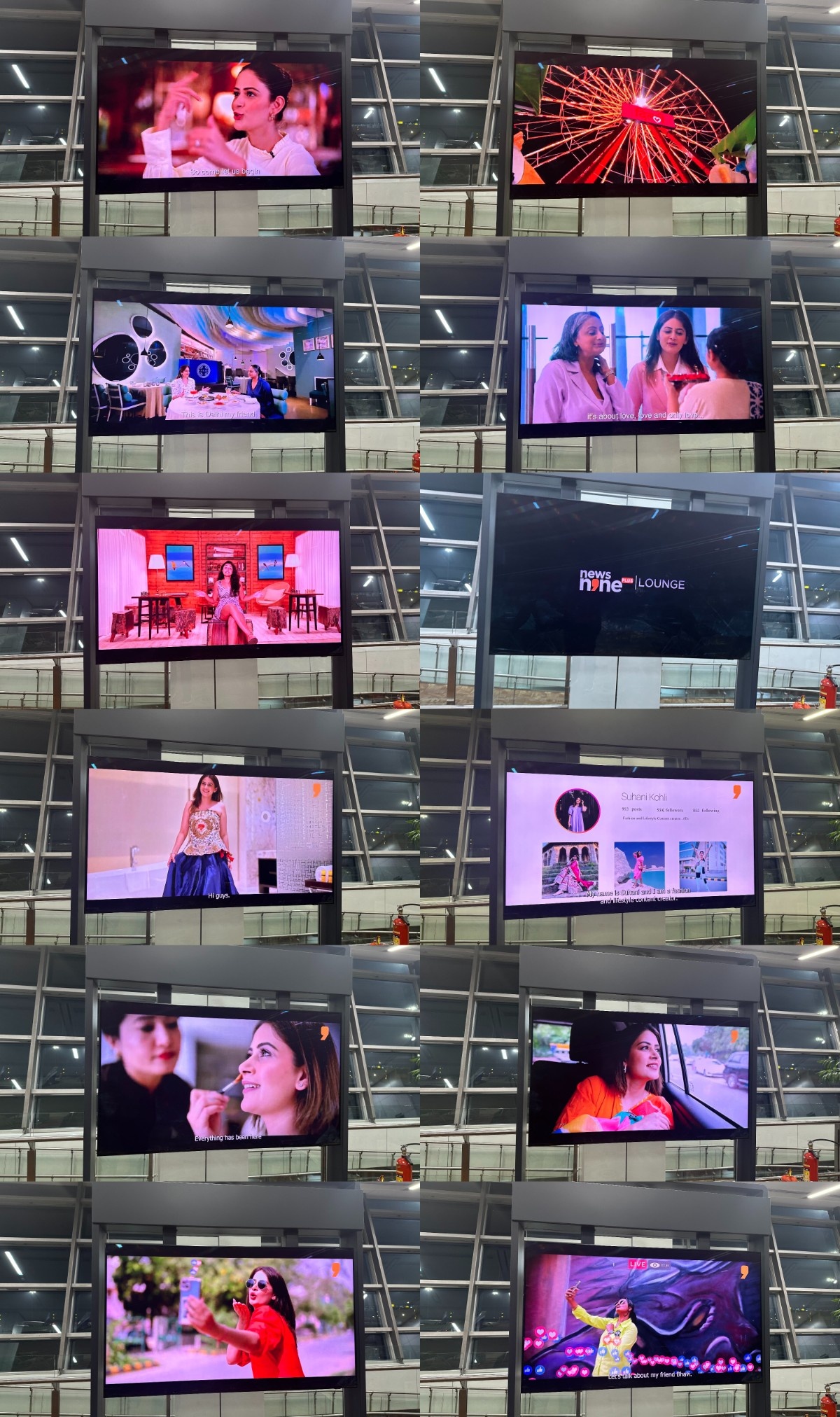
Something less lifestyle-y and more news-y was the state of the traffic in my destination (and current Indian home), Bengaluru, wherein the reporter would cover one of the city’s most congested stretches in the Metro instead of a car. ‘Bengaluru Unjammed’: a fitting title indeed!

Boarding, as night turns into a new (foggy) day
I slept off for an hour or so, sprawled on the comfortable benches by Gate 43, and woke up around 6:50 — by which time two 777-300ERs were departing for Istanbul, one after the other: one being Turkish Airlines’ own TC-LKA as TK717, and the other being IndiGo’s wet-leased TC-LKD as 6E11. Mumbai has almost the same pattern, with TK721 and 6E17 within minutes of each other.
As Türkiye has never been a very friendly country to India politically, bilateral rights remain frozen, and this will remain the extent of India–Türkiye service for the foreseeable future — but 6E, strategising here as it does with most things, has capitalised on connecting traffic beyond IST by moving its flight timings to match those of Turkish Airlines.
Meanwhile, another Star Alliance member had just landed: Ethiopian Airlines’ ET-ATL, a 787-8, as ET686 from Addis Ababa. And I also had a glance at where VT-JRB, Air India’s second A350 — which I’d be flying in a few days’ time — was flying. Exciting times indeed!
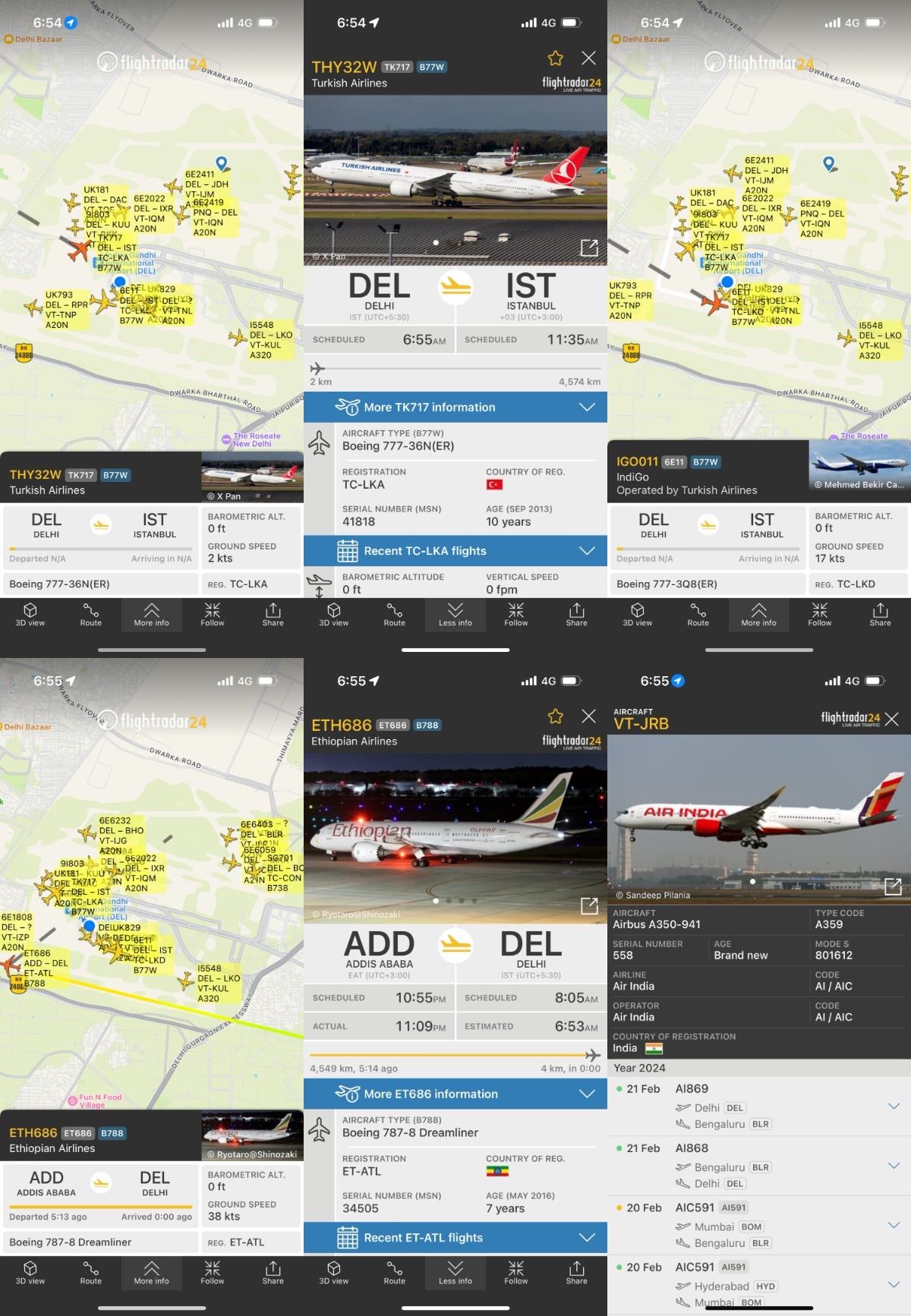
Boarding was about to commence, as the skies lightened, not with the radiant glow of the sun, but with the foggy pollution-filled grey that’s oh-so-Delhi. The note I wrote is self-explanatory: the greyness and glumness of the sky was a perfect match for that of the terminal itself — with the ads being the only colourful thing around!
Meanwhile, a girl (late teens/early twenties) on the phone caught my attention nearby. She was trying to convince her dad on the phone that her brother was the most irresponsible person on the planet, and so did not deserve to have a dog! 😅
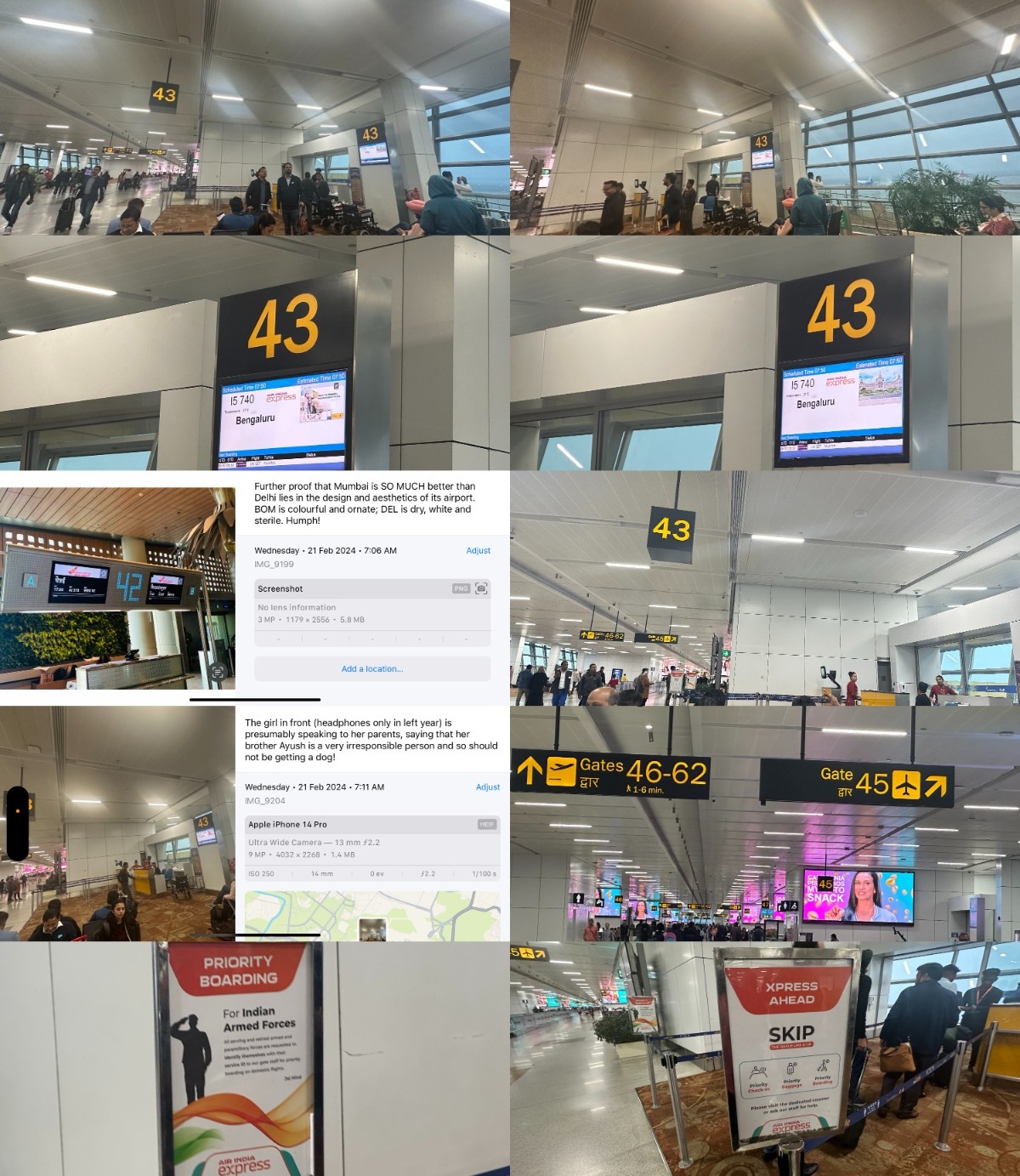
As I joined the queue, I busied myself with articles from Indian aviation analyst Ameya Joshi — whose WhatsApp group I’m a part of — about IndiGo launching its longest narrowbody route, Bengaluru to Denpasar (some months after Mumbai to Jakarta), and low-cost startup Akasa Air launching its first international flights to Doha, with Abu Dhabi, Jeddah, Riyadh and Kuwait following in the ensuing months.
For new Indian entrants, the Gulf countries are the safest bet; for the largest, most entrenched operator, exotic Indonesia and Vietnam are no task too big! (Speaking of which: when exactly will Air India Express go beyond its bread-and-butter services to the Gulf and Singapore, and venture into new, exciting countries in the region and beyond?)
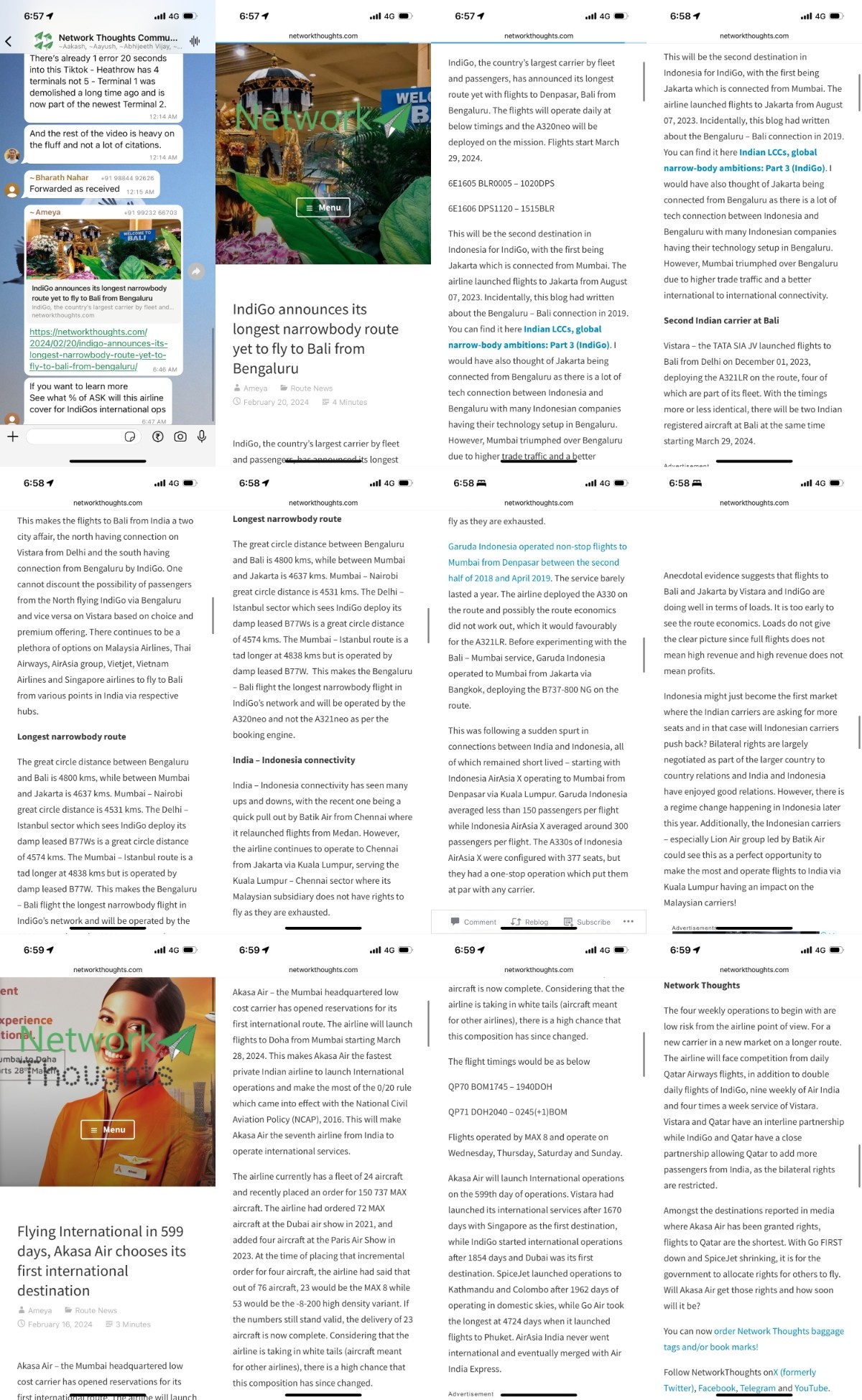
Soon it was time for me to step on board this strange-looking A320, a remnant of a what-could-have-been past — what if AirAsia India actually managed to launch international flights, like the HKG on this plane? — and away from the glum, gloomy corridor of DEL T3. Truth be told, the tessellated pattern at the gates, a bit like stained-glass mosaics on churches, was far more colourful than the rest of the terminal.
This plane may or may not be eventually repainted in the AIX livery, but looks don’t matter — it’s what inside that’s counts, and the inside was very impressive indeed, mark my words!
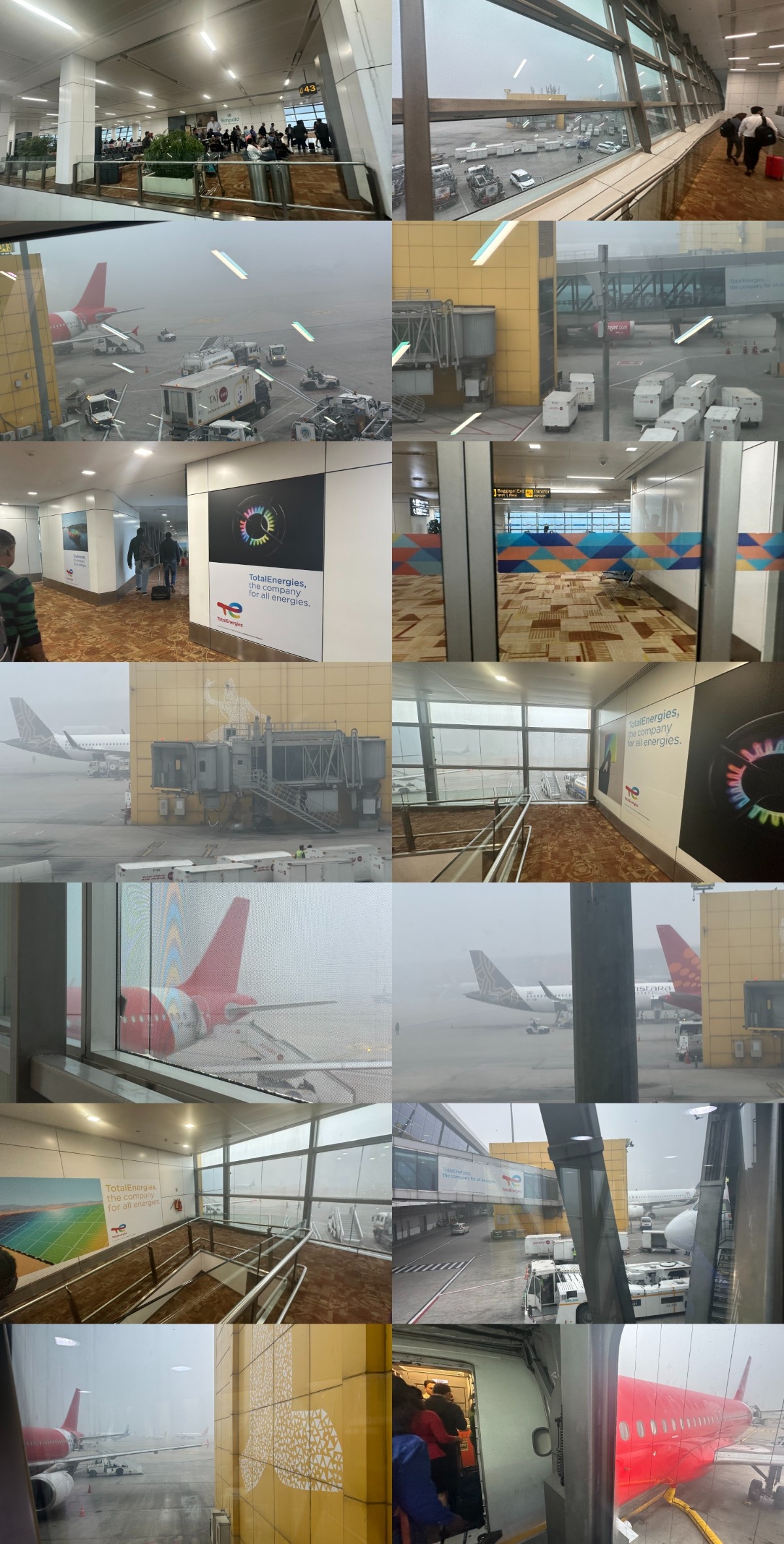
The flight: Boarding and departure
Flight: Air India Express I5740/IAD740 (marketed as AI9751)
Date: Wednesday, 21 Feburary 2024
Route: Delhi–Indira Gandhi (VIDP/DEL) to Bengaluru Kempegowda (VOBL/BLR)
Aircraft: VT-HKG, Airbus A320 (blank red livery)
Age: 12 years 2 months at the time (built: 29 November 2011; delivered: 15 December 2011 as JA802A to Japan’s Peach; joined the then-AirAsia India: 19 December 2019; transferred to AIX Connect: 21 December 2022)*
Seat: 22F (starboard side, window)
Boarding: 7:05am Indian Standard Time (UTC +5:30)
Departure: 8:05am IST
Arrival: 10:25am IST
Duration: 2 hours 20 minutes
Notes:
• First-ever flight on Air India Express, as I’d never flown them (avoiding them with good reason) before the October 2023 rebrand. However, I did fly AirAsia India, their predecessor, on one occasion on 27 December 2022 (also to BLR): I5612 from Chennai to Bengaluru on VT-VTZ, days after the legal operator of the airline was renamed to AIX Connect on 21 December.
Hence this was the second — and final — time on an I5 flight number, which continues to be used alongside Air India Express’ original IX code, well after the AirAsia India brand was sunset on 31 October 2023. On 1 October 2024, however, the I5 code will also be retired and all Air India Express flights will use only IX flight numbers going forward. (It’s a different matter when blank red A320s like this will be painted, if at all!)
*It’s not often that I fly an aircraft which has seen multiple owners — and such was also the case for the AirAsia India A320 in December 2022. Almost all the aircraft I’ve flown were delivered new to their operating airline and have never operated for anyone else!
Leather seats on an Indian LCC?! Yes, they do exist…
You’ll notice that, as is de rigueur on AirAsia-group A320s, the seats are padded black leather seats — in stark contrast to the harmful-for-buttocks paper-thin cushions that IndiGo has. The inside of this A320 was as beautiful as the misty view outside was mist-erious, with VT-ATV in the ‘Tata–SIA Airlines’ livery beginning pushback as UK943 to Mumbai.
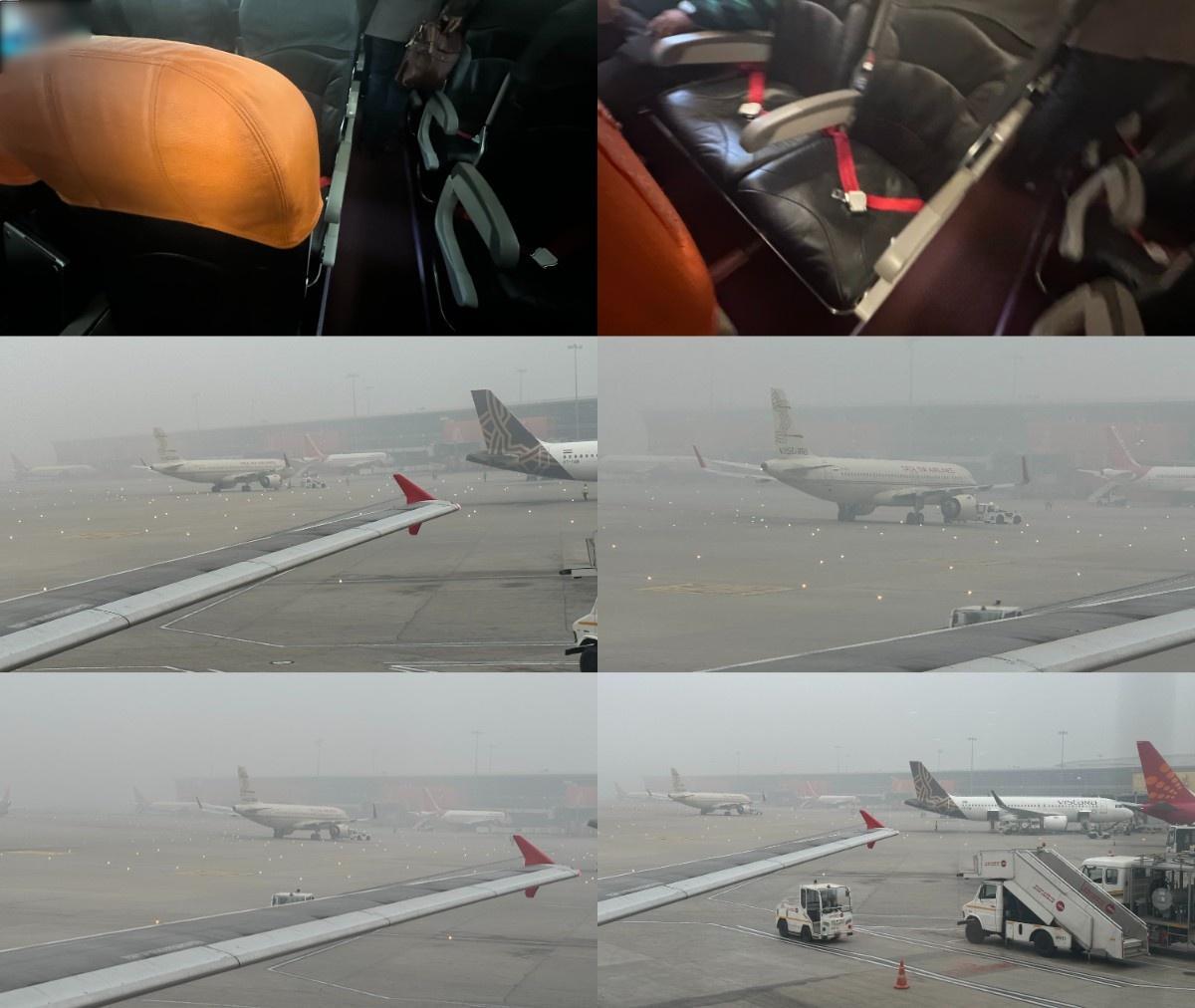
Inside, there were ads for Jammu & Kashmir Tourism on the overhead bins. Since being turned from a State into a Union Territory five years ago, on 5 August 2019, the security and human-rights situation in India’s only Muslim-majority region has only gone from bad to worse — but that hasn’t stopped hordes of tourists from flocking to the majestic Himalayas.
Go figure that was the last time I’d come to Delhi: this was in May 2015, en route to Srinagar (SXR) — the gateway to Kashmir and a major tourism hotspot — and the last time I ever flew that doddering, tottering airline, SpiceJet.
I settled into my seat and perused through the seatback contents, and they were quite comprehensive — save for the lack of an inflight magazine, which IndiGo very much has. From the bright orange safety card, to the Gourmair menu — spruced up to reflect the new AIX branding — with its guide to the streaming entertainment, to the Get Well Soon airsickness bag, every part of the branding inside the plane was very well executed indeed, down to the X ‘connector’ logo on the seatback headrests. If only that could be said for the blank exterior!
Parked beside us was VT-TNZ, a plane I often seem to run into at Indian airports, as I’m pretty sure I also spotted this bird some time or the other at Mumbai. Bottles of Aava water were handed out, which was all the more impressive since that’s usually confined to full-service carriers.
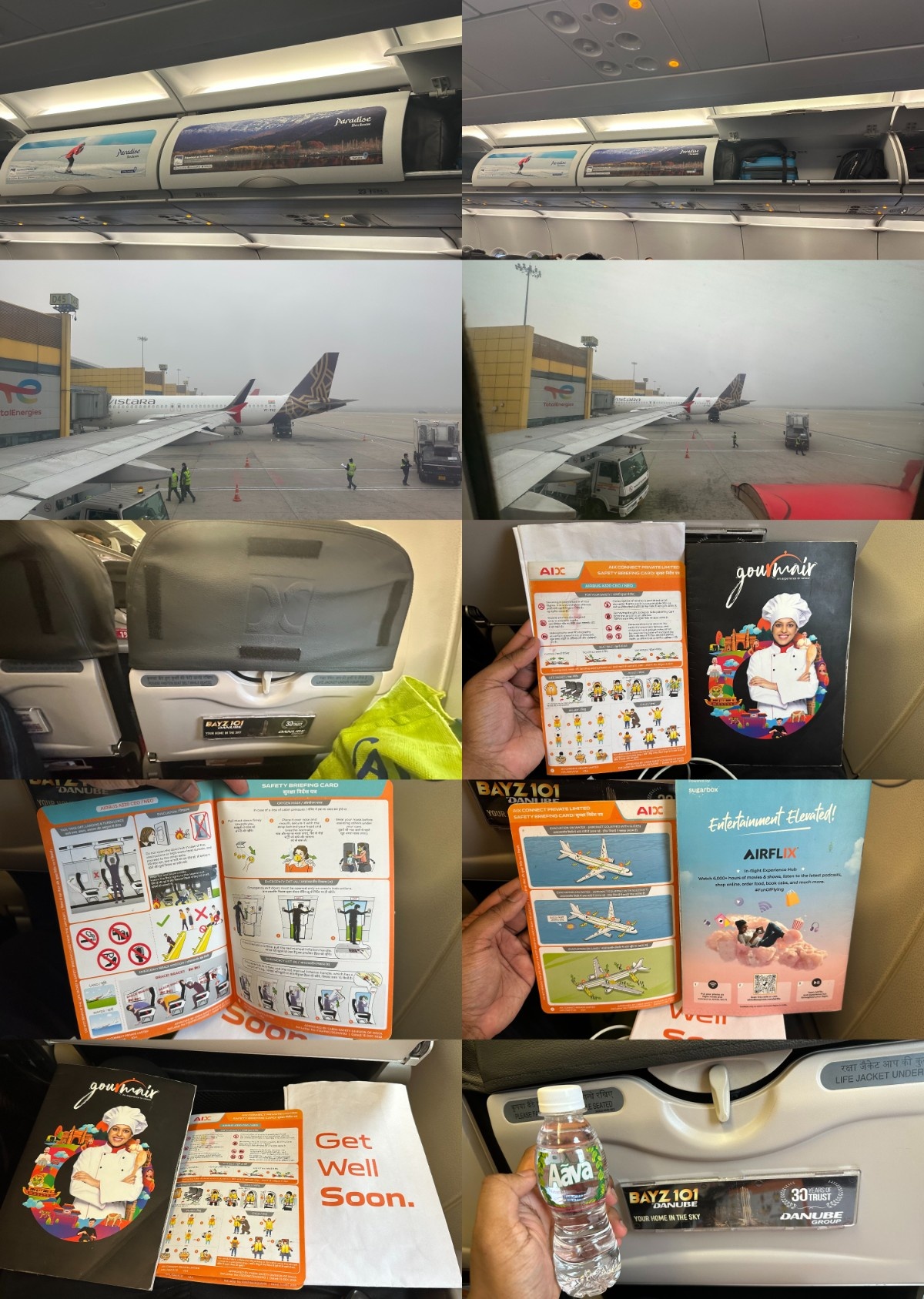
These were the aircraft on the ground at the time, ranging from the puny VT-UDB, a very new ATR 42 of the state-owned Alliance Air, to the mighty VT-AEQ, an ex-Etihad 777-300ER (ex-A6-ETO) that Air India inducted to provide a better product on several of its US and London routes. However, a similar plan to induct three 777-300ERs from Singapore Airlines — presumably 9V-SWD to SWF — seems to have failed, as there has been no news on the same since its initial announcement in July 2023, and those planes remain indefinitely parked at Changi.
Meanwhile VT-EDF, one of only four non-wingletted A320s (like mine now) at Air India, was operating on the weekly Wednesday-only service to Yangon (RGN) as AI235. An intriguing aircraft and route indeed!
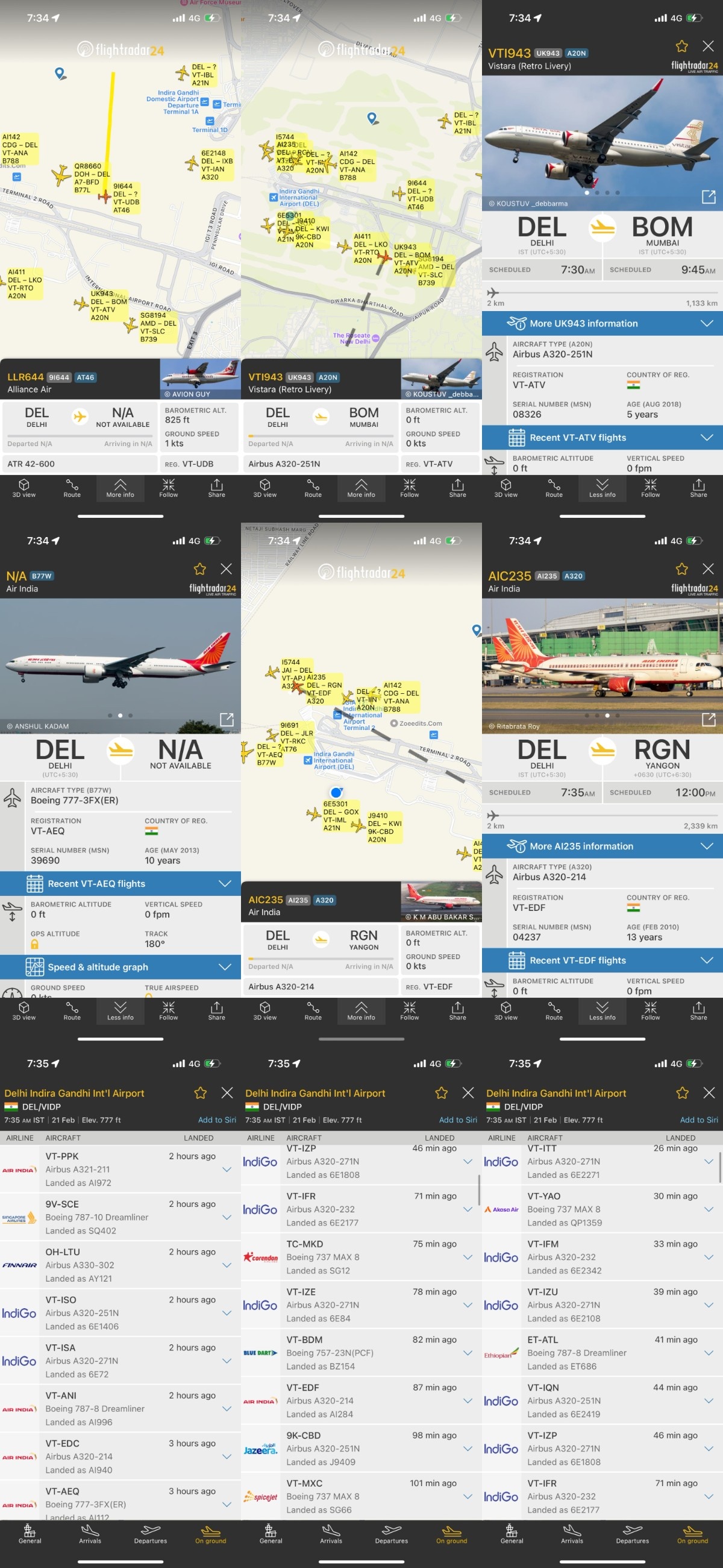
At 7:40 on the dot — in line with the flight number — boarding was finally completed. I was now tired of spotting all the aircraft, and instead turned to the Gourmair menu. A very thorough and impressive one it was indeed, with all manner of cold and, crucially, hot options — though I’d had the good sense to pre-order my meal online at the Manage Booking page. (Full resolution here.)[rant]Of course, I hate the Montserrat font as much as I hate the Thai Airways 777-200ER, but there’s no escaping either of them. It’s clear that despite the font being so overused, AIX has made the deliberate decision of using Montserrat alongside the custom Air India Sans despite so many better options out there. What Saudia got perfectly bang-on, AI(X) had to screw up. That I cannot forgive.[/rant]
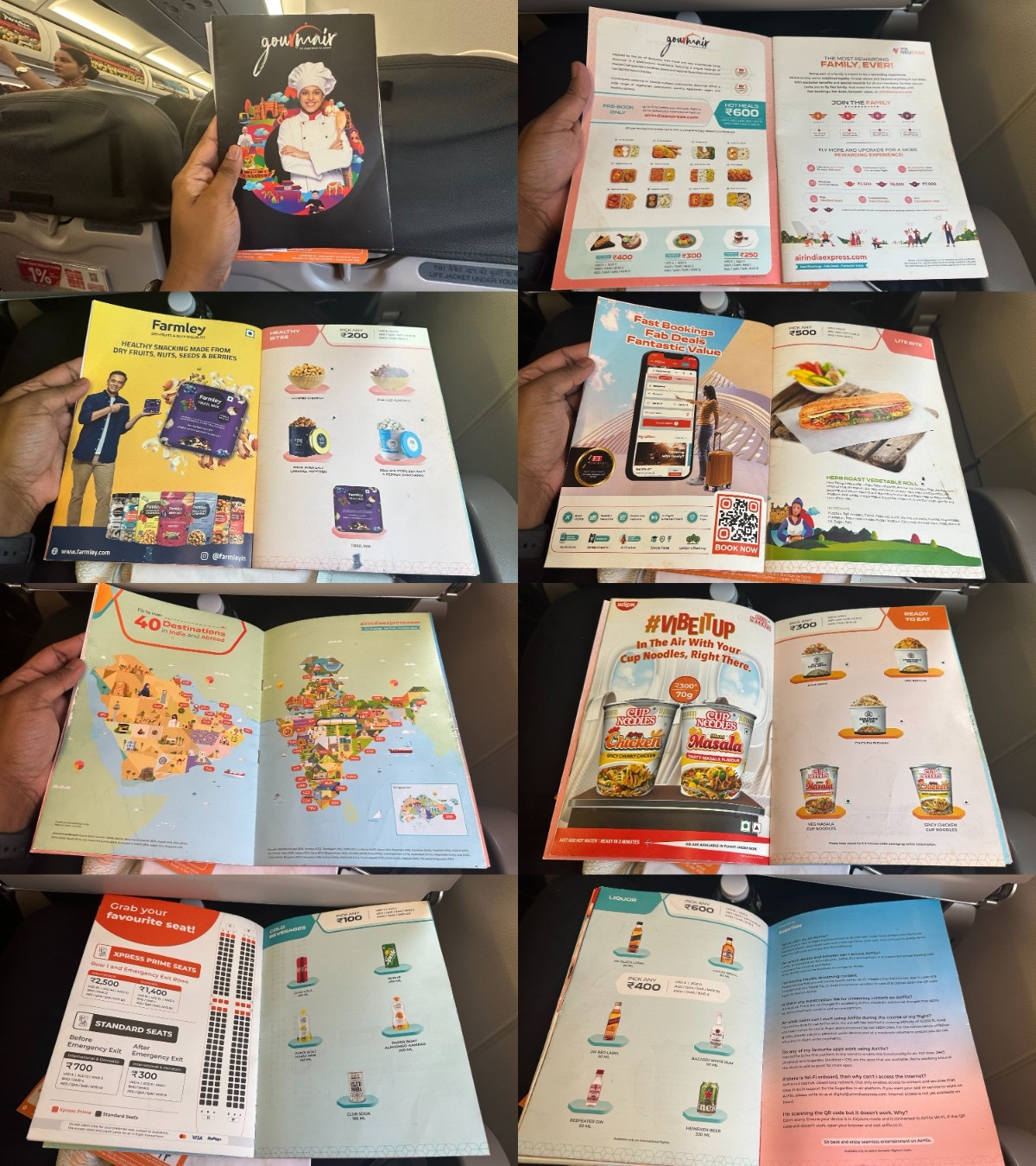
Here was the guide to connecting to the streaming IFE, AirFlix, which is a brand preserved from the AirAsia India days (which weren’t all that long ago!).

My dad had booked a taxi pick-up from the airport, whose details he shared, and my mom hoped for a lovely time together, to which I responded, ‘I hope that’s what happens!’ 😇
Now my A320 appeared on the radar, just as a DEL–HEL flight did the same: Finnair’s A330-300 OH-LTU as AY122. In this country of A320 supremacy, a couple more appeared in view, with A320neo VT-TQQ next to us ready to take off for Kathmandu as UK157, and Etihad’s A6-EIT on final approach as EY212.
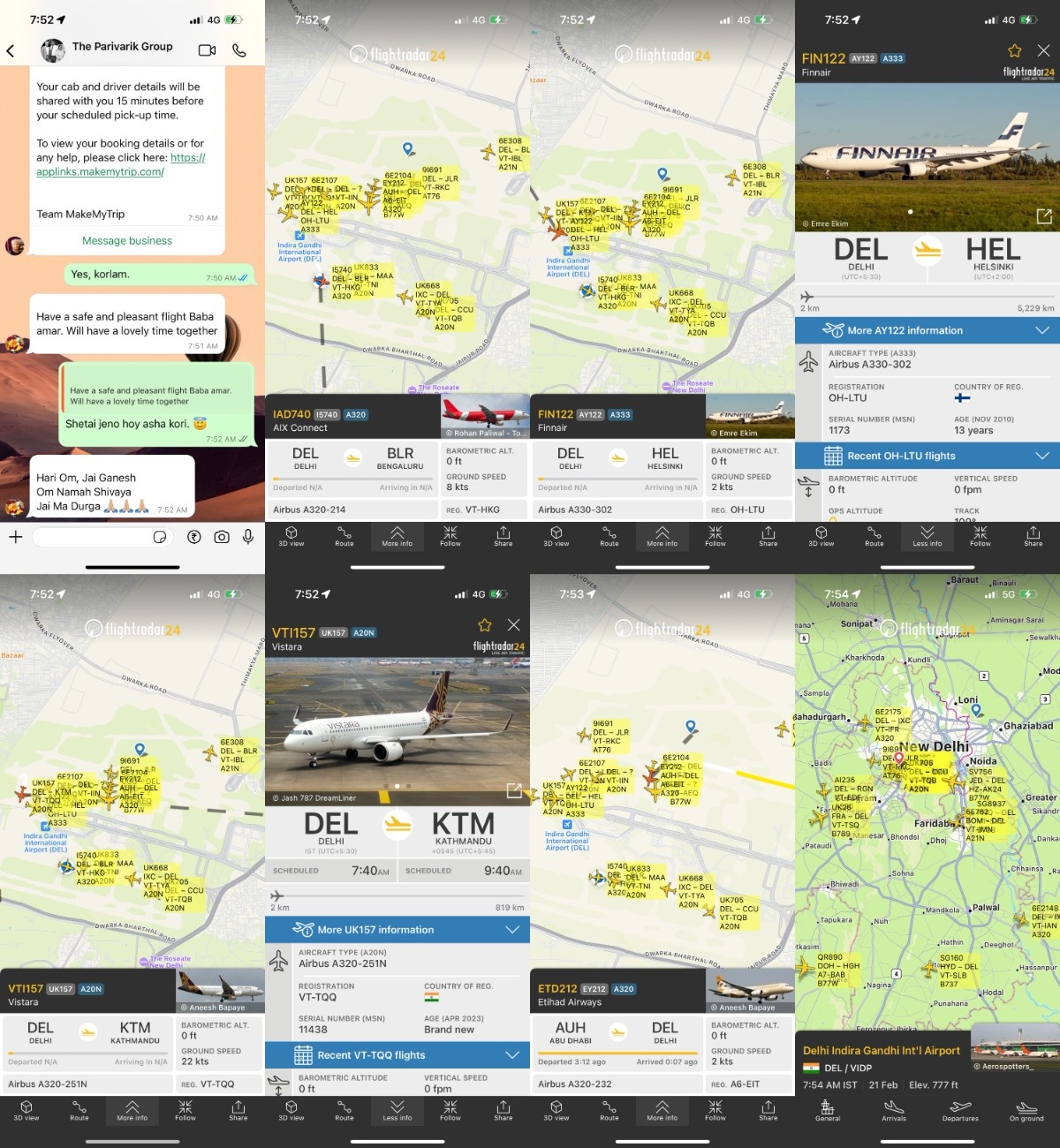
As the manual safety demonstration was performed — more about the cabin crew in a bit — I captioned the view out the window ‘City of kuasha (Bengali for mist)’. Meanwhile a familiar bird appeared close by: VT-TQT, the Vistara A320neo I’d flown in Premium Economy just two months before, from Mumbai to Bengaluru, at the ripe old age of one month old!!!

At five minutes past eight, the wheels of the (Air)bus went round and round, and we soared up, up, up into the sky, away from the dreary capital of India and its glum airport terminal, with streaks of mist and vapour jetting against the windows, until at last the clear blue skies of a spring morning loomed ahead.
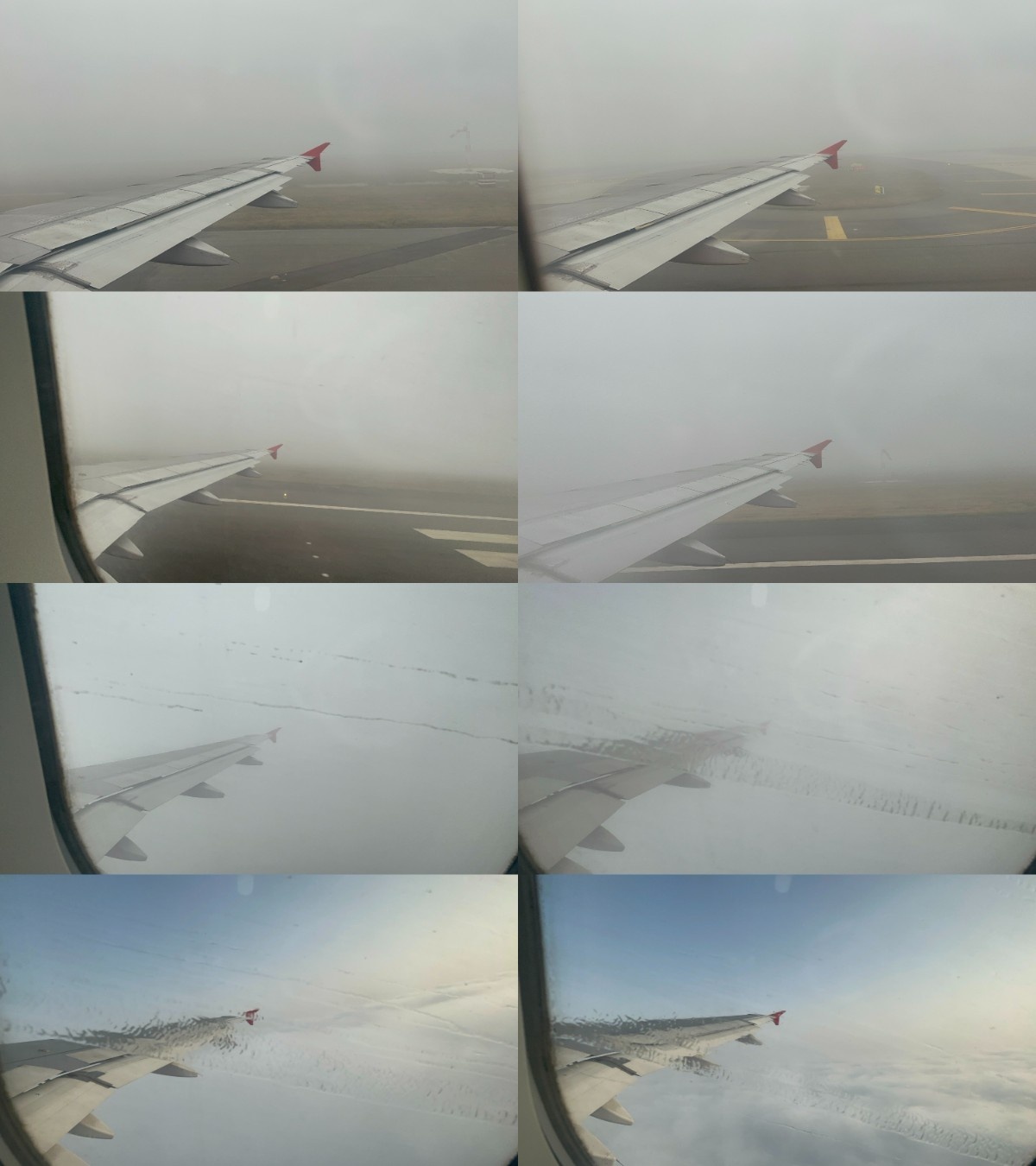
AirFlix streaming IFE and Gourmair hot meals — bravissimo!
One thing that AIX has been wise to carry over from the then-AirAsia India is its streaming IFE system, AirFlix, which was launched in November 2022 — a month before the legal operator was renamed to AIX Connect, around the time I flew the airline for the only time. If you’re willing to stomach a sh*t-ton of Stupid Montserrat — and you must — you’ll appreciate the sheer range of content that few low-cost carriers in India, before or since, have dabbled with.* You can even book airport taxis, in theory at least! There was, however, no sign of the Tata Neu loyalty programme, which was trumpeted widely — particularly on AirAsia India — when it was launched in 2022.
*It’s only now in mid-2024 that IndiGo has dipped its toes into streaming IFE, that too only on the Delhi–Goa route to begin with. Almost five years ago to the day from the date of publication of this report, in September 2019, IndiGo launched a partnership with Indian streaming platform SonyLIV, which was scrapped all too soon — but streaming IFE will hopefully be a part of at least some IndiGo aircraft going forward, as it moves from a true low-cost carrier to more of a global hybrid carrier.
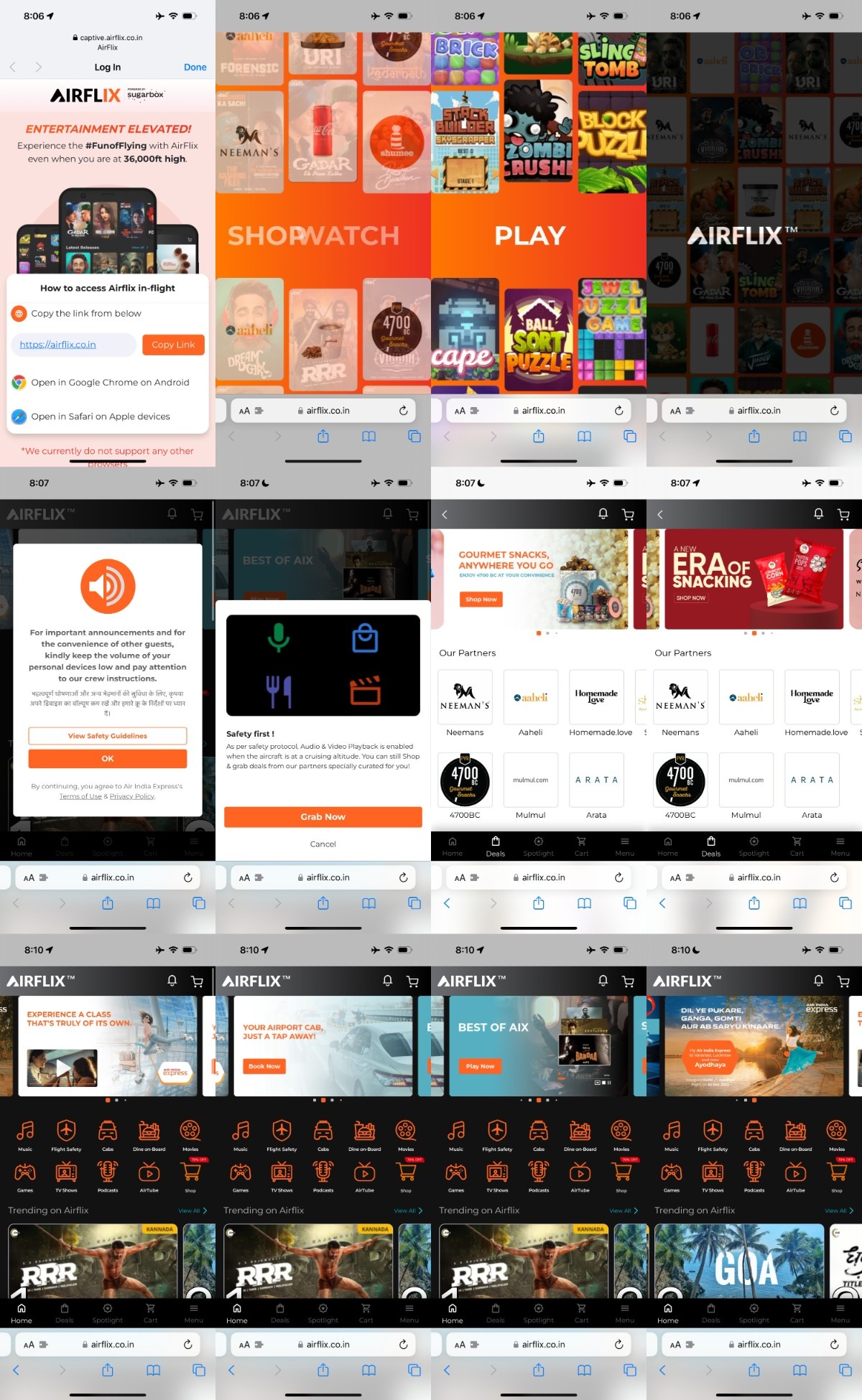
I for one could not have foreseen that there would be so much more on this streaming portal than many full-service carriers have — from its ‘Brand Soniq’ (theme music) to short videos to taxi bookings to even the safety card! Of course I’d expected all this, given that my AirAsia India flight in December 2022 had an enviable collection of shopping products — above all women’s ethnicwear, from sarees to salwar suits — in addition to a bunch of snacks, healthy and otherwise, from up-and-coming new makers.
For the record, parent Air India itself has now (August 2024) launched its streaming IFE system, Vista, which will be fitted across not only its A320s but even — as a temporary stopgap measure — its 777s and 787s, which currently have a woebegone and barely functional seatback IFE offering.The widebody aircraft will have the streaming system until they are retrofitted with new cabins over the next few years, which the A350s already have.

Some 25 minutes after departure, the cabin crew started rolling out the meals. Two girls, Navneet and Anushka, did the rear section of the A320 — where I was seated — and two guys were up front, checking on the girls as and when needed. Being a smart cookie — no pun intended! — I’d pre-ordered my meal during the booking (or, in this case, change-existing-booking) process, and MY GOODNESS was I pleasantly surprised. The main dish was Awadhi chicken biryani with mirch salan, described as follows: (Full resolution here.)
Fit for a royal treat. This Lucknowi Biryani is a delicate take on a pan-Indian favourite, with a unique preparation style from the kitchens of Awadh, where the meat and rice are cooked separately and infused with a rich variety of whole spices. Served with rich piquant chilli gravy.
To go with it were a dessert and a drink: a Choco Banana Cake and a bag — there’s no better word I can find — of Paper Boat’s Swing mango juice. The former was described as:
The fruity sweetness of bananas, perfectly complimented [sic] with the subtle bitterness of chocolate, this soft and moist Choco Banana Cake is a delightful dessert to top-up any meal.
All-in-all, this was a filling, fantastic meal, and not just ‘fantastic for a low-cost carrier’: this was legitimately better than the glop that many full-service airlines — SQ included (at least on intra-Southeast Asia flights) — are guilty of serving! The icing on the cake — again, no pun intended — was the round and bubbly Filson Pro font (a refreshing departure from the omnipresent Montserrat) which had clearly been borrowed in the AirAsia India days from the Malaysian airasia‘s Santan buy-on-board menu. Long may the friendly Filson live in this heavily Montserratised airline!
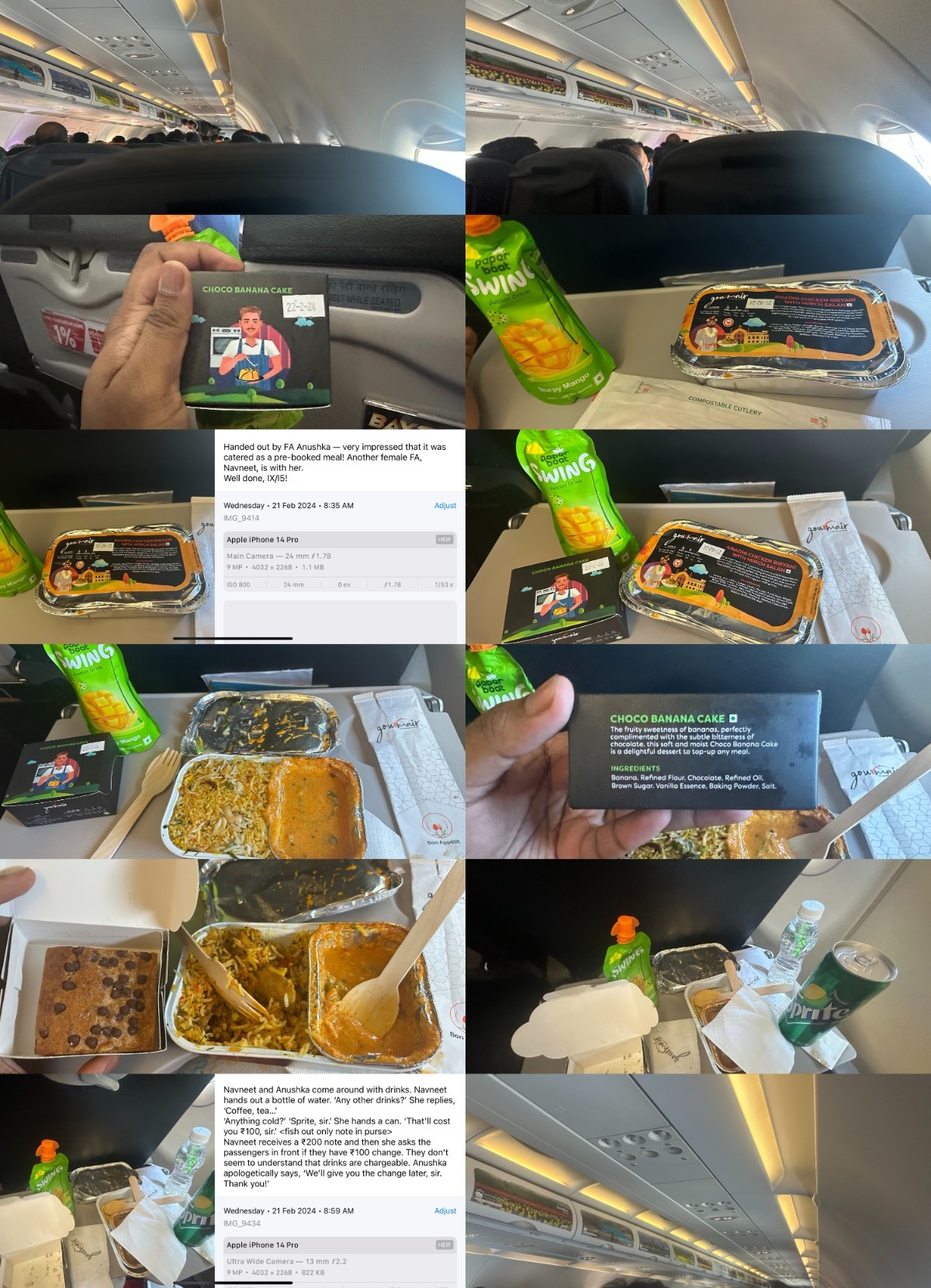
I’d also written a small note (last row above) about a funny interaction with Navneet when she was handing out the drinks for purchase — not that it was necessary in any way since one already came along with the meal. When I handed out a ₹200 note for a ₹100 drink, she asked the other passengers for ₹100 in change, but most of them were unaware that these drinks needed to be bought (this was an LCC, after all) — leading to some embarrassment. The other FA, Anushka, was very apologetic and said that she would provide the change later, which she did, so credit to her!
Away from the foggy north, descending into the sunny south
The rest of the flight, as you might expect on an LCC, was more or less uneventful save for the little jocular incident above. It seemed as though the flight had barely started, but we were over two hours in when we commenced descent, and the white carpet of clouds began to give way to the brown of the Deccan Plateau.

I used all this spare time to write — or should I say decorate — my journal entry for the flight, headlined ‘A flight with two numbers. A plane with two identities’! I zoomed in on the Tim Hortons bit, which seemed to cheer up a bit of the ‘DELsappointment’.
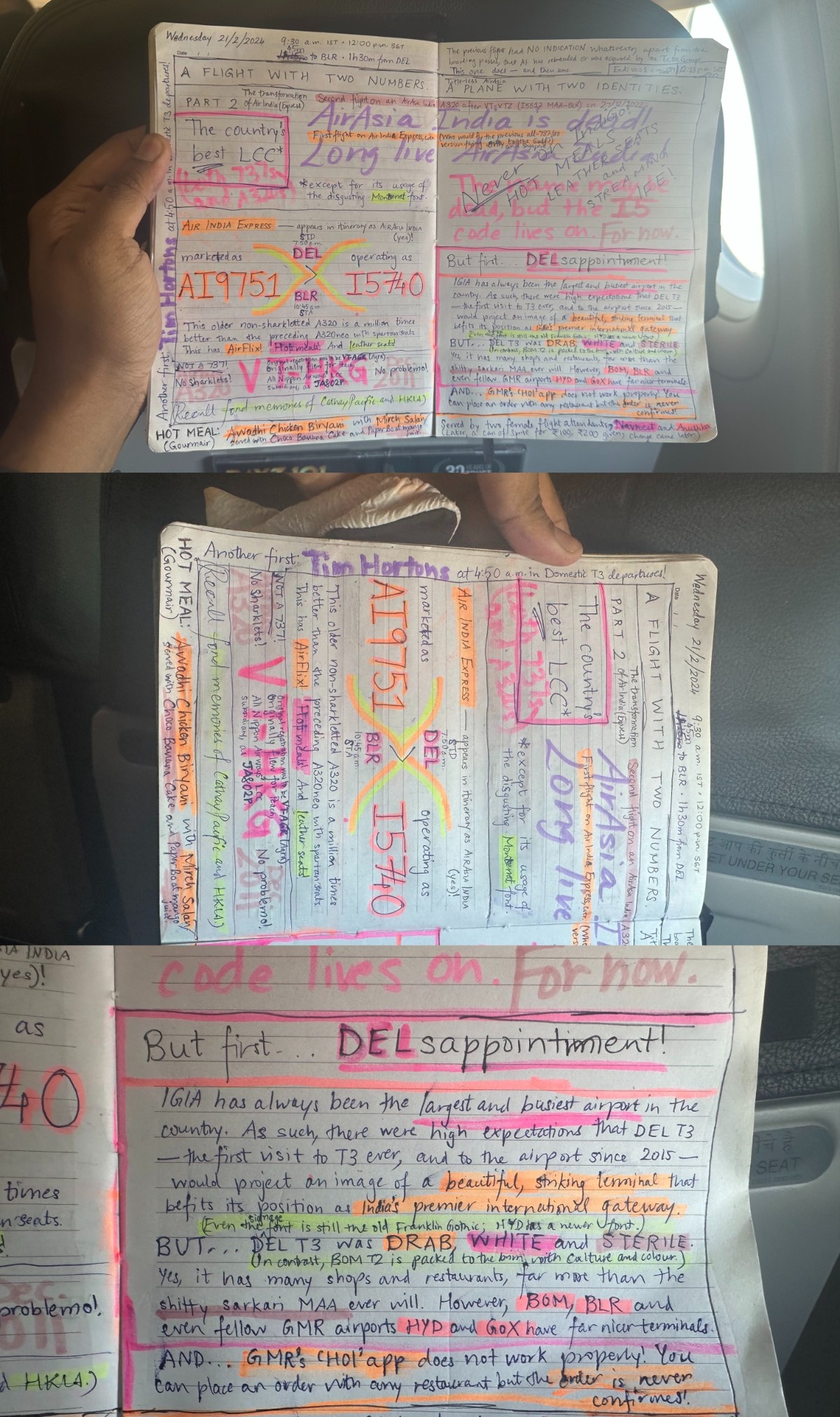
At 10:20 IST the brown and green fields of Devanahalli, the village where Kempegowda Airport is located, came into view — as much a sign of landing at BLR as ships are of Changi, or palm plantations of KUL. The non-sharkletted A320 — far superior than the Air India A320neo before it, a few hours before, in the dark of night — made a smooth landing shortly thereafter, and it immediately became apparent that I had some exotic visitors for company. The most noteworthy were the Lufthansa 747-400 (D-ABTK) and the Ethiopian 737 MAX 8 (ET-AWK) I’ve pinpointed below.
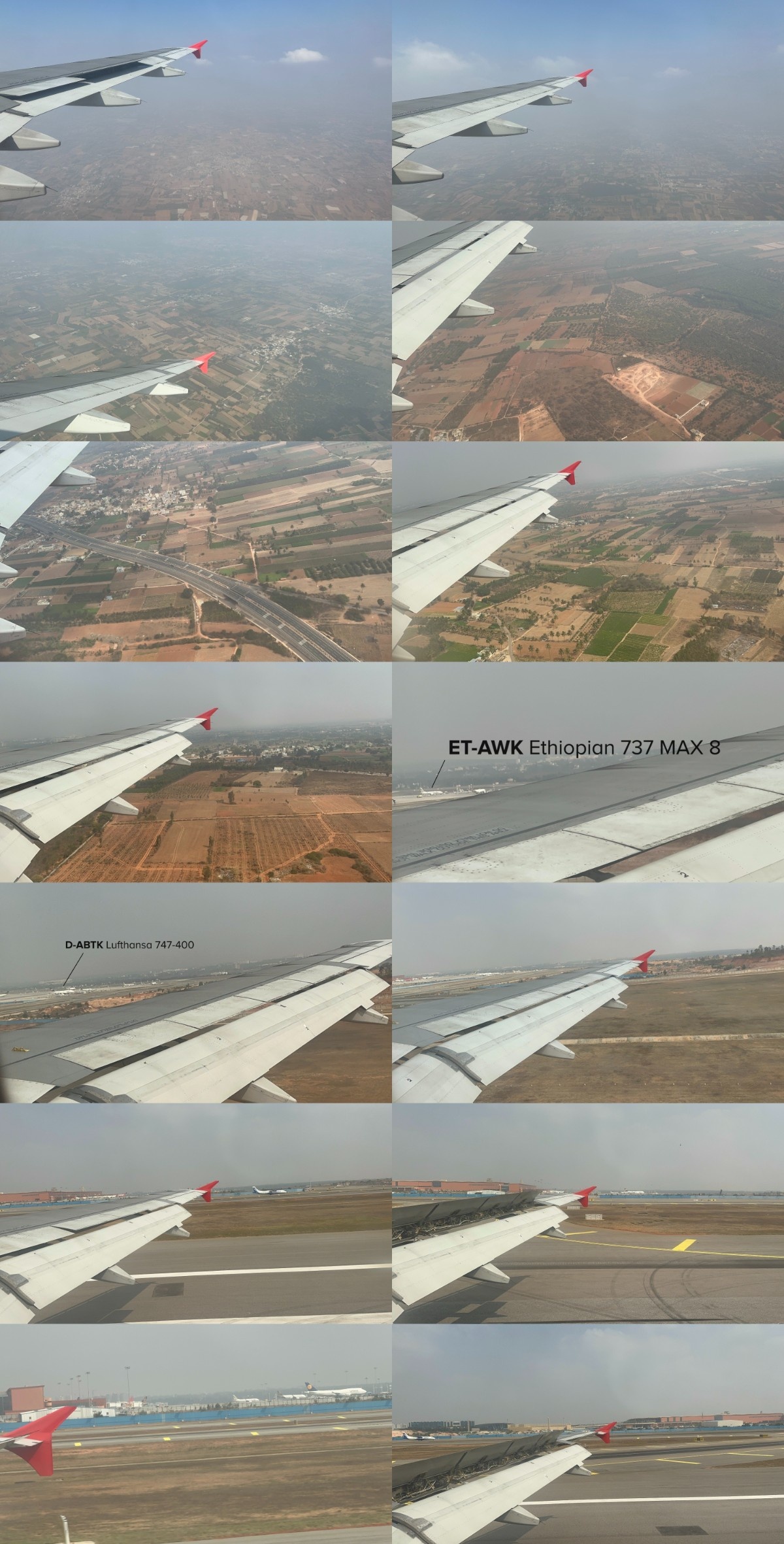
At the same time, 9V-SHV — the selfsame A350 that I’d flown on 2 January as SQ191 from Hanoi, on the same day as the JAL A350 collision-crash — touched down as SQ508. (Notice the uncanny tail of a JAL A350 just behind the SQ aircraft?)
Other non-VT arrivals included Saudia’s A330-300 HZ-AQ22 as SV866 from Jeddah, Emirates’ 777-300ER A6-EPA as EK564 from Dubai and, on the cargo front, AeroLogic/DHL’s 777F D-AALR as part of a Singapore–Bangkok–Bengaluru rotation before returning to its home of Leipzig/Halle (LEJ) in eastern Germany.
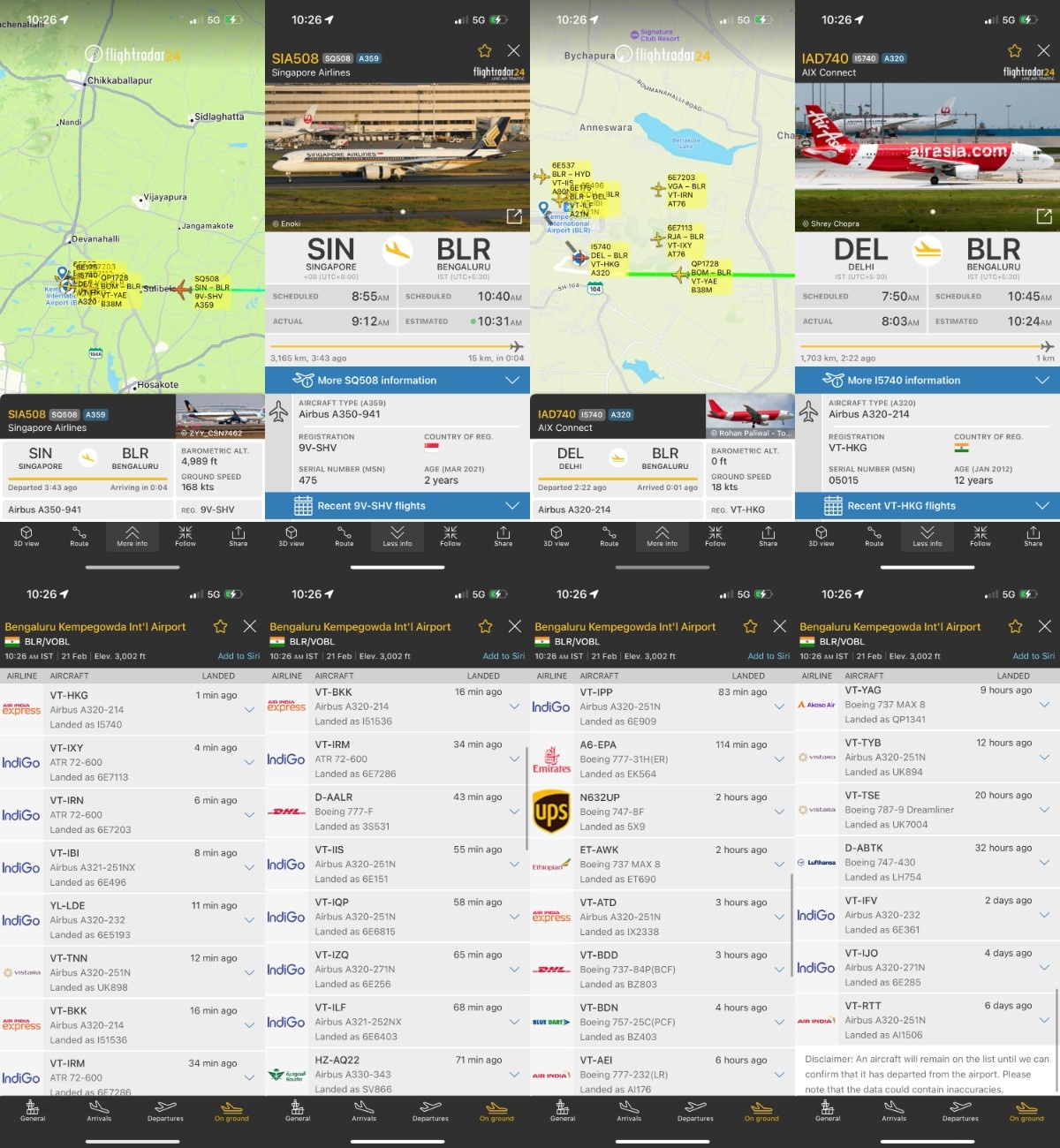
Now, as seems to be the norm for domestic Indian flights, we chugged all the way to a remote stand, giving me magnificent views of the majestic December 2001-vintage Lufthansa 747-400, D-ABTK, and the much newer 737 MAX 8 (June 2022) of its African Star Alliance partner. That a 747-400 should have as long a run as this one — in the much more iconic old livery with the crane on a yellow disc — was a treat in itself. I could not resist snapping away at the Queen of the Skies as much as I could. Who wouldn’t, given the opportunity?
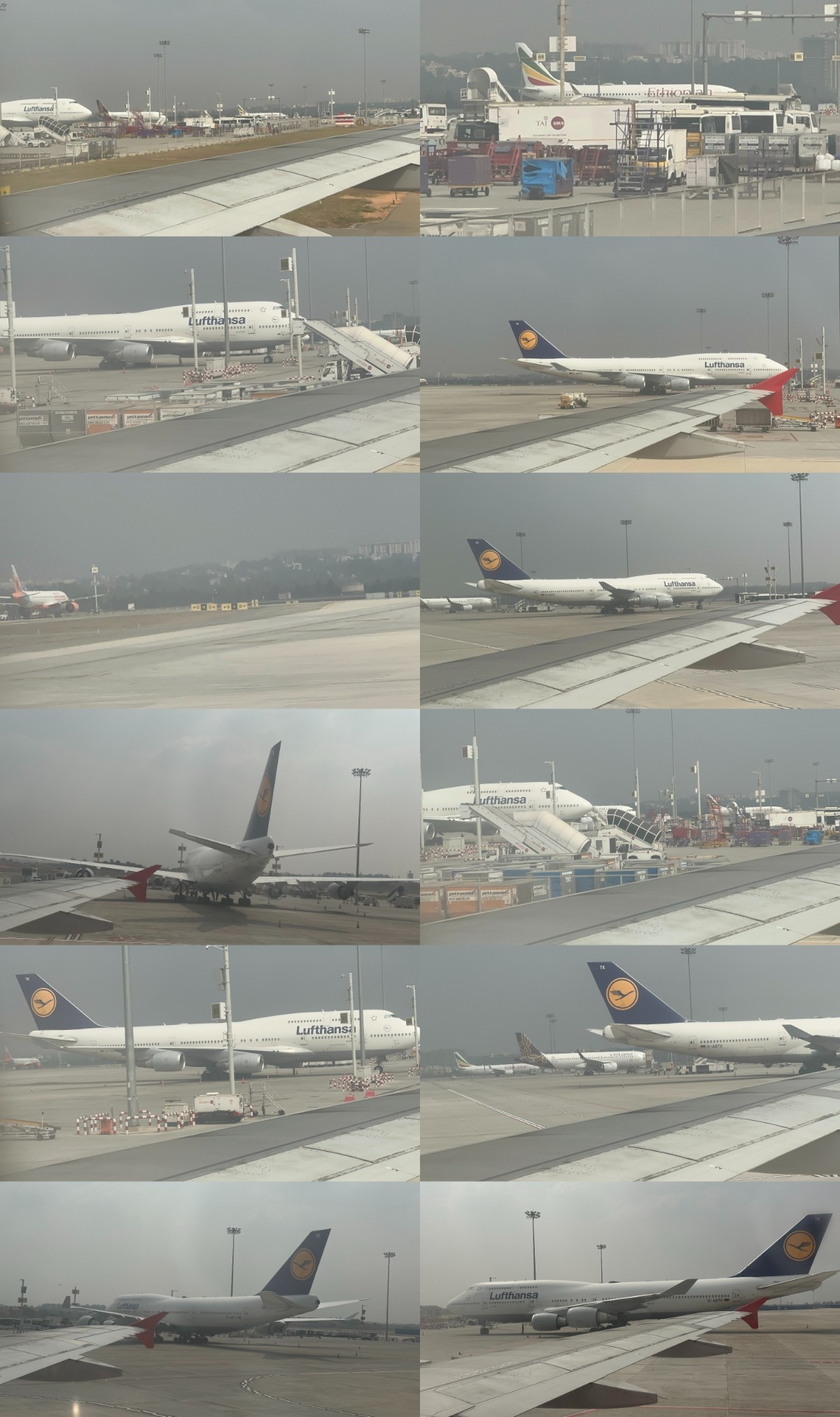
Here are some sexy rear-angled vertical takes of D-ABTK, as well as VT-TYC, a just-arrived all-economy Vistara A320neo — all while 9V-SHV had just touched down.

I disembarked from VT-HKG, but not before having a small chat with the natty, spiffy male flight attendant at the front (I forget his name) wherein I commended the fact that this was one of the very rare opportunities to get a hot meal on an Indian low-cost carrier. He replied that it was highly unlikely that ‘the others’ (viz., IndiGo) would do the same — even if the newcomer Akasa Air was experimenting with its snacking options!
Bidding the guys, Navneet and Anushka farewell and thanking them for their friendly fun service, I stepped off the plane and onto — for a change — the hard tarmac and into an airport bus, which for me is a rarity (outside Kuala Lumpur’s Satellite Terminal). There was no way in hell I’d be missing an opportunity like this to catch these planes up close — not only the LH 747-400 but also VT-ATD, then the sole A320neo in the AIX livery, as posted at the beginning of this report!
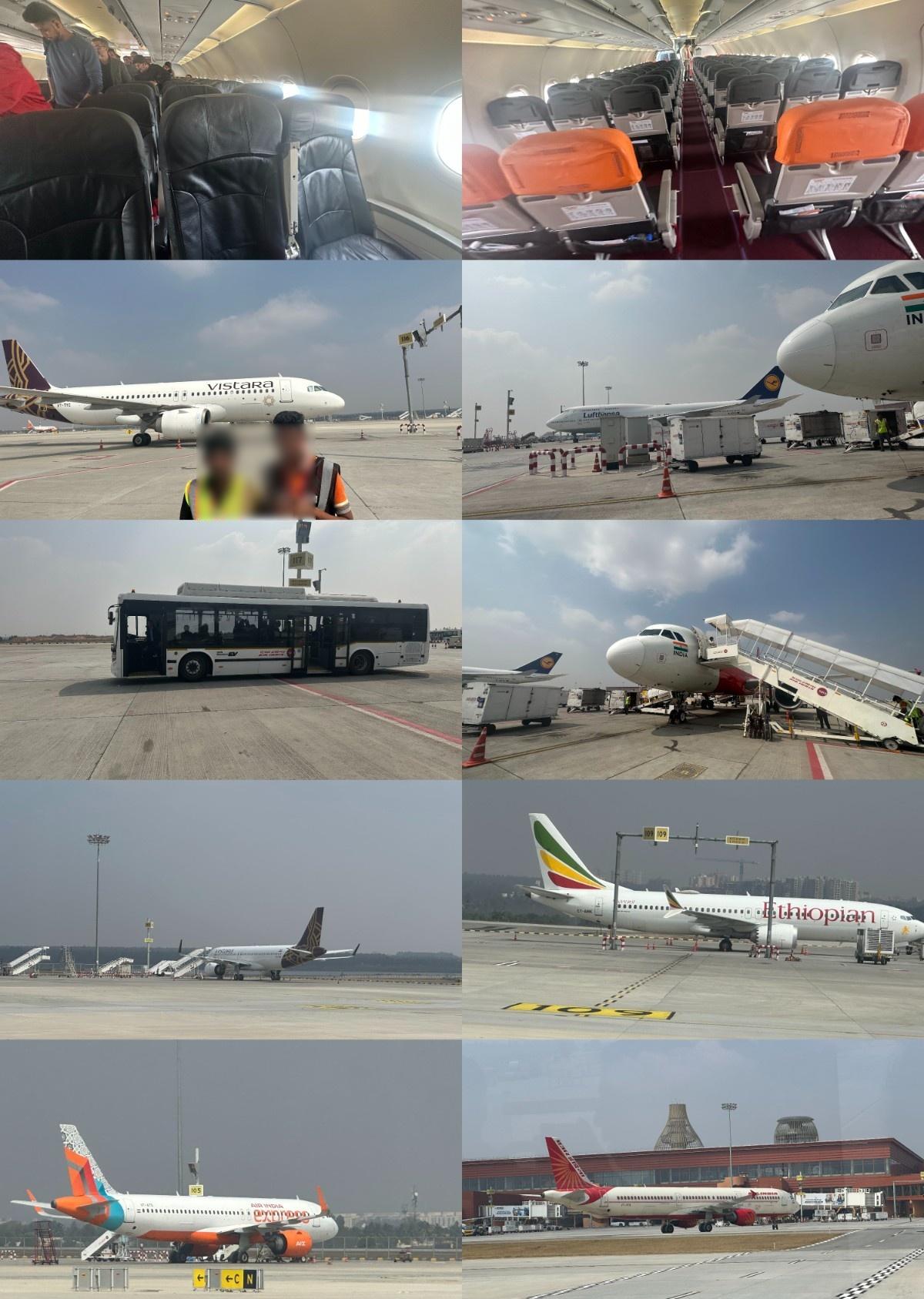
The bus turned a bit, heading left into the new Terminal 2 building, as the parked Saudia A330-300 (HZ-AQ22) came into view with the EK 777-300ER (A6-EPA) having landed. More Lufty 747-400 closeups, more shots of my ‘plane’ red A320 from a distance, and at one point even VT-TNN — the all-economy A320neo on which I’d had my first Vistara flight (UK893, BLR–HYD) at the fag end of 2022.
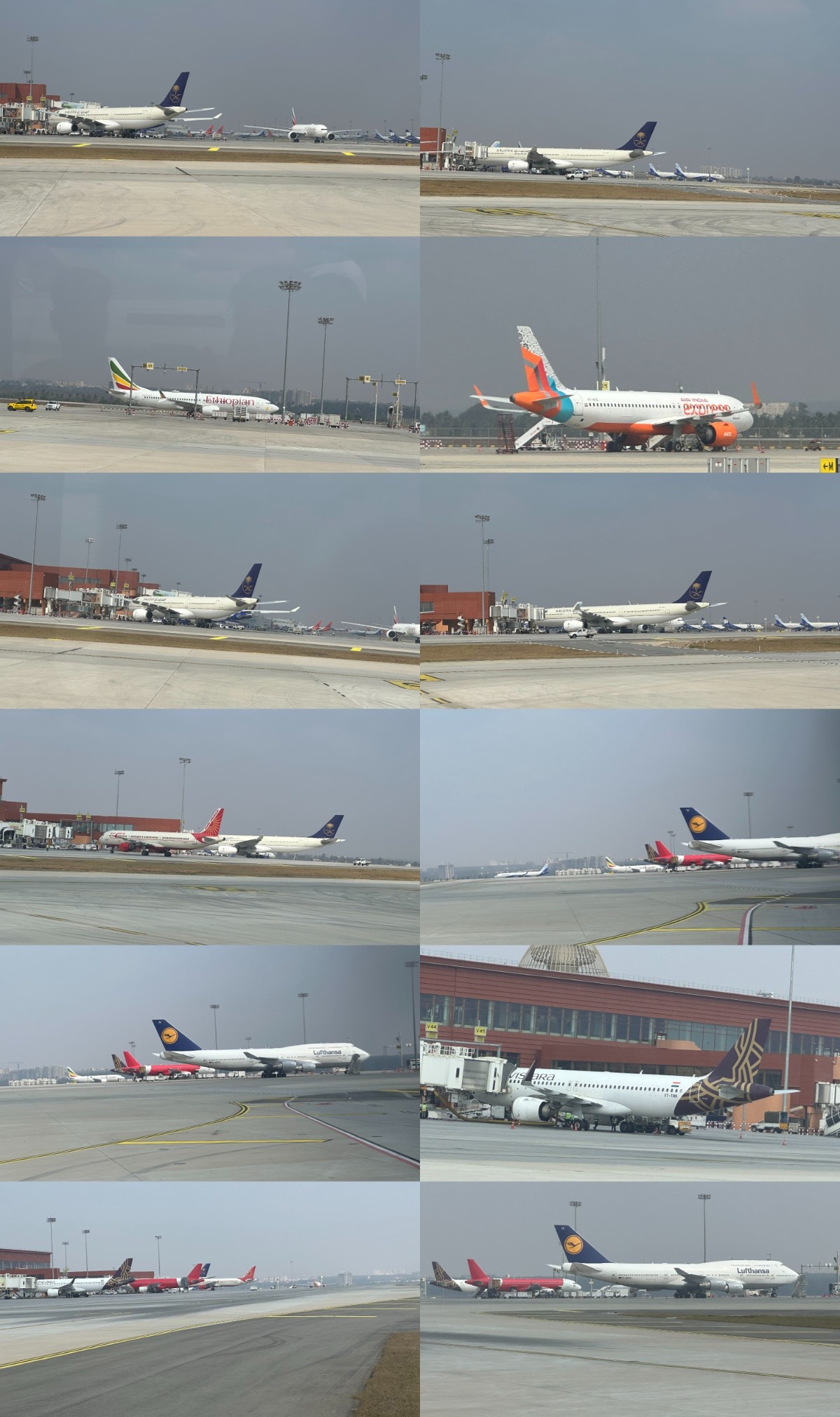
At length we reached the new terminal building and stepped down from the bus onto the tarmac, and stepped into the terminal which was even more wondrous still.
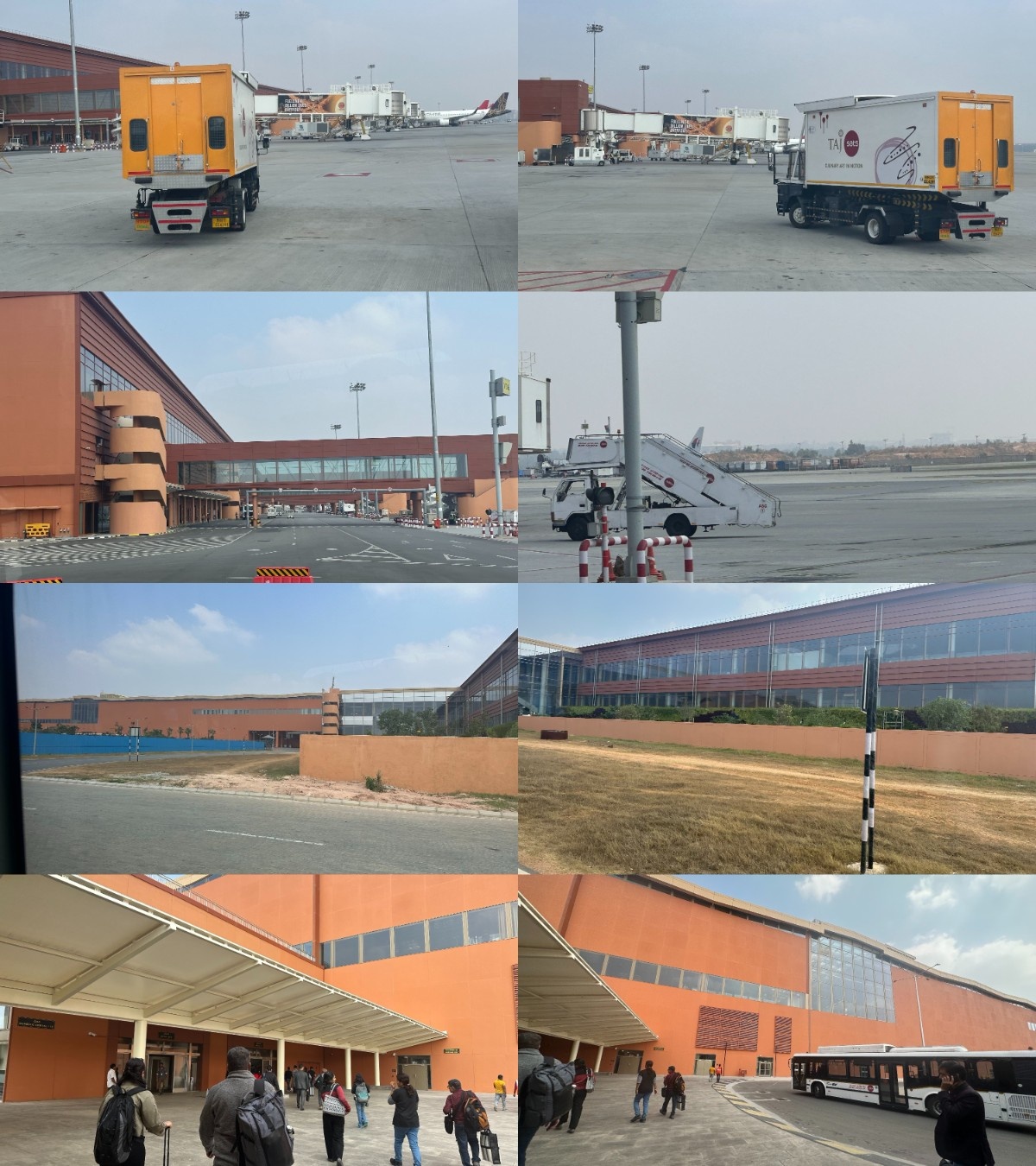
BLR Terminal 2 Domestic Arrivals: A many-splendoured thing
The difference between the grey drabness of DEL T3 and the grandiloquent splendour of BLR T2 is STARK, to put it in the mildest possible way. One look at the ceiling lights and ethnic art and you likely won’t cast a second glance at DEL again — certainly not as long as you’re reading this report.
Not to mention, Virgin Atlantic Airways was promoting its new BLR service, which was all well and good, but my only question was ‘WHERE IS THE SKYTEAM LOGO???????’ Air France–KLM and their British partner have been greatly downplaying their alliance membership lately; in fact, VS does not have a single aircraft in alliance livery. I’m afraid SkyTeam’s newest joinee, Scandinavian Airlines (SAS) — which had been in the Star Alliance from day one (14 May 1997) until 31 August 2024 — may very well do the same.
In any case, BLR is now served by four SkyTeam members including Saudia above, whereas neighbouring Chennai (MAA) now has zero, with Air France having axed Chennai service — popular though it was — at the end of March 2024, and Saudia still not seeing fit to make a comeback to that lousy state-run airport. Good riddance!
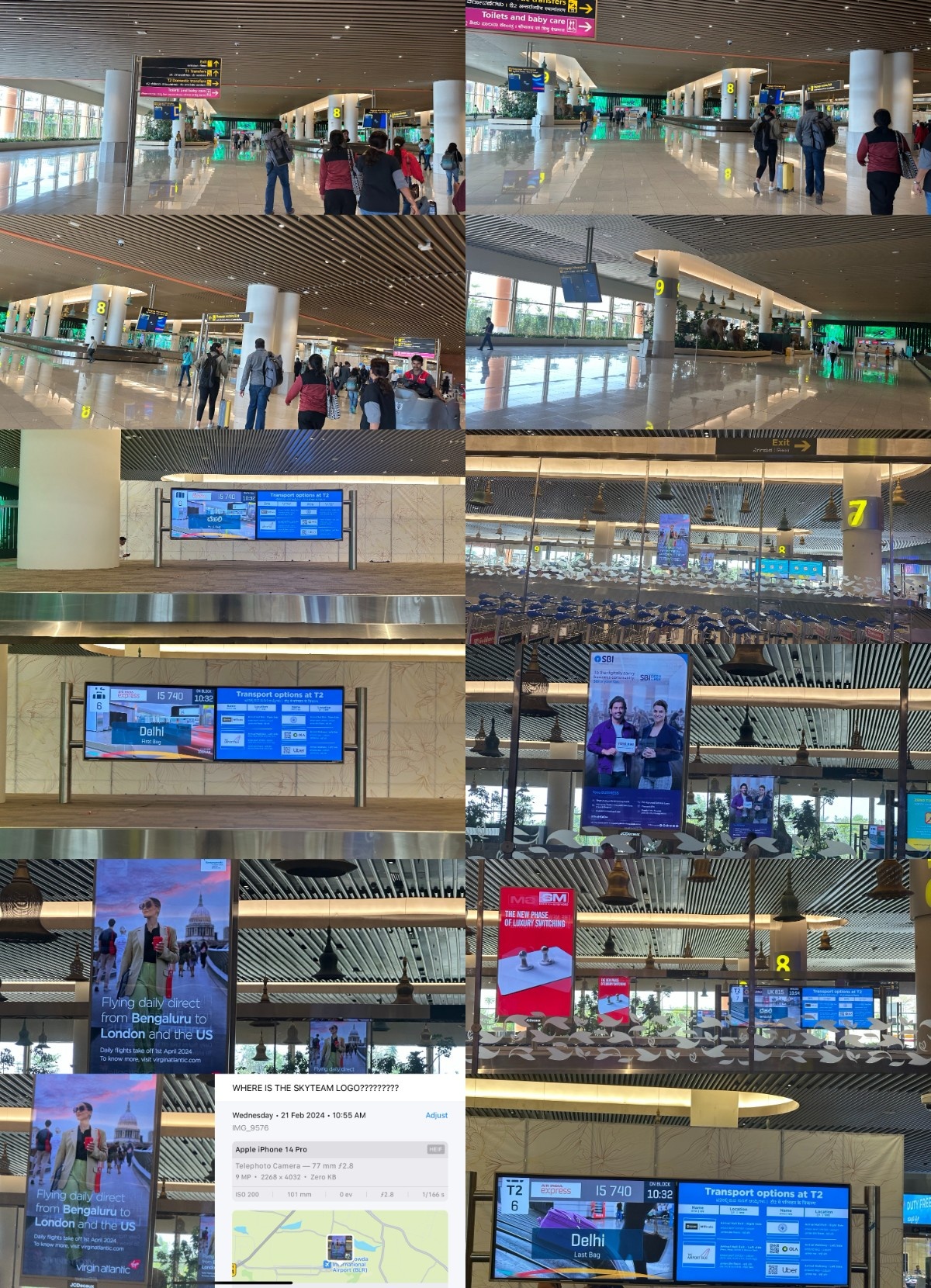
I proceeded past the intricacy of the wildlife art that adorned the huge screens behind, and onwards to the exit…
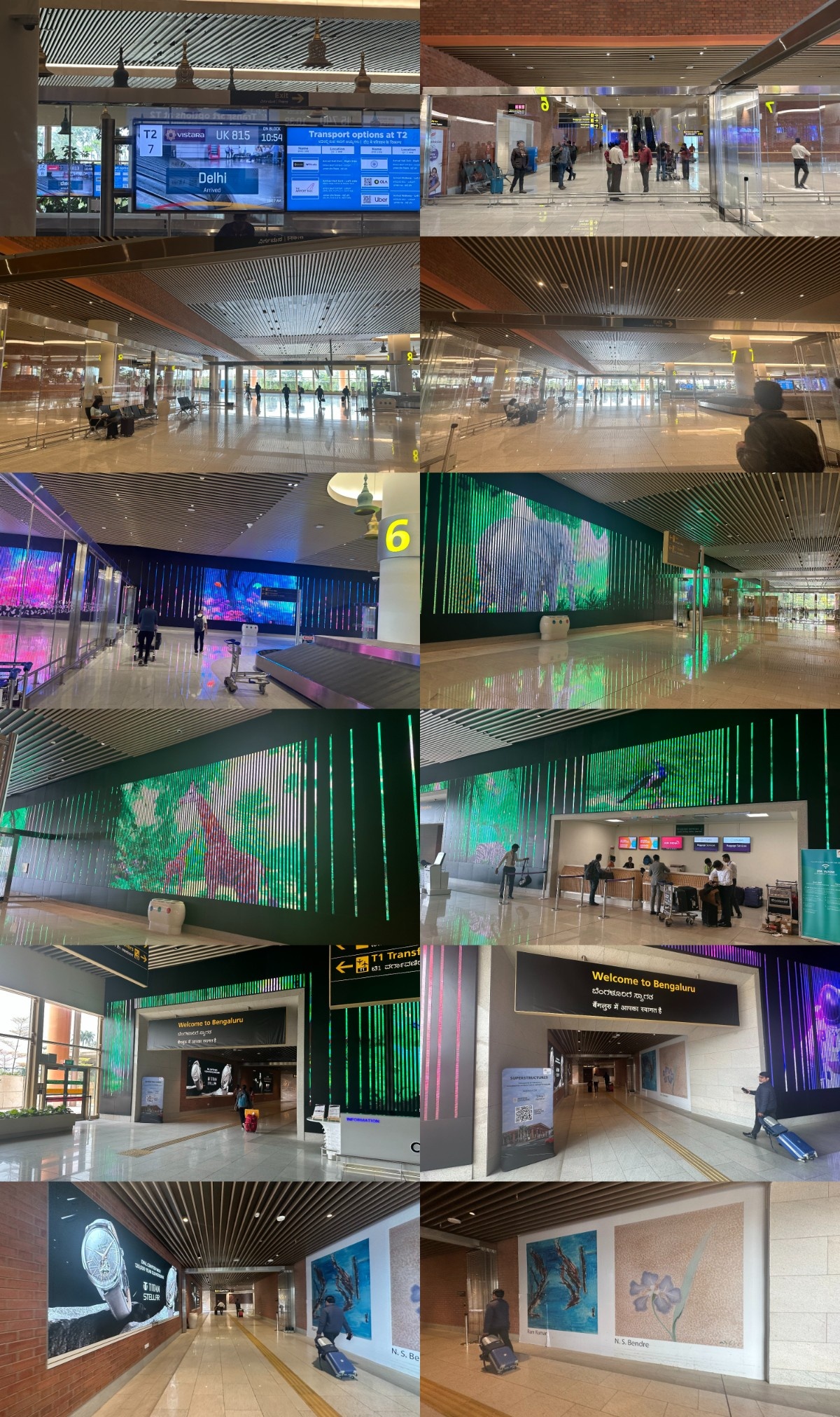
…but not before passing by the 080 Café, a picture of regality by itself, as well as the under-construction 080 Arrivals Lounge. (080 is BLR’s brand for its own luxurious establishments, named after Bengaluru’s trunk dialling code; I’d stayed in the 080 Transit Hotel in Terminal 1 back in June 2022.)
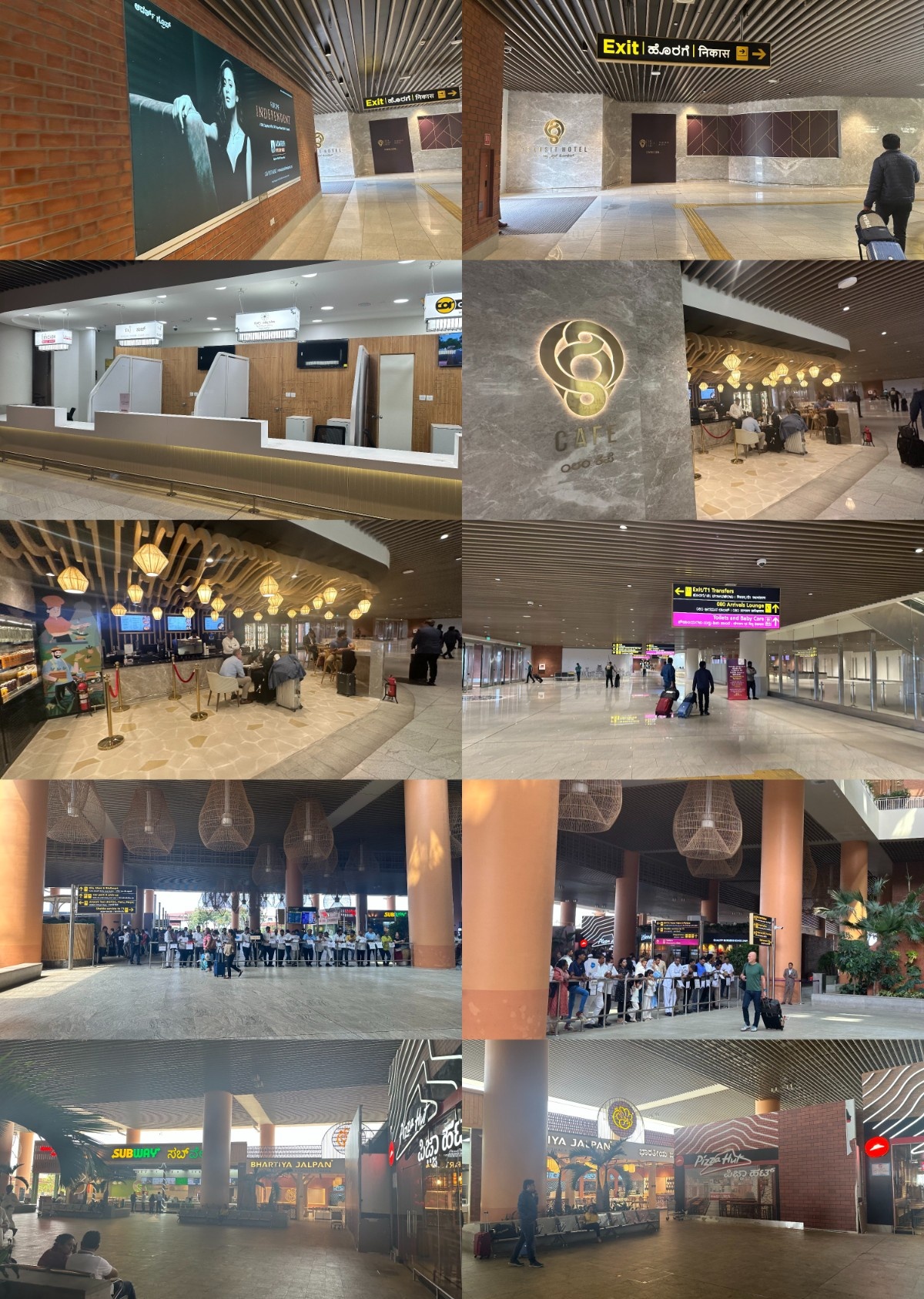
Once into the windy, somewhat cold arrivals portico, I headed straight and unblinkingly to Wendy’s, the American fast-food chain that has started to take root in India — though not to the extent of Tim Hortons! — but is nowhere to be found in Southeast Asia. This was maybe the second time I was seeing one, the first being at the same place two months before — and at a similar time of day, having arrived on a Vistara A320neo from Mumbai in Premium Economy.
Over there, I ordered some sort of chicken wrap as a takeaway, and I knew from the aroma in the kitchen (never mind the branding!) that it was going to be, if nothing else, delicious. With this in one hand, and my suitcases on a trolley in the other, I proceeded to the lower parking level, where my pre-booked cab from MakeMyTrip would arrive.
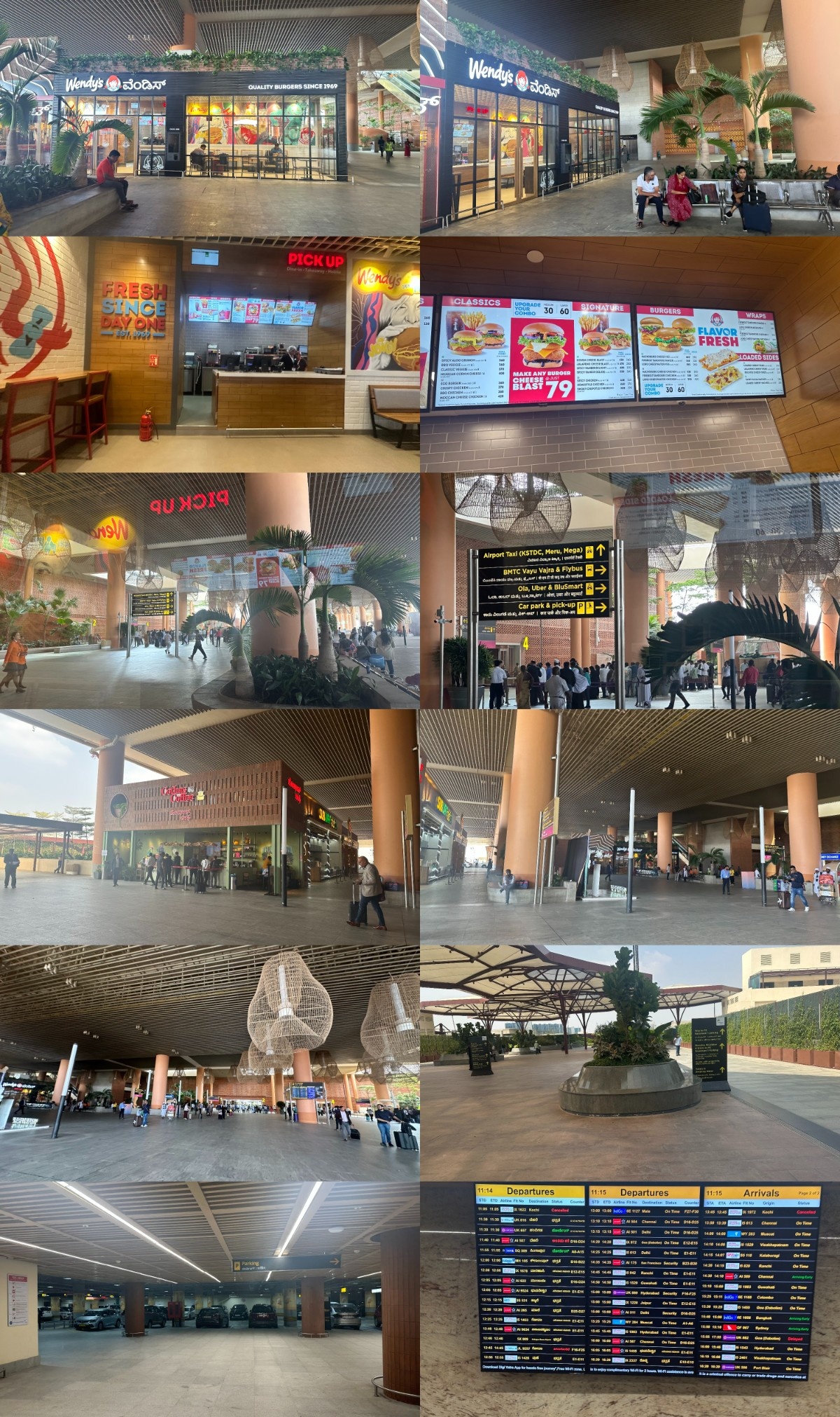
Now it was time to text my parents, and this is what I’d written in Bengali in praise of Air India Express.
I have only one belief: ‘Those who fly nothing but IndiGo will never be able to imagine delights such as hot foods on a plane.’
To which my mother replied, ’Nothing happens for free! Air India always provides food; IndiGo always prefers the bare minimum.’ Can’t disagree with that!
Around this time, Malaysia Airlines’ 737-800 9M-MXA had arrived as MH104, which I found to be interesting because (a) I didn’t know that MH, like SQ, had launched a morning service to BLR, with the usual night flight to BLR being MH192 — I flew their A330-300 (9M-MTH) on MH180 to Chennai in October 2022, shortly before they made all South Indian flights 737-only — and (b) 9M-MXA was no longer in the retro-red ’40 years of Malaysian Airline System’ livery that she’d been sporting for over a decade.
Now, however, I’ve gotten rid of my anti-737 sentiments, and in June 2024 I took the bold step of flying an MH 737-800 (9M-MXJ) from Kuala Lumpur to Johor Bahru (JHB) near Singapore. It was, in a nutshell, a cathartic release. More on that some other time!
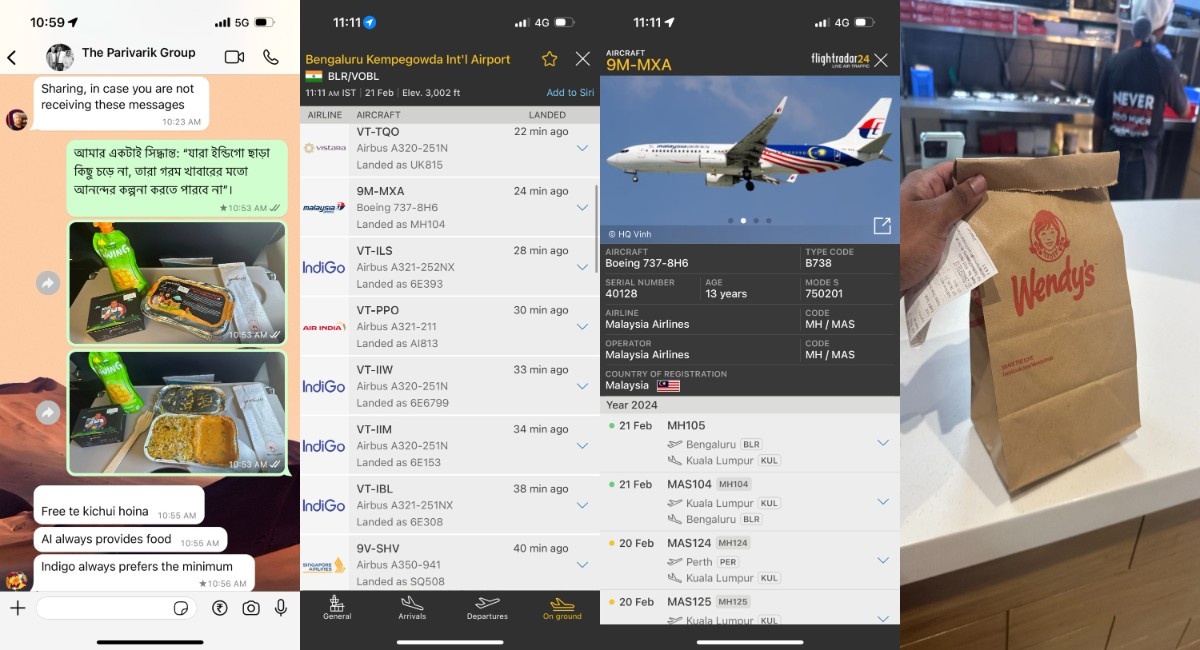
It had been a bit confusing for the electric car, a Tata Tigor sedan, to locate me — this was not the usual Ola/Uber pickup point — but at length he did, and we sped out into the warm spring sunshine, and south into the city. Besides the Virgin Atlantic service, there were billboards for Range Rover and a baby’s picture for Apple’s ‘Shot on iPhone’ campaign. Ah, those little Indian things, like hoardings, that Singaporeans miss!

I tucked into my Wendy’s chicken wrap just as VT-TNN, she of the all-economy cabin, took off as UK509 for the domestic island destination of Port Blair (IXZ) — which, as it turns out, has now received its first international flight in ages, on AirAsia Malaysia from Kuala Lumpur, with service commencing from 16 November 2024. Will this survive, or will it collapse like the airline’s previous short-lived attempt of flying from Johor Bahru to Kolkata, in eastern India, in late 2017?
In any case, this only adds to the Malaysian LCC’s burgeoning Indian network, which now has absolutely nothing to do with its erstwhile Indian offshoot as the latter finally takes baby steps beyond its Gulf and Singapore stronghold.
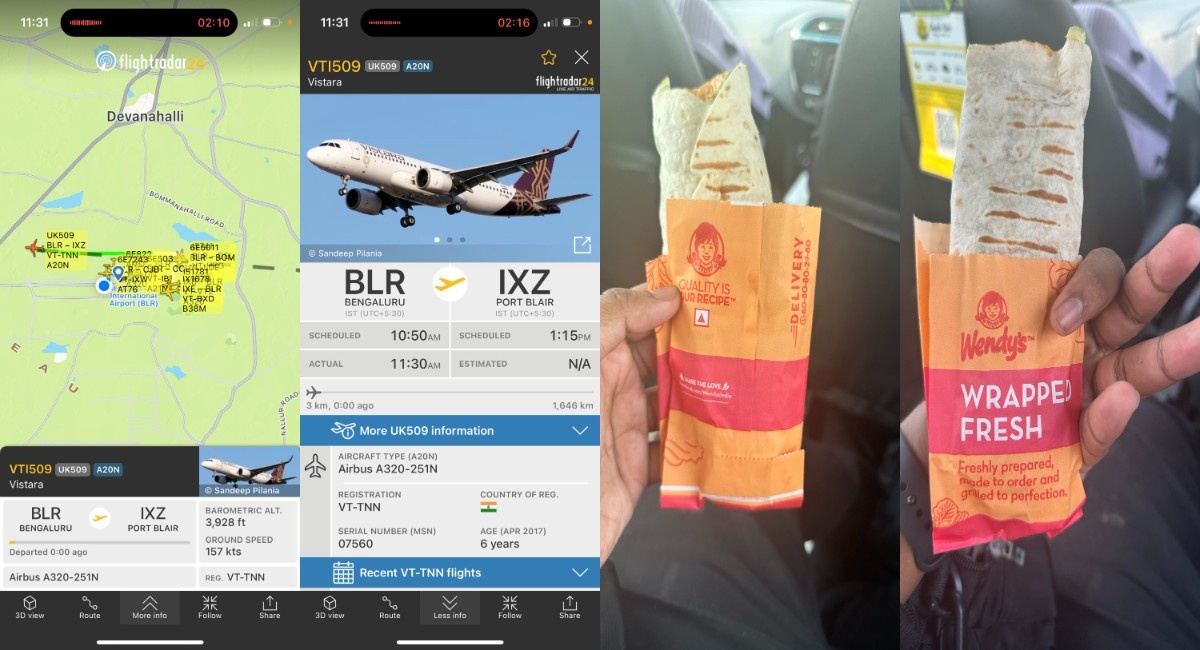
A whole bunch of other hoardings welcomed me home to Bengaluru, but I wouldn’t be going home right yet; instead — and you can guess from my previous reports that I’m a mall person — I’d be heading to the spanking-new Phoenix Mall of Asia* in northern Bengaluru, a bit of distance from the airport that lies to the northeast. But this time I’m NOT going to post any pictures from the place, luxurious though it was, because there’s only so many times it’s worthwhile to post a bunch of expensive shops and restaurants!
*I doubt Filipinos will be very happy with this choice of name, given that SM Mall of Asia in Pasay City — one of the world’s biggest malls — has been around for nearly two decades… about as long as IndiGo and Air India Express themselves!
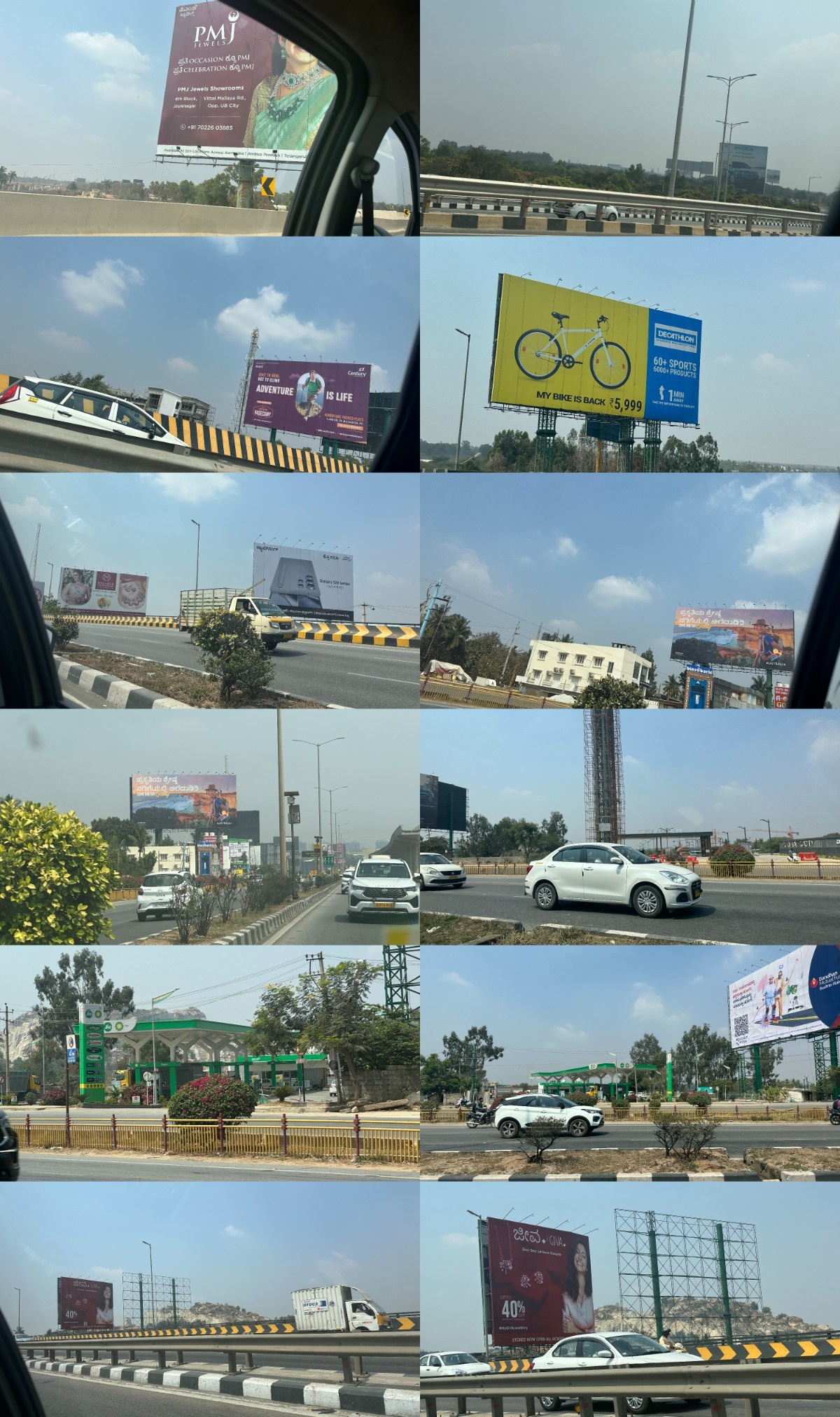
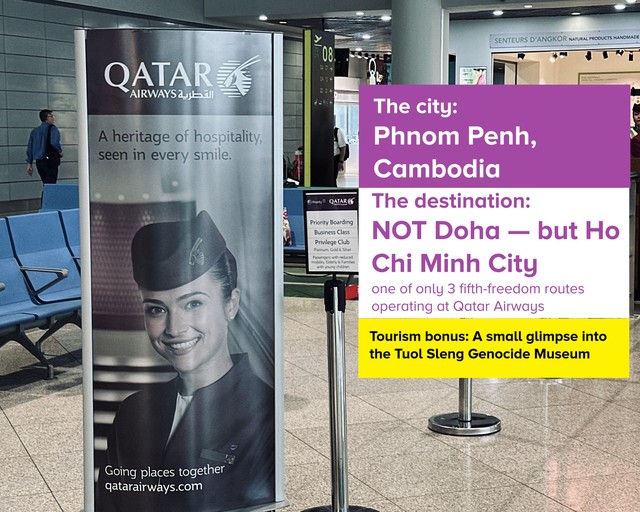
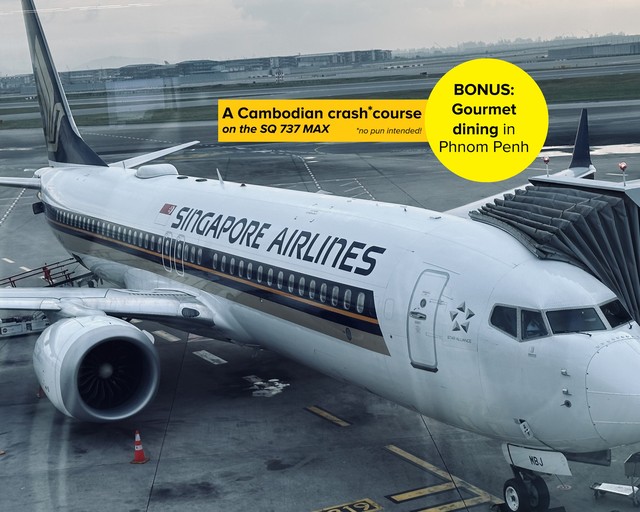
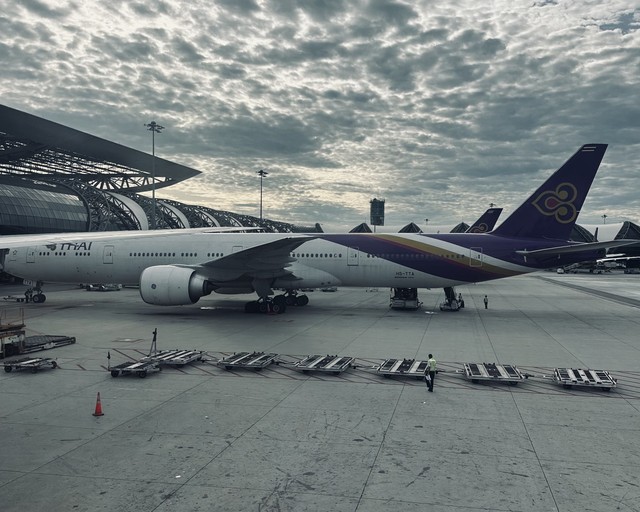
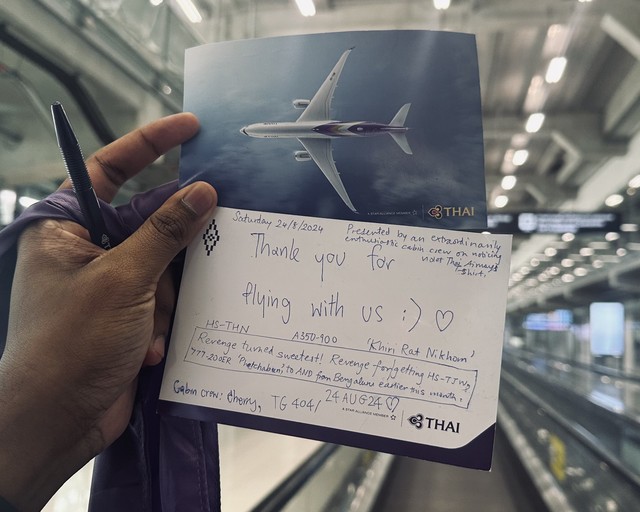
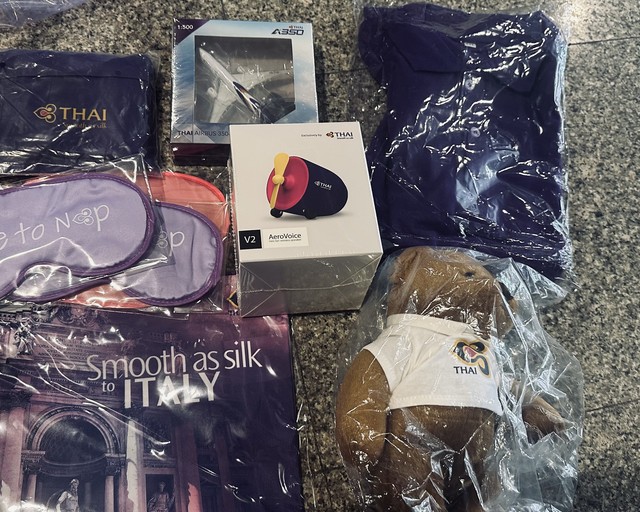
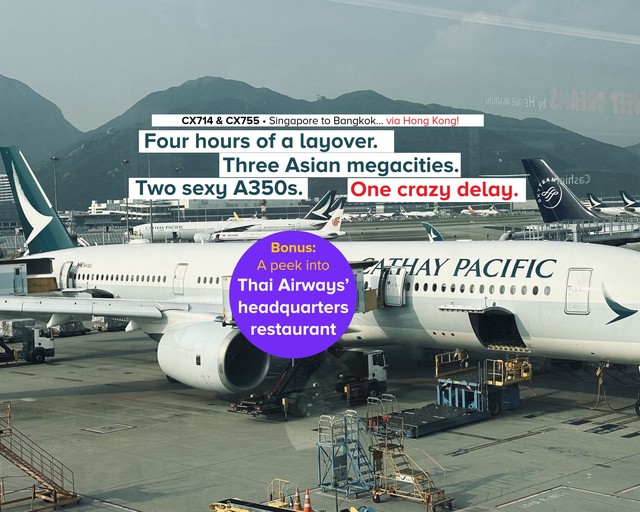

Great review! I flew AIX last year and I was very impressed by them, I agree that they're far, far better than IndiGo and that was without trying any food, looks like their catering is also much better than 6E. The free bottled water is a nice touch and I'm glad to see it wasn't just a one-off thing that I got lucky with on my flight with them, and the IFE is great considering even Air India doesn't have that on most flights yet.